Water Entities: Results of the 2013–14 Audits
Overview
This report covers the results of our financial audits of 20 entities, comprising 19 water entities and one controlled entity. The report informs Parliament about significant issues arising from the audits of financial and performance reports and augments the assurance provided through audit opinions included in the respective entities’ annual reports.
Parliament can have confidence in the water entities financial reports and performance reports as all were given unmodified audit opinions for 2013–14. It is pleasing to note that both financial reports and performance reports met the legislated time frames and improvement has occurred in the quality of performance reporting during 2013–14.
The sector generated a net profit before income tax of $318.2 million, an increase of $234.5 million. The increase is largely due to two metropolitan water entities reporting significantly higher profits as a result of higher water consumption and increased water, sewerage and other prices, as approved under the regulatory price setting model.
This report highlights some key financial challenges and risks for the water entities, including repaying growing debt and continuing to meet ongoing financial obligations to the state, such as taxes and levies. It also highlights significant increases in total water and sewerage charges by the three metropolitan water retailers in 2013–14.
Water Entities: Results of the 2013–14 Audits: Message
Ordered to be printed
VICTORIAN GOVERNMENT PRINTER February 2014
PP No 5, Session 2014–15
President
Legislative Council
Parliament House
Melbourne
Speaker
Legislative Assembly
Parliament House
Melbourne
Dear Presiding Officers
Under the provisions of section 16AB of the Audit Act 1994, I transmit the Auditor-General's report Water Entities: Results of the 2013–14 Audits.
This report summarises the results of the financial audits of the 19 water entities and one controlled entity for the year-ended 30 June 2014.
It informs Parliament about significant issues arising from the audits of financial and performance reports and complements the assurance provided through individual audit opinions included in the respective entities' annual reports.
The report also highlights the sector's financial results and financial sustainability risks.
Yours faithfully
Dr Peter Frost
Acting Auditor-General
12 February 2015
Auditor-General's comments
 John Doyle Auditor-General |
Audit team Roberta Skliros—Engagement Leader Jenneth Garcia—Team Leader Jie Yang—Team Senior Jessica Cross, Richard Ly and Steven Zanetti—Team members Engagement Quality Control Reviewer Craig Burke |
Victoria's water industry includes 20 public sector entities, comprising 19 water entities and one controlled entity. These entities are stand-alone businesses that are expected to adopt sustainable management practices, which allow water resources to be conserved, properly managed, and sustained.
Parliament can have confidence in the water entity financial reports and performance reports as all were given unmodified audit opinions for 2013–14. It is pleasing to note both financial reports and performance reports met the legislated time frames and improvement has occurred in the quality of performance reporting during 2013–14.
The sector generated a net profit before income tax of $318.2 million, an increase of $234.5 million. The increase is largely due to two metropolitan water entities reporting significantly higher profits as a result of increased water, sewerage and other prices, as approved under the regulatory price setting model, higher water consumption, and a reduction in refunds to customers because of the desalination plant.
The three metropolitan water retailers increased their total water and sewerage charges to customers by $474.9 million during 2013–14. However, they had increased costs of approximately $490 million for bulk water, sewerage and other charges they pay to the system's wholesaler, that is Melbourne Water. Both increases are a consequence of higher regulated prices and water consumption. Melbourne Water also had cost increases, such as a $178.3 million increase in finance costs, mainly because of the first full year impact of the desalination plant. Nevertheless, it reported a net profit before income tax of $131.9 million, an increase of $193.5 million on the prior year net loss.
While the three metropolitan water retailers increased their total water and sewerage charges by 25.5 per cent in 2013–14, the 13 regional urban water entities had an increase of 3.5 per cent, and the two rural water entities combined, declined by 3.1 per cent.
The water sector is facing increased financial sustainability risks given the five-year trend to 2013–14. Three entities had high financial sustainability risks and ten entities had medium financial sustainability risks in 2013–14. Some of these risk ratings are partly a consequence of the regulatory price setting model, where there is a shortfall between the price set and the total operating costs of some entities. I intend to take a closer look at the regulatory price setting model in the future.
Other key financial challenges for the water entities include repaying growing debt and continuing to meet ongoing financial obligations to the state such as taxes and levies. The depth and breadth of debt refinancing is another area I plan to assess more closely in future reports.

John Doyle
Auditor-General
February 2015
Audit Summary
This report covers the results of the 2013–14 financial audits of 20 entities, comprising 19 water entities and one controlled entity.
It provides an analysis of their financial and performance reporting, financial results and financial sustainability risks. It also comments on the effectiveness of general internal controls, the operations of audit committees and the management of gifts, benefits and hospitality.
Conclusions
Parliament can have confidence in the adequacy of financial and performance reporting of the water entities for the year-ended 30 June 2014.
Unqualified audit opinions were issued on the 20 financial reports, which means the audited financial information fairly presents the entities' transactions and cash flows for the 2013–14 financial year, and their assets and liabilities as at 30 June 2014.
Unqualified audit opinions were also issued on all 19 performance reports, which means that the audited information fairly presents the results against the specified performance indicators for the 2013–14 financial year. The controlled entity does not prepare a performance report.
The water sector is facing increased financial sustainability risks given the five year trend to 2013–14. Three entities had high financial sustainability risks and 10 entities had medium financial sustainability risks in 2013–14. Some of these risk ratings are partly a consequence of the regulatory price setting model, where there is a shortfall between the price set and the total operating costs of some entities. We intend to take a closer look at the regulatory price setting model in the future.
Key financial challenges for the water entities include repaying growing debt and continuing to meet ongoing financial obligations to the state such as taxes and levies. The depth and breadth of debt refinancing is another area we plan to assess more closely in future reports.
Parliament can have confidence that the role of audit committees at water entities is being carried out in an effective manner.
While the minimum required policies and processes are in place to manage gifts, benefits and hospitality for assessed entities, there are opportunities for improvement.
Findings
Financial and performance reporting
Financial reporting processes were generally adequate for preparing accurate and timely financial reports, although opportunity for improvement exists.
In the past only 16 of the 19 water entities were required to prepare audited performance reports, however the release of Financial Reporting Direction 27C Presentation and Reporting of Performance Information during 2013–14 extended this requirement to all 19 water entities.
An improvement has occurred in performance reporting during 2013–14, largely due to the efforts of an industry working group and the former Department of Environment and Primary Industries (DEPI), however further areas still require attention.
Financial results and sustainability risks
The 19 water entities, excluding the controlled entity, generated a net profit before income tax of $318.2 million for the year-ended 30 June 2014, an increase of $234.5 million or 280 per cent from the prior year. The increase is largely due to two metropolitan water entities reporting significantly higher profits as a result of increased water, sewerage and other charges, as approved under the regulatory price setting model, higher water consumption, and a reduction in refunds to customers because of the desalination plant.
The three metropolitan water retailers increased their total water and sewerage charges to customers by $474.9 million during 2013–14. However, they had increased costs of approximately $490 million for bulk water, sewerage and other charges they pay to the system's wholesaler, that is Melbourne Water. Both increases are a consequence of higher regulated prices and water consumption. Melbourne Water also experienced cost increases, such as a $178.3 million increase in finance costs, mainly because of the first full year impact of the desalination plant. Nevertheless, it reported a net profit before income tax of $131.9 million, an increase of $193.5 million on the prior year net loss.
While the three metropolitan water retailers increased their total water and sewerage charges by 25.5 per cent in 2013–14, the 13 regional urban water entities had an increase of 3.5 per cent, and the two rural water entities combined, declined by 3.1 per cent.
At 30 June 2014, the 19 water entities controlled $42 billion in total assets ($41.4 billion at 30 June 2013) and had total liabilities of $20.3 billion ($20.1 billion at 30 June 2013).
Whilst increased profitability is apparent for some entities in 2013–14, several water entities continue to face challenges repaying growing debt, while also continuing to meet ongoing financial obligations to the state, such as taxes and levies, and addressing efficiency measures from sector reform, as experienced with the former government's Fairer Water Bills initiative.
The water sector is facing increased financial sustainability risks given the five-year trend to 2013–14. Three entities had high financial sustainability risks and ten entities had medium financial sustainability risks in 2013–14. Some of these risk ratings are partly a consequence of the regulatory price setting model, where there is a shortfall between the price set and the total operating costs of some entities.
Forming a definitive view of any entity's financial sustainability requires a holistic analysis that moves beyond financial considerations to include the water entity's ability to efficiently manage their operations, and the environment in which they operate—particularly the regulatory environment in which a water entity operates.
Audit committees
Audit committees play a significant role in assisting a governing board to fulfil its governance, oversight and accountability responsibilities. To be fully effective, an audit committee must be independent from management and free from any undue influence. Members of the audit committee should not have any executive powers, management functions or delegated financial responsibility.
The standing directions issued by the Minister for Finance, pursuant to the Financial Management Act 1994, require each entity to have an audit committee.
We reviewed the effectiveness of audit committees in discharging their responsibilities, including how they oversee an entity's control environment, the accountability of senior management and key outputs, and their relationship with internal and external auditors.
Our review shows a satisfactory situation, where the role is being carried out in an effective manner. We did, however identify opportunities for improvement to audit committees' engagement with internal and external auditors, the nature and conduct of self-assessments and fraud reporting. Further, elements of committee charters also require improvement to reflect better practice.
Gifts, benefits and hospitality
Gifts, benefits and hospitality are offered by, and provided to, water entities and employees for a variety of reasons. There is an expectation that water entities and employees should hold high standards of ethical behaviour and not accept gifts, benefits or hospitality from parties seeking to unfairly influence decision-making.
Between 2012–13 and 2013–14, the number of gifts, benefits and hospitality offered and/or accepted by the four metropolitan water entities increased from 423 in 2012–13 to 588 in 2013–14.
We assessed the management practices and oversight of gifts, benefits and hospitality at the four metropolitan water entities against the Victorian Public Sector Commission's Gifts, Benefits and Hospitality Policy Framework and other policy and guidance issued by the former DEPI.
Overall, the four metropolitan water entities had the minimum required policies in place, which are appropriate to manage the receipt of gifts, benefits and hospitality. Although policies and procedures were in place, these could benefit from a review to ensure greater consistency with the Commission's framework and the former DEPI's model policy and guidance. Further, all water entities should require staff to complete gift, benefit and hospitality declaration forms and improve the information recorded in their gift, benefits and hospitality registers.
Recommendations
That water entities:
-
continue to work closely with their industry body to ensure that the preparation and release of the industry's model financial report occurs earlier
-
identify, at an early stage, and understand the requirements that stem from financial reporting changes by the Australian Accounting Standards Board and/or the Financial Reporting Directions
-
further refine their financial reporting processes by conducting materiality assessments, preparing analytical reviews and preparing quality shell financial statements.
That the Department of Environment, Land, Water and Planning:
-
engages early with water entities to ensure that all indicators—at an appropriate level of granularity—are included in the corporate plans of water entities
-
enhances the guidance supporting the Ministerial Reporting Direction 01 Performance Reporting, to address issues encountered with the calculation of variances and the requirements of variance explanations.
That water entities:
-
critically assess the way they calculate and explain variances ensuring performance reports fully address the requirements of the Ministerial Reporting Direction 01 Performance Reporting.
That water entities, where relevant:
-
enhance their audit committee charters to incorporate all better practice requirements, such as developing an audit committee annual program, preparation and circulation of agendas and papers, and addressing requirements and nature of how declarations of conflicts of interest and pecuniary interests are conducted.
-
require audit committees to specifically conduct, at least annually, a self-assessment of their performance
-
enhance fraud reporting to audit committees including the annual report of suspected, alleged or actual frauds
-
provide internal and external auditors with open invitations to attend committee meetings and provide access to committee documentation for upcoming meetings
-
require audit committees to develop a process for assessing recommendations of relevance to them in VAGO performance audits to stimulate improvements in controls or operational performance
-
improve their gifts, benefits and hospitality policies to ensure they are fully consistent with Victorian Public Sector Commission's framework and the former Department of Environment and Primary Industries' model policy and guidance, and that policies are reviewed within specified time frames
-
enhance their processes to include a requirement for offers of gifts, benefits and hospitality that are declined, to be declared and recorded on the gift register
-
conduct training, on a regular basis, for employees to ensure they are well aware of, and understand, the policies and procedures relating to gifts, benefits and hospitality
-
enhance the contents of their gift registers to include all elements proposed in the Victorian Public Sector Commission's framework and the former Department of Environment and Primary Industries' model policy and guidance
-
record within a register any gifts, benefits and hospitality provided to vendors and/or other stakeholders
-
require all staff to complete a gift, benefit and hospitality declaration form for reportable gifts, which incorporates all better practice elements set out by the Victorian Public Sector Commission and the former Department of Environment and Primary Industries, and retain in a central repository
-
consider inclusion of a gift, benefit and hospitality review in their internal audit plans, or establish other internal review processes.
Submissions and comments received
In addition to progressive engagement during the course of the audit, in accordance with section 16(3) of the Audit Act 1994 a copy of this report, or relevant extracts from the report, were provided to all water entities, the Department of Environment, Land, Water and Planning, the Essential Services Commission and the Victorian Water Industry Association (VicWater), with a request for submissions or comments.
Agency views have been considered in reaching our audit conclusions and are represented to the extent relevant and warranted in preparing this report. Their full section 16(3) submissions and comments are included in Appendix H.
1 Background
1.1 Introduction
The Victorian water industry includes 20 public sector entities, comprising 19 water entities and one controlled entity. The entities are stand-alone businesses responsible for their own management and performance. The 19 water entities are expected to adopt sustainable management practices which give due regard to environmental impacts that allow water resources to be conserved, properly managed, and sustained.
This report provides the results of the financial audits of the 20 entities. It is one of a suite of Parliamentary reports on the results of the 2013–14 financial audits conducted by VAGO. The full list of reports can be found in Appendix A of this report.
Figure 1A lists the legal and trading names of the 20 entities that form part of the Victorian water industry.
Figure 1A
Water entities and controlled entity
Legal name |
Trading name |
|---|---|
Metropolitan sector |
|
Wholesaler | |
|
Melbourne Water Corporation |
Melbourne Water |
Retailers | |
| City West Water Corporation | City West Water |
| South East Water Corporation | South East Water |
Yarra Valley Water Corporation | Yarra Valley Water |
Regional urban sector |
|
Barwon Region Water Corporation |
Barwon Water |
Central Gippsland Region Water Corporation |
Gippsland Water |
Central Highlands Region Water Corporation |
Central Highlands Water |
Coliban Region Water Corporation |
Coliban Water |
East Gippsland Region Water Corporation |
East Gippsland Water |
Goulburn Valley Region Water Corporation |
Goulburn Valley Water |
Grampians Wimmera Mallee Water Corporation |
GWMWater |
Lower Murray Urban and Rural Water Corporation |
Lower Murray Water |
North East Region Water Corporation |
North East Water |
South Gippsland Region Water Corporation |
South Gippsland Water |
Wannon Region Water Corporation |
Wannon Water |
Western Region Water Corporation |
Western Water |
Westernport Region Water Corporation |
Westernport Water |
Rural sector |
|
Gippsland and Southern Rural Water Corporation |
Southern Rural Water |
Goulburn-Murray Rural Water Corporation |
Goulburn-Murray Water |
Controlled entity |
|
Watermove Pty Ltd |
Watermove |
Source: Victorian Auditor-General's Office.
Watermove is a controlled entity of Goulburn-Murray Water. At a board meeting on 10 August 2012, the directors of Watermove resolved to discontinue the operations of the company. Watermove ceased trading on 13 August 2012.
As at 30 June 2014 and consistent with the prior year, there were no plans to wind up or deregister the company. Watermove continues to exist as a legal entity under the ownership of Goulburn-Murray Water, however does not actively trade. As a result, a financial report was prepared and audited, where an unqualified audit opinion was issued for the financial year-ended 30 June 2014.
As the entity no longer actively trades, we make no further comment on the results of that audit throughout this report.
1.2 Structure of this report
Figure 1B outlines the structure of this report.
Figure 1B
Report structure
Part |
Description |
|---|---|
Part 2: Financial reporting |
Reports on the results of the 2013–14 financial audits of the 19 water entities. |
Part 3: Performance reporting |
Reports on the results of the 2013–14 performance reports of the 19 water entities. |
Part 4: Financial results |
Summarises and analyses the financial results of the 19 water entities, including financial performance for the 2013–14 reporting period. |
Part 5: Financial sustainability risks |
Provides insight into the financial sustainability risks of the 19 water entities based on the trends of seven financial sustainability indicators over a five-year period. Provides commentary around the regulatory price setting process and how this impacts the financial performance of water entities, including the risks associated with financial sustainability. |
Part 6: Audit committees |
Assesses the key responsibilities and arrangements of the 19 water entity audit committees, including how they oversee an entity's control environment, accountability of senior management and key outputs, and their relationship with internal and external auditors. |
Part 7: Gifts, benefits and hospitality |
Assesses the processes established at the four metropolitan water entities relating to the management of gifts, benefits and hospitality. |
Source: Victorian Auditor-General's Office.
1.3 Audit of financial reports
A financial report is a structured representation of financial information, which usually includes accompanying notes, derived from accounting records. It indicates whether an entity generated a profit or loss and details an entity's assets and obligations at a point in time or the changes therein for a specified reporting period in accordance with a financial reporting framework.
An annual financial audit in the Victorian public sector has two aims:
- to give an opinion consistent with section 9 of the Audit Act 1994, on whether the financial report is presented fairly in accordance with the relevant financial reporting framework
- to consider whether there has been wastage of public resources or a lack of probity or financial prudence in the management or application of public resources, consistent with section 3A(2) of the Audit Act 1994.
The financial audit framework applied in the conduct of the audits is set out in Appendix B.
1.3.1 Audit of internal controls relevant to the preparation of the financial report
Integral to the annual financial audit is an assessment of the adequacy of the internal control framework, and the governance processes related to an entity's financial reporting. In making this assessment, consideration is given to the internal controls relevant to the entity's preparation and fair presentation of the financial report, but this assessment is not used for the purpose of expressing an opinion on the effectiveness of the entity's internal control.
Internal controls are systems, policies and procedures that help an entity reliably and cost effectively meet its objectives. Sound internal controls enable the delivery of reliable, accurate and timely internal and external reporting.
An explanation of the internal control framework, and its main components, is set out in Appendix B. An entity's governing body is responsible for developing and maintaining its internal control framework.
The internal control weaknesses we identify during an audit do not usually result in a 'qualified' audit opinion because often an entity will have compensating controls in place that mitigate the risk of a material error in the financial report, or we are able to undertake additional audit procedures to mitigate those risks. A qualification is warranted only if weaknesses cause significant uncertainty about the accuracy, completeness and reliability of the financial information being reported.
Weaknesses in internal controls found during the audit of an entity are reported to its board chairman, the managing director and audit committee chair, in a management letter.
Our reports to Parliament raise systemic or common weaknesses identified during our assessments of internal controls over financial reporting. Analysis of these weaknesses can be found in Part 2.
1.4 Conduct of water entity financial audits
The audits of the 19 water entities were undertaken in accordance with Australian Auditing Standards.
Pursuant to section 20(3) of the Audit Act 1994, unless otherwise indicated, any persons named in this report are not the subject of adverse comment or opinion.
The total cost of preparing and printing this report was $210 000.
1.5 Audit of performance reports
A performance report is a statement containing:
- predetermined performance indicators which are financial and/or non-financial
- targets for each financial and/or non-financial performance indicator
- current year results for the performance indicators
- prior year results for the performance indicators
- explanations detailing the cause of significant variances from current year results to that of the target and/or prior year.
The reporting obligation and audit requirement for performance reports is imposed by Financial Reporting Direction (FRD) 27C Presentation and Reporting of Performance Information, which was released in May 2014 pursuant to the Financial Management Act 1994 (FMA). For the 2013–14 reporting period, the performance indicators and reporting requirements for each water entity type (metropolitan, regional urban and rural) were determined by the then Minister for Water, as detailed in the Ministerial Reporting Direction (MRD) 01 Performance Reporting, also issued in May 2014.
Together, these two instruments require all water entities to prepare and have audited annual performance reports. In the past only 16 of the 19 water entities were required to prepare and have audited such reports, however the release of FRD 27C during the period extended the requirement to all water entities.
Pursuant to section 8(3) of the Audit Act 1994, the Auditor-General may audit any report of operations of an entity where performance reporting is contained, to determine whether any performance indicators:
- are relevant to any stated objectives of the entity
- are appropriate for the assessment of the entity's actual performance
- fairly represent the entity's actual performance.
The Auditor-General uses this authority to audit the performance reports prepared by the public sector water entities under FRD 27C. Currently, we form an opinion on whether the performance indicators fairly represent the entity's actual performance. We do not form an opinion on the relevance or appropriateness of the reported performance indicators.
Further analysis of performance reporting can be found in Part 3 of this report.
1.6 Emerging events
1.6.1 Industry initiatives
On 18 January 2014, the then Minister for Water announced the implementation of the Fairer Water Bills initiative. The initiative was designed to produce lower water bills for Victorian water consumers from the 2014–15 reporting period.
There were two key parts to the initiative:
- an efficiency review of Victoria's urban water entities
- a review of the economic regulation of the water industry.
Efficiency review
Under the initiative, the then Victorian Government requested water entities to identify cost savings to contribute to delivering lower household water bills via a direct rebate or tariff reduction to eligible customers. The initiative covered all metropolitan and regional urban water entities across Victoria. It did not include water entities that service only rural areas.
Relevant water entities identified capital and operational cost savings. Cost efficiencies were to be determined without impacting service standards or existing hardship provisions.
For relevant water entities, the implementation of cost-saving initiatives commenced for the 2014–15 reporting period, with the exception of Melbourne Water, which commenced cost-saving initiatives in the 2013–14 reporting period.
Customers received savings to their water bills, via a rebate or tariff adjustment, from 1 July 2014. Water entities have committed in principle to continue deriving savings to pass on to customers over the next four years.
Review of the economic regulation
The economic regulation framework review was incomplete leading into the November 2014 election. Its objective was to review the way in which water prices were set and consider whether opportunities existed for improvement to the current regulatory framework.
Preliminary advice stemming from this review was publically released in May 2014.
Stakeholders were consulted through public information and stakeholder engagement sessions, and written submissions were accepted up until June 2014. In total, 24 submissions were received. All of this feedback was under consideration at the time of the state election. The future progression of the review is contingent upon the reform agenda of the new government.
1.6.2 Water Industry Regulatory Order 2014
On 23 October 2014, the Water Industry Regulatory Order 2014 (WIRO 2014) was released in the Victoria government gazette, following approval by the Governor in Council. The purpose of WIRO 2014 is to provide a framework for economic regulation by the Essential Services Commission (ESC) for services provided by the water industry by:
- specifying which goods and services are to be prescribed goods and services in respect of which ESC has the power to regulate prices of
- declaring which goods and services are to be declared goods and services in respect of which ESC has the power to regulate standards and conditions of service and supply
- specifying the approach to be adopted by ESC in regulating the price of prescribed goods and services
- specifying particular matters to which ESC must have regard in exercising its powers and functions under the WIRO 2014
- conferring on ESC certain functions in relation to monitoring, performance reporting and auditing
- conferring on ESC certain functions in relation to dispute resolution.
It revokes the Water Industry Regulatory Order 2012 (WIRO 2012) and will impact the next pricing submission period. Melbourne Water and Goulburn-Murray Water will be the first pricing submissions impacted by the WIRO 2014, given their current water plans cease on 30 June 2016.
1.6.3 Water laws to be consolidated in a new Act
On 24 June 2014, the former Minister for Water introduced the Water Bill 2014 (the Bill) to Parliament. The Bill proposed to consolidate the Water Act 1989 and the Water Industry Act 1994 into a single piece of legislation for clarity. The Bill had not passed the Parliament prior to the November 2014 election.
The key elements of the Bill included:
- implementing a new approach to urban water cycle management planning
- updating the objectivesof water entitiesto reflect the way they carry out their business and to ensure consistency with the thengovernment's water policy and objectives regarding whole of water cycle management
- conferring clear statutory rights on water entities and local councils regarding water in their stormwater infrastructure
- creation of new water resource management orders, and clarification of the definition of 'environmental water'
- amending the powers of water entities, catchment management authorities or persons authorised by the Minister to enter land to perform functions or exercise powers under the Bill, to reflect current best practice
- consolidating changes to the existing statutory liability regime to reflect recent Victorian Civil and Administrative Tribunal and Supreme Court decisions
- establishing a new two-step process for identifying and managing long-term risks to water resources
- establishing a set of core considerations that decision-makers will be required to take into account before making certain decisions
- simplifying and regrouping the functions of water entities and catchment management authorities based on the current water industry structure
- setting out in primary legislation a licensing regime for activities which may have an impact on waterways and their surrounds
- creating an enhanced contemporary compliance and enforcement 'toolbox' with alternatives to court action and new penalties.
The progression of this Bill will be subject to any reform agenda of the new government.
1.6.4 Carbon tax repeal
Certain water entities were impacted by the former Australian government's carbon tax, where water and sewerage charges by water entities included a cost associated with meeting carbon tax obligations incurred through a water entity's supply chain.
The Australian Government abolished the carbon tax, with effect from 1 July 2014. The carbon tax repeal legislation received royal assent on 17 July 2014. With the repeal of the carbon tax, the water and sewerage charges by water entities no longer required inclusion of this impact.
This matter is currently being considered by the water entities, including the appropriateness of any returns of savings back to customers. At the time of preparing this report, the matter had not been finalised by all water entities.
1.6.5 2015–16 asset revaluation
A valuation of land, buildings and infrastructure assets for regional and rural water entities was conducted in 2010–11 as per the requirements under FRD 103D Non‑current physical assets. This was the first time in which infrastructure assets were required to be measured at fair value. Previously they were recorded at cost, as FRD 121 Infrastructure Assets (Water/Rail) provided water entities with an exemption from the fair value approach.
Our review of the 2010–11 revaluation found that improvements could be made to the processes applied to valuing infrastructure assets held by rural and regional water entities. In particular, in our Water Entities: Results of the 2010–11 Audits report we recommended that:
- water entities work with the Department of Treasury and Finance (DTF) and the Valuer-General Victoria (VGV) to determine the most appropriate valuation methodology for infrastructure assets
- the VGV should ensure all valuations conducted, including those by service providers, be subjected to rigorous quality assurance processes, and that appropriate effort is invested in establishing agreement with client entities before valuations are conducted.
The next scheduled revaluation will occur in 2015–16, in accordance with FRD 103E Non-current physical assets.
In preparation for the upcoming revaluation, the water industry has proactively formed an inter-agency working group, which is being administered by the industry body, Victorian Water Industry Association (VicWater). The group consists of representatives from water entities, VGV, the Department of Environment, Land, Water and Planning (DELWP) and DTF, and observers from VAGO.
The working group has been established to adequately plan and manage the upcoming revaluation process, and to engage early with key stakeholders to address emerging matters and prevent issues arising as experienced in the previous revaluation process of 2010–11.
The inter-agency working group commenced meeting on a bi-monthly basis in September 2014. The meetings are scheduled to occur up to the revaluation in June 2016. Key steps that have occurred to date are:
- establishing a timetable of key milestones, outputs and responsibilities over the revaluation process to ensure timely and accurate outcomes for 2015–16
- developing an asset valuation discussion paper, to assist in planning and conceptualising valuation guidance
- holding a workshop for representatives of water entities, to discuss the asset valuation methodology and other relevant processes to be applied
- developing asset valuation guidance—including valuation methodology—to be applied consistently across the regional and rural water entities
- developing data templates for the consistent collection, population and recording of key asset and other revaluation details.
2 Financial reporting
At a glance
Background
This Part covers the results of the 2013–14 audits of the 19 water entities. It also compares financial reporting practices in 2013–14 against better practice, legislated time lines and the prior year.
Conclusion
Parliament can have confidence in the 19 financial reports, as all were given unqualified audit opinions for 2013–14. Financial reporting preparation processes were generally adequate for preparing accurate and timely financial reports, although opportunity for improvement exists.
Findings
- The 19 water entities met the legislated 12-week financial reporting time frame.
- Water entities can improve their financial reporting preparation processes by preparing shell statements or enhancing their current shell statement preparation process, conducting materiality assessments and performing analytical reviews over their financial reports.
Recommendations
That water entities:
- continue to work closely with their industry body to ensure that the preparation and release of the industry's model financial report occurs earlier
- identify, at an early stage, and understand the requirements that stem from financial reporting changes by the Australian Accounting Standards Board and/or the Financial Reporting Directions
- further refine their financial reporting processes by conducting materiality assessments, preparing analytical reviews and preparing quality shell financial statements.
2.1 Introduction
This Part covers the results of the audits of the 2013–14 financial reports of the 19 water entities.
2.2 Audit opinions issued
Independent audit opinions add credibility to financial reports by providing reasonable assurance that the information reported is reliable and accurate. An unqualified or 'clear' audit opinion confirms that the financial report fairly presents the transactions and balances for the reporting period, in accordance with the requirements of relevant accounting standards and legislation.
Unqualified audit opinions were issued on the financial reports of all 19 entities for the 2013–14 financial year.
2.3 Quality of financial reporting
The timeliness and accuracy of the preparation of an entity's financial report is integral to the quality of reporting. Entities need to have well-planned and managed preparation processes to achieve cost-effective and efficient financial reporting.
The quality of an entity's financial reporting can be measured in part by the timeliness and accuracy of the preparation and finalisation of its financial report, as well as against better practice criteria.
Overall the financial report preparation processes of the water entities produced relevant and reliable information.
2.3.1 Accuracy
The frequency and size of errors in financial reports are direct measures of the accuracy of draft financial reports submitted for audit. Ideally, there should be no errors or adjustments required as a result of an audit.
Our expectation is that all entities will adjust any errors identified during an audit, other than those errors that are clearly trivial or clearly inconsequential to the financial report, as defined under the auditing standards. Therefore all errors identified during an audit should be adjusted, other than those that are clearly trivial.
The public is entitled to expect that any financial reports that bear the Auditor‑General's opinion are accurate and of the highest possible quality.
When our staff detect errors in draft financial reports they are raised with management. Material errors need to be corrected before an unqualified audit opinion can be issued.
The entity itself may also change its draft financial report after submitting it for audit, if they subsequently identify that the draft information is incorrect or incomplete.
Financial balance adjustments
In relation to the 2013–14 audits, 31 financial balance adjustments were made compared to 30 in the prior year. The adjustments primarily related to:
- revenue recognition
- expenditure classification
- recognition of prepayments
- recognition of developer contributed assets
- treatment of asset sales
- capitalisation of works in progress
- provisioning for expenditure
- provisioning for employee benefits
- tax effect accounting.
The adjustments resulted in changes to the net result and/or the net asset position of the relevant entities.
Financial disclosure adjustments
In addition to the financial balance adjustments, financial report disclosure amendments may be requested by VAGO, that do not necessarily impact balances or transactions on the principal financial statements, however impact how or what information may be disclosed in the notes to the financial report.
Areas where amendments were requested in 2013–14, related to the following.
AASB 13 Fair Value Measurement
The 2013–14 financial year was the first year that water entities were required to apply the requirements of AASB 13 Fair Value Measurements. It is encouraging to note that water entities prepared reasonable first drafts of the newly required disclosures.
Amendments were requested by VAGO to ensure the draft financial reports captured all significant aspects of the disclosure requirements, such as the contents and classification of assets in the fair value hierarchy, commentary on the valuation techniques applied and detail around significant unobservable inputs used to value assets.
As the understanding of AASB 13 evolves in subsequent years, further clarification as to the requirements of the standard will occur, and note disclosures will be further enhanced.
Financial Reporting Direction 11A Disclosure of ex-gratia expenses
The former Minister for Finance updated Financial Reporting Direction 11A Disclosure of ex-gratia expenses, which became applicable from 1 July 2013. In particular, the definition of an ex-gratia payment was expanded to be a 'voluntary payment of money or other non-monetary benefit—e.g. a write off—that is not made either to acquire goods, services or other benefits for the entity or to meet a legal liability, or to settle or resolve a possible legal liability of or claim against the entity'.
As a result of the change in the definition of ex-gratia expenses, some water entities were required to make ex-gratia disclosures in their 2013–14 financial report. There were a number of water entities that did not initially disclose ex-gratia expenses in line with the requirements of Financial Reporting Direction 11A.
Commitments for expenditure
A number of water entities were required to make material disclosure adjustments relating to inaccurate and/or incomplete commitment disclosures. This also occurred in 2012–13. These errors highlight that improvements can still be made to the processes adopted by water entities to capture and calculate their commitments disclosures.
AASB 119 Employee Benefits
AASB 119 Employee Benefits was revised for the 2013–14 reporting period. It clarified the requirement for the classification of short-term employee benefits and amended measurement and disclosure requirements for superannuation defined benefit obligations.
As a result of these changes, water entities were required to assess the materiality of such changes to financial reports, disclose the resultant impact in their accounting policy note, and where relevant, restate prior year comparatives. Some water entities did not initially disclose the impact on their financial reports appropriately.
Other disclosure amendments
Adjustments were required to be made by some water entities, to specific note disclosures—in some instances these disclosures were either incomplete or inaccurate, or contained disclosure of items irrelevant to the entity. These specific disclosures related to:
- accounting policies
- financial risk management policies and objectives
- financial instrument disclosures
- contingent assets and liabilities
- related party disclosures
- executive officer remuneration
- subsequent event disclosure.
All amendments were adjusted prior to the completion of the financial reports.
We recommend that water entities identify at an early stage and understand the requirements that stem from financial reporting changes, either made by the Australian Accounting Standards Board and/or the Minister for Finance, to enable entities to adequately address disclosure requirements in a timely manner and prior to year end.
Prior-period errors
An entity may become aware of an error that occurred in a prior period when preparing their current year financial report. Errors can arise in respect to the recognition, measurement, presentation or disclosure elements of a financial report, and can occur for a number of reasons, from process driven failings to unintentional omissions.
Under AASB 108 Accounting Policies, Changes in Accounting Estimates and Errors, these prior-period errors are to be corrected in the comparative information presented in the financial report for the subsequent period.
Four of the 19 water entities identified errors relating to prior periods while preparing their financial reports for the 2013–14 reporting period. These errors related to:
- inappropriate recognition and measurement of assets
- inadequate tax effect accounting
- untimely recognition of developer contributed assets
- untimely capitalisation of works in progress.
Relevant restatements and associated disclosures were included in the financial reports, in accordance with Australian Accounting Standards.
2.3.2 Timeliness
Timely financial reporting is key to providing accountability to stakeholders and enables informed decision-making. The later reports are produced and published after year end, the less useful they are. Entities preparing financial reports under the Financial Management Act 1994 (FMA) are required to finalise their audited report within 12 weeks of the end of the financial year. Their annual reports, containing the audited financial report, should be tabled in Parliament within four months of the end of the financial year.
Appendix D sets out the dates the 2013–14 audit reports were issued on the certified financial reports.
All 19 water entities met the legislated time frame in 2013–14, as was the case in 2012–13. The average time taken by the 19 water entities to finalise their 2013–14 financial reports was 8.8 weeks which was marginally greater than the prior period—8.4 weeks in 2012–13.
2.3.3 Better practice
An assessment of the quality of financial reporting processes was conducted against better practice criteria, detailed in Appendix B, using the following scale:
- non-existent—function not conducted by the entity
- developing—partially encompassed in the entity's financial reporting preparation processes
- developed—entity has implemented the process, however, it is not fully effective
- better practice—entity has implemented effective and efficient processes.
The results are summarised in Figure 2A.
Figure 2A
Results of assessment of financial report preparation
processes
against better practice elements
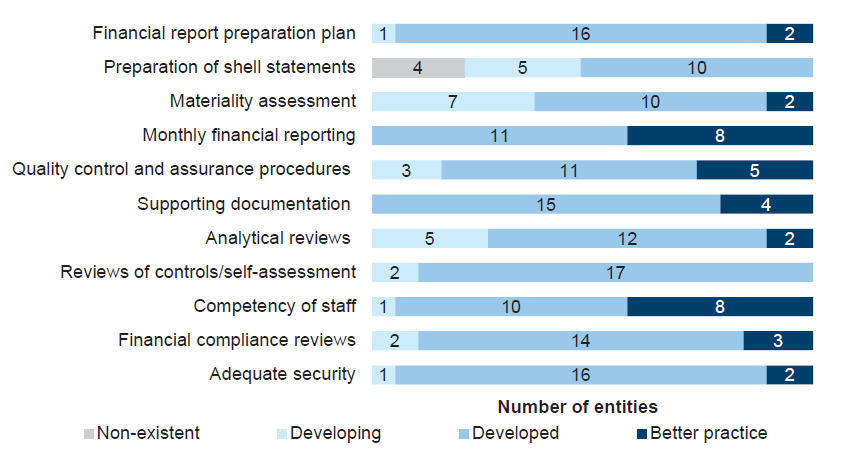
Source: Victorian Auditor-General's Office.
Adopting the better practice elements can mitigate significant delays and additional costs in the finalisation of the audit. Unaddressed, these elements can jeopardise an entity's ability to meet legislated time lines and cause unnecessary cost increases due to the need for rework.
While most elements were developed with some entities having achieved better practice, the most significant elements to be addressed by water entities are:
- the preparation and quality of shell statements
- conducting materiality assessments
- preparing analytical reviews.
The regional urban and rural water entities, in particular, place heavy reliance on the Puddle Regional Water Corporation Model General Purpose Financial Report (Puddle) to assist in preparing their shell and draft financial reports annually.
Puddle presents example disclosures for a regional urban water entity. Puddle is prepared by the Victorian Water Industry Association (VicWater), an association of which all 19 water entities are members.
During the 2013–14 financial year, the planning process for Puddle did not occur until quite late, meaning that a draft version of the model financial statements was not available to water entities until July 2014. This was too late in the reporting period for water entities to prepare adequate shell financial statements, which are usually prepared in May. This caused delays in the year-end financial report preparation process and increased disclosure amendments requested by VAGO at year end.
It is imperative that water entities discuss the timing of the release of Puddle with VicWater, to ensure that it is available in sufficient time for water entities to consider and assess key financial reporting changes and to collate appropriate information to incorporate any changes in reporting requirements to shell statements.
We understand that in October 2014, the water entities and VicWater have proactively commenced discussions on the release of Puddle, to ensure that the timing occurs significantly earlier in the 2014–15 reporting period.
2.4 Internal control weaknesses
Effective internal controls help entities to reliably and cost-effectively meet their objectives. Strong internal controls are a prerequisite for the delivery of reliable, accurate and timely external and internal financial reports.
In our annual financial audits we focus on the internal controls relating to financial reporting and assess whether entities have managed the risk that their financial reports will not be complete and accurate. Poor internal controls diminish management's ability to comply with relevant legislation, and increase the risk of fraud and error.
The governing body of each water entity is responsible for developing and maintaining internal controls that enable:
- preparation of accurate financial records and other supporting documentation
- timely and reliable external and internal reporting
- appropriate safeguarding of assets
- prevention and detection of errors and other irregularities.
- internal control weaknesses commonly identified across the 19 water entities in 2013–14
- analysis of the status of internal control weaknesses identified in prior period audits.
Commonly identified internal control weaknesses or financial reporting issues
During the 2013–14 reporting period, audit teams identified 90 internal control weaknesses or financial reporting issues, and one process improvement matter, which were reported to those charged with governance and to audit committees. Figure 2B shows the number of issues identified by risk rating.
Figure 2B
Internal control weaknesses or financial reporting issues
identified during 2013–14, by risk rating
Risk rating |
Number of issues identified |
|---|---|
High |
9 |
Medium |
31 |
Low |
50 |
Process improvement |
1 |
Note: The criteria for high-, medium- and low-risk ratings, or a process improvement issue are explained in Appendix C.
Source: Victorian Auditor-General's Office.
The common areas requiring improvement to controls or financial reporting processes were:
- information technology
- payroll and provisions
- monitoring, maintenance and accounting for fixed assets
- preparation and review of general ledger reconciliations.
Figure 2C sets out the financial areas and systems in 2013–14.
Figure 2C
Occurrence of internal control weaknesses or financial reporting issues
by financial area and system
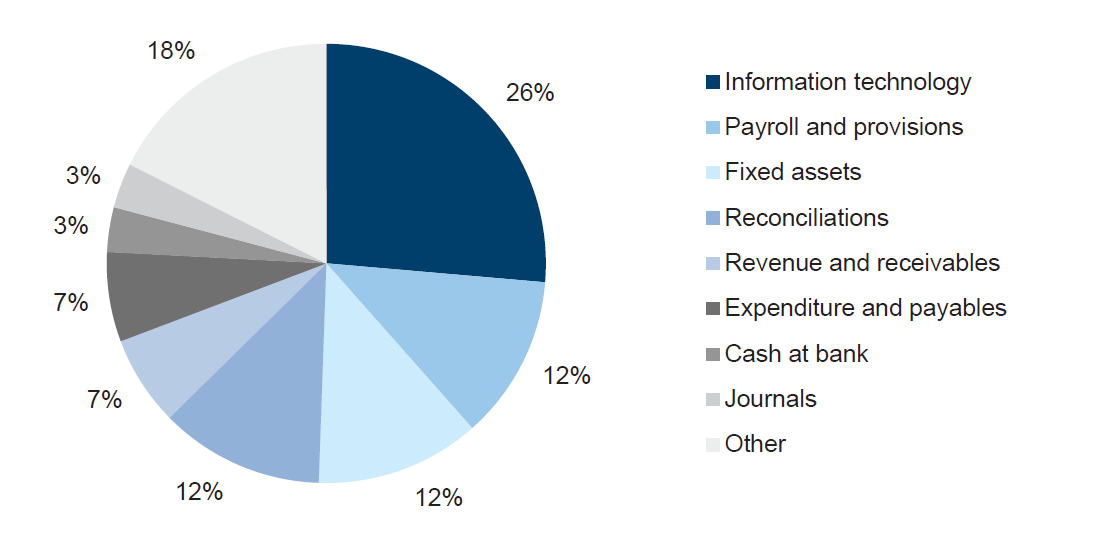
Source: Victorian Auditor-General's Office.
Information technology
Information technology (IT) controls protect computer applications, infrastructure and information assets from a wide range of security and access threats. They promote business continuity, minimise business risk, reduce the risk of fraud and error, and help meet business objectives.
There is extensive reliance on IT across the water industry, and systems are continually upgraded and replaced to improve information management and the quality of services provided to the community. With the implementation of new IT, the upgrade of existing systems and the continuing emergence of external threats, new security risks to the IT environment can arise regularly.
Information held by water entities about employees, customers and suppliers, and the financial and operational aspects of the business, can be highly sensitive. It needs to be protected from unauthorised access, theft or manipulation.
Twenty-four IT control weaknesses were identified relating to:
- user access—13 issues
- software patches—five issues
- strategic frameworks—two issues
- third party assurance over the operation of controls—two issues
- business continuity management—one issue
- change management—one issue.
Payroll and provisions
Salaries and wages are a substantial business cost to water entities. Adequate internal controls should therefore exist over the processing and monitoring of salaries and related costs, to mitigate the risk of error, fraud or mismanagement.
The following payroll-related weaknesses were identified:
- lack of review of payroll pay-runs, payroll details, payroll exception reports and termination payments—six issues
- excessive annual leave—two issues
- lack of segregation of duties—one issue
- on-cost rates were not up to date—one issue
- staff approving payroll payments who have not been formally delegated the responsibility to do so—one issue.
Monitoring, maintenance and accounting for fixed assets
Water entities have substantial fixed assets including infrastructure, land, buildings and plant and equipment. The assets need to be appropriately recorded and maintained, and their condition and use monitored, so that decisions can be made about whether they are appropriately valued and when they need to be replaced. Inadequate recording and monitoring of assets can lead to their misappropriation and misplacement, or trigger material misstatements in the financial report.
Weaknesses were identified relating to:
- untimely capitalisation of fixed assets—four issues
- lack of clarity regarding fixed asset policies or classification—three issues
- untimely conduct of condition assessments of assets—one issue
- inadequate records managements of documentation to support capital projects—one issue
- incorrect data input into the fixed asset register—one issue
- inappropriate level of access provided to staff to the fixed asset register—one issue.
Preparation and review of general ledger reconciliations
A financial report is generally prepared based on information captured by the entity's general ledger, with key balances within the general ledger often supported by information recorded in subsidiary ledgers such as accounts payable, billings, fixed assets and payroll systems. Periodic reconciliation of the general ledger with the subsidiary ledger balances is vital to confirm the completeness and accuracy of data.
Timely preparation and independent review of key account reconciliations decreases the risk that errors may go undetected or may not be resolved in a timely manner, both of which can adversely affect the accuracy of periodic financial reporting.
Issues relating to key account reconciliations were identified at eight of the 19 water entities, comprising two metropolitan, five regional urban and one rural water entity. The key issues identified were:
- reconciliations not prepared and/or independently reviewed in a timely manner—eight issues
- long outstanding unreconciled amounts—three issues.
Action on issues identified in prior-year audits
Internal control weaknesses and financial reporting issues reported to management and the governing body should be actioned and resolved in a timely manner.
Ninety-two issues were raised across the 2011–12 and 2012–13 reporting periods, which were still unresolved at the commencement of the 2013–14 reporting period. However, it is pleasing to note that only 15 of these remained unresolved at the end of 2013–14. One of these was rated as high risk, eight were rated medium risk and the remaining six were rated as low risk.
The unresolved control weaknesses and financial reporting issues were reported to management at eight of the 19 water entities. The weaknesses were spread across metropolitan, regional urban and rural water entities.
The resolution of 77 of the previously identified and reported internal control weaknesses and financial reporting issues during 2013–14 suggests that water entities are aware and managing the risk of material misstatement. We encourage a continued focus on the resolution of prior-year internal control weaknesses and financial reporting issues.
Recommendations
That water entities:
- continue to work closely with their industry body to ensure that the preparation and release of the industry's model financial report occurs earlier
- identify, at an early stage, and understand the requirements that stem from financial reporting changes by the Australian Accounting Standards Board and/or the Financial Reporting Directions
- further refine their financial reporting processes by conducting materiality assessments, preparing analytical reviews and preparing quality shell financial statements.
3 Performance reporting
At a glance
Background
In the past only 16 of the 19 water entities were required to prepare audited performance reports, however the release of Financial Reporting Direction (FRD) 27C Presentation and Reporting of Performance Information during 2013–14 extended this requirement to all water entities. This Part covers the results of the 2013–14 audits of water entity performance reports. Currently, we form an opinion on whether the performance indicators fairly represent the entity's actual performance. We do not form an opinion on the relevance or appropriateness of the reported performance indicators.
Conclusion
Parliament can have confidence in the fair presentation of all 19 performance reports, as all received unqualified audit opinions for 2013–14.
Findings
Improvement has occurred in performance reporting during 2013–14, when compared to prior years, largely due to the efforts of an industry working group and the former Department of Environment and Primary Industries. Nevertheless, further improvement is still required to the reporting of targets, variance explanations, lay out and supporting calculations of performance reports. Water entities should also continue to improve performance reporting processes, such as preparing shell statements and enhancing quality control and assurance procedures.
Recommendations
- That the Department of Environment, Land, Water and Planning:
- engage early with water entities to ensure that all applicable indicators are included in the corporate plans of water entities
- enhance the guidance supporting the Ministerial Reporting Direction (MRD) 01 Performance Reporting, to address issues encountered in 2013–14.
- That water entities critically assess the way they calculate and explain variances ensuring performance reports fully address the requirements of the MRD 01.
3.1 Introduction
This Part covers the results of the audits of the 2013–14 performance reports of 19 water entities. This is the first year that all 19 water entities were required to prepare audited performance reports.
In 2012–13, 16 of the 19 water entities were required to prepare such reports, however the release of Financial Reporting Direction (FRD) 27C Presentation and Reporting of Performance Information during 2013–14 extended the requirement to all water entities.
On 4 December 2014, the Governor in Council, under section 10 of the Public Administration Act 2004, made an order to change the name of the Department of Environment and Primary Industries (DEPI) to the Department of Environment, Land, Water and Planning (DELWP).
3.2 Conclusion
Parliament can have confidence in the fair presentation of all 19 performance reports as they received unqualified audit opinions for 2013–14.
3.3 Performance reporting framework
FRD 27C Presentation and Reporting of Performance Information was issued in May 2014. It replaced FRD 27B Presentation and Reporting of Performance Information, effective for reporting periods commencing 1 July 2013. It was updated to capture all 19 water entities and to provide definitions for the 'Responsible Portfolio Minister' and 'Targets'.
During 2012–13, the former DEPI and a water industry performance reporting working group reviewed a suite of proposed key performance indicators (KPI). After consultation and feedback between the former DEPI and the water entities, a number of financial and non-financial indicators were agreed upon and reported against in 2013–14.
The water entities were required to reflect the agreed KPIs in their 2013–14 corporate plans which were submitted to the former DEPI. There was an expectation by the former DEPI that the corporate plans would contain all KPIs to be included in the 2013–14 performance reports and that targets would be set for all indicators.
Ministerial Reporting Direction (MRD) 01 Performance Reporting was issued on 20 May 2014 pursuant to section 51 of the Financial Management Act 1994. MRD 01 specified the format, content, and indicators to be included in performance reports.
On 9 July 2014, the former Minister for Water approved an addendum to MRD 01 to allow the aggregated reporting of results against targets for two non-financial KPIs—water quality compliances and effluent reuse. This addendum was issued as a number of water entities had not set disaggregated targets for these two KPIs in their 2013–14 corporate plans, and as such would not have been able to prepare their performance report in line with the originally released MRD 01.
It is important that early engagement occurs between DELWP and water entities to ensure that all water entities are made aware of the required performance indicators and set appropriate targets for these indicators in their corporate plans.
Figure 3A summarises the number and nature of indicators by water entity type.
Figure 3A
Key performance indicators by sector
Water sector |
Financial indicators |
Non-financial indicators |
Total |
|---|---|---|---|
Metropolitan |
|||
|
7 |
15 |
22 |
|
7 |
11 |
18 |
Regional urban |
7 |
11 |
18 |
Rural |
7 |
5 |
12 |
Source: Victorian Auditor-Generals Office.
Appendix F provides further detail on the financial and non-financial indicators for each entity type.
3.4 Audit opinions issued
Unqualified audit opinions were issued on all 19 performance reports for 2013–14.
Our annual attest audit on the performance report of 19 water entities is currently limited to an opinion on whether the actual results reported are fairly presented and comply with legislative requirements. We do not form an opinion on the relevance or appropriateness of the reported performance indicators.
3.5 The quality of performance reporting
Overall the water entities produced reliable information in performance reports.
3.5.1 Timeliness of reporting
Performance reports are generally prepared and finalised in conjunction with financial reports and the common time line for their preparation is provided at Part 2.
Appendix D sets outs when the performance report for each entity was finalised.
3.5.2 Accuracy
In 2013–14:
- six of the 19 performance reports included key performance indicators where 2012–13 comparative results were not disclosed
- five of the 19 performance reports included indicators where targets were reported as 'not applicable', compared with nine of 16 in 2012–13.
Further, some water entities did not initially:
- calculate significant variations correctly—10 of the 19 water entities
- present and disclose the performance reports in line with the requirements of the updated MRD 01—four of the 19 water entities
- provide appropriate commentary to explain significant variations between targets and actual performance or between prior year and current year actual performance
- state what steps management have taken or planned to take to reduce variations against prior year and target—16 of the 19 water entities. The requirement to include this explanation against prior year results was new for 2013–14.
Of the five performance reports that contained key performance indicators without targets:
- Two performance reports included the mandated indicators from MRD 01 but reported the target as 'not applicable' as the indicator did not relate to the entity's operations—they were only included in the report as it was required under MRD01
- Three performance reports disclosed 'not applicable' against some key performance indicators, as no target was set in the 2013–14 corporate plan, approved by the former DEPI. The targets were either only set for 2014–15 onwards, or it had been agreed not to be included. The reporting of 'not applicable' against targets in the performance reports demonstrates a disconnect between the corporate planning process of water entities and the sector's performance reporting obligations.
The six performance reports that contained no comparative results for the key performance indicators did so because:
- the relevant entities did not track such information or data to allow for comparative results to be reported, as it was not a requirement to previously report
- the indicator did not relate to the entity's operations—it was only included in the report as it was required under MRD 01.
The MRD required water entities to provide explanations for all significant variances and to set out what steps management have taken or planned to take to reduce variations against the prior year and the target. It would be beneficial if water entities were only required to provide details of steps management have taken or planned to take with respect to unfavourable variances—such measures are not needed when considering favourable results.
Improvements to the consultation process between the water entities and DELWP are required, in terms of the overall requirements of, and key changes made to, MRD 01 annually, to ensure that water entities understand the full extent of the disclosures required and comply.
Water entities should also critically assess the explanations they provide for material variations to ensure that they addresses the requirements of MRD 01.
Inconsistencies were also identified in the way in which performance indicators were calculated against the required calculation format outlined in MRD 01. DELWP should consider providing further guidance on how each key performance indicator is to be calculated.
3.5.3 Better practice
Performance reports were assessed against better practice criteria, as per the framework detailed in Appendix B. The rating scale used in our assessment is consistent with that outlined in Part 2 of this report.
Figure 3B
Results of assessment of performance report preparation processes
against better practice elements
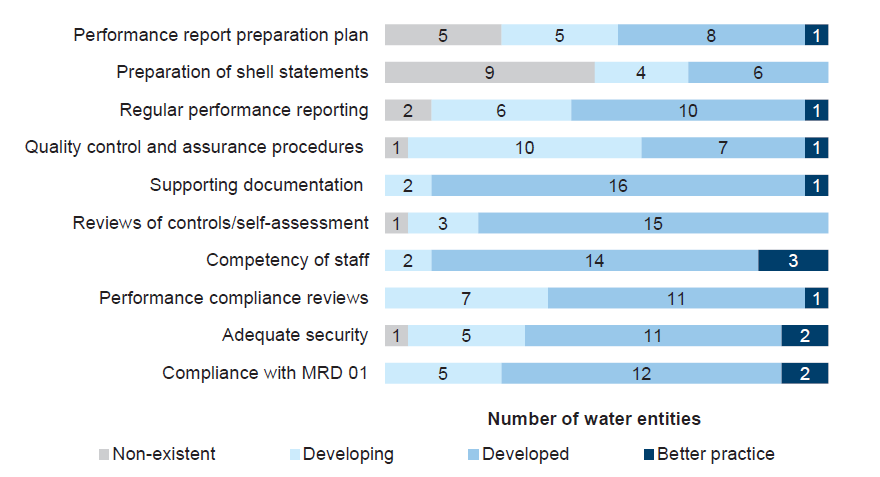
Source: Victorian Auditor-General's Office.
Figure 3B shows that improvement is needed to performance reporting processes in the following areas:
- the development of a performance report preparation plan
- the preparation of shell statements
- regular performance reporting
- quality control and assurance procedures
- performance compliance reviews.
Performance reporting processes adopted by the water entities are not as mature or developed as those applied to financial reporting.
The early preparation of shell performance reports prior to year end could help reduce the number of errors in performance reports. This can provide water entities with the opportunity to reduce costs and achieve efficiencies during the year end process. This, however, is contingent upon the timing of the release of MRD 01 by DELWP.
3.6 Elements of effective performance reporting
The Audit Act 1994 provides the Auditor-General with a mandate to audit performance indicators in the report of operations of an audited entity to determine whether they:
- are relevant to the stated objectives of the entity
- are appropriate for the assessment of the entity's actual performance
- fairly represent the entity's actual performance.
Our annual audit on the performance report of water entities is currently limited to an opinion on whether the actual results reported are presented fairly and in compliance with the legislative requirements.
In our Water Entities: Results of the 2010–11 Audits report we indicated our intention to begin expressing opinions on the relevance and appropriateness of the indicators. In our Water Entities: Results of the 2012–13 Audits report we provided an update on progress made by the former DEPI and a water industry working group in developing a contemporary framework to facilitate the inclusion of relevant and appropriate financial and non‑financial indicators in the sector's future performance reports.
3.6.1 Progress in 2013–14
The 2013–14 reporting period was the first year where a consistent pro-forma and detailed guidance existed for each water entity type via MRD 01, and where the majority of targets were set in the 2013–14 corporate plan process. Deficiencies were encountered with the reporting of targets, variance explanations, lay out and supporting calculations. Nevertheless, an improvement in performance reporting occurred when compared to prior years given the framework established.
The 2014–15 corporate plan process was finalised in June 2014, where targets have been set for performance indicators which are expected to be prescribed in the MRD 01 for 2014–15. Moving forward, it is intended that audit opinions on performance reports may conclude on the relevance and appropriateness of the performance indicators and whether they fairly present performance.
Recommendations
That the Department of Environment, Land, Water and Planning:
- engages early with water entities to ensure that all indicators—at an appropriate level of granularity—are included in the corporate plans of water entities
- enhances the guidance supporting the Ministerial Reporting Direction 01 Performance Reporting, to address issues encountered with the calculation of variances and the requirements of variance explanations.
That water entities:
- critically assess the way they calculate and explain variances ensuring performance reports fully address the requirements of the Ministerial Reporting Direction 01 Performance Reporting.
4 Financial results
At a glance
Background
This Part covers the financial results of the 19 water entities for the year-ended 30 June 2014.
Conclusion
The 19 water entities generated a net profit before income tax of $318.2 million for the year-ended 30 June 2014, an increase of $234.5 million, or 280 per cent, from the prior year. This was largely due to two metropolitan water entities reporting significantly higher profits as a result of higher water, sewerage and other prices, as approved by the Essential Services Commission, and higher water consumption.
The profitability of the 19 water entities will be impacted by higher finance costs in the future as a result of increased borrowings up to 30 June 2014, continued commitments to government such as taxes and levies, and honouring commitments from the former Fairer Water Bills initiative.
Findings
- Finance costs increased by $213 million, or 23.4 per cent, compared to the prior year.
- In 2013–14 dividends paid totalled $38.4 million, a decrease of $105.4 million, or 73 per cent, on 2012–13. This excludes a dividend payment by Melbourne Water on 31 July 2013 of $94.5 million relating to their 2011–12 final dividend.
- At 30 June 2014, the 19 water entities controlled $42 billion in total assets—$41.4 billion at 30 June 2013—and had total liabilities of $20.3 billion—$20.1 billion at 30 June 2013.
- Interest‑bearing liabilities increased by $148 million, or 1 per cent, during the year, predominantly due to increases in borrowings to finance the construction of infrastructure assets and other obligations.
- Total payments to the state by water entities in 2013–14 amounted to approximately $474.7 million, for the environmental contribution levy, tax, financial accommodation levy and dividends.
4.1 Introduction
Accrual-based financial reports enable an assessment of whether water entities generate sufficient surpluses from their operations to maintain services, fund asset maintenance/renewal and repay debt. Their ability to generate surpluses is subject to the regulatory environment in which they operate and their ability to minimise costs and maximise revenue.
An entity's financial performance is measured by its net operating result—the difference between its revenues and expenses. An entity's financial position is measured by reference to its net assets—the difference between its total assets and total liabilities.
4.2 Financial results
4.2.1 Financial performance
The 19 water entities are subject to the National Tax Equivalent Regime (NTER) administered by the Australian Taxation Office. NTER is an administrative arrangement that results in government-owned enterprises paying a tax equivalent to the state government.
Accordingly, we present their net results before and after income tax in this section.
Net result before income tax
The 19 water entities generated a combined net profit before income tax of $318.2 million for the year-ended 30 June 2014, an increase of $234.5 million, or 280 per cent, on the prior year. This was largely due to two metropolitan water entities reporting significantly higher profits as a result of higher water, sewerage and other prices, as approved by the Essential Services Commission (ESC), and higher water consumption.
Sector performance
All four metropolitan water entities reported a net profit in 2013–14.
The regional urban water entities, as a cohort, improved their performance. Though the number of water entities reporting losses remained the same—four in 2013–14 and 2012–13—overall, regional urban water entities reported a net profit before income tax of $18.0 million, compared with $6 million in 2012–13.
The two rural water entities continued to report losses in 2013–14.
Figure 4A shows the net profit or loss before income tax for each entity for the past two years.
Figure 4A
Net profit/(loss) before income tax, by water entity
Entity |
2013–14 ($ mil) |
2012–13 ($ mil) |
|---|---|---|
Metropolitan sector |
||
Wholesaler |
||
Melbourne Water |
131.9 |
(61.6) |
Retailer |
||
City West Water |
36.1 |
44.9 |
South East Water |
126.4 |
75.3 |
Yarra Valley Water |
66.0 |
66.6 |
Regional urban sector |
||
Barwon Water |
11.3 |
28.3 |
Central Highlands Water |
10.3 |
5.5 |
Coliban Water |
(6.7) |
(21.6) |
East Gippsland Water |
4.0 |
4.0 |
Gippsland Water |
4.9 |
4.4 |
Goulburn Valley Water |
2.5 |
2.6 |
GWMWater |
(15.1) |
(34.3) |
Lower Murray Water |
(3.8) |
(4.4) |
North East Water |
5.5 |
7.9 |
South Gippsland Water |
(0.4) |
(0.3) |
Wannon Water |
2.6 |
8.6 |
Western Water |
1.6 |
4.1 |
Westernport Water |
1.3 |
1.2 |
| Rural sector |
||
Goulburn-Murray Water |
(55.5) |
(44.0) |
Southern Rural Water |
(4.7) |
(3.5) |
Total |
318.2 |
83.7 |
Source: Victorian Auditor-General's Office.
Six entities delivered a loss before income tax for 2013–14, compared with seven in 2012–13.
Melbourne Water's net profit before income tax improved by $193.5 million as a result of increases in the ESC's approved bulk water and sewerage prices it was allowed to charge its customers (which are the retailers) in Water Plan 3 and the reduction in the refund to customers that was required to be made as a result of the delay in the desalination plant. The majority of the refund to customers was paid during 2012–13, with only residual amounts remaining to be paid in 2013–14. Please refer to Part 5 Water Plan 3, 2013–14 onwards for further detail on Water Plan 3.
South East Water's net profit before income tax increased by $51.1 million due to the higher service and usage prices as a result of Water Plan 3, increased water consumption by customers and larger developer contributions. These increases were partially offset by increases in the bulk water and sewerage charges levied by Melbourne Water to South East Water.
On the other hand, Barwon Water's net profit before income tax reduced by $17 million as a result of a reduction in developer and customer capital contributions and increases in depreciation and finance cost expenses. In prior years, the private sector provided a significant contribution to the construction of the Northern Water Plant—this did not occur in 2013–14, therefore reducing such contributions revenue.
Coliban Water's net loss before income tax improved due to higher service and usage prices as a result of Water Plan 3.
GWMWater's net loss before income tax improved largely due to a lower depreciation expense as a result of the write-off of the Wimmera Irrigation System in 2012–13. The full impact on the lower depreciation expense as a result of the write-off came into effect in 2013–14.
Goulburn-Murray Water's net loss before income tax increased largely as a result of the reduction in the amount of contracting services revenue received in 2013–14, $19.8 million compared with $30.6 million in 2012–13.
Net result after income tax
In 2013–14, the sector reported a combined net profit after income tax of $224.2 million, an increase of $164.5 million, or 276 per cent, from the prior year. This was primarily driven by higher water prices partly offset by higher finance charges and depreciation expenses.
Six entities delivered a loss after income tax for 2013–14, compared with seven in 2012–13.
Revenue
In 2013–14, the 19 entities generated revenue of $5.6 billion, an increase of $1.1 billion, or 23.8 per cent, on the prior year. The increase was driven by higher water prices as a result of the commencement of Water Plan 3 from 1 July 2013 and higher water consumption in part due to the warm and dry weather across the year and relaxed water restrictions.
Service charges increased by $173 million, or 12.9 per cent, from 2012–13, while usage charges increased by $327 million, or 21.3 per cent. The metropolitan retail water entities saw the greatest increases to their approved service and usage charges of 25.5 per cent, or $474.9 million. The regional urban water entities had an increase to their service and usage charges of 3.5 per cent, or $30 million, while the rural water entities saw a combined decrease to their service and usage charges of 3.1 per cent, or $4.9 million.
Melbourne Water is the wholesaler of Melbourne's water supply and is responsible for managing catchments, waterways and major drainage systems, treating water and transferring the water to the metropolitan water retailers—City West Water, South East Water and Yarra Valley Water. The costs incurred by Melbourne Water for these activities are charged to the metropolitan water retailers by way of bulk water and sewerage charges, which are approved by the ESC. The bulk water and sewerage charges levied by Melbourne Water to the metropolitan water retailers increased by approximately $490 million, or 50 per cent, from the prior year, in line with the ESC approved Water Plan 3 prices. Below, the expense incurred by the retailers for this charge is noted.
Expenses
In 2013–14, the 19 entities incurred $5.3 billion in total expenditure, an increase of $840 million, or 19 per cent, from the prior year, predominantly due to:
- The bulk water charges paid by the metropolitan retail water entities to Melbourne Water increased by approximately $490 million, or 50 per cent, in line with the ESC approved Water Plan 3 prices.
- Finance costs increased by $213 million, or 23.4 per cent, as a result of increases in the financial accommodation levy rate and increased borrowings—some water entities are continuing to increase their borrowings to finance the construction of infrastructure assets and other obligations. The main contributor to the increase in finance costs across the industry, however was Melbourne Water. Melbourne Water saw their finance costs increase by $178.3 million largely because 2013–14 was the first year the full effect of finance costs relating to the desalination plant were incurred. Finance costs relating to the desalination plant only impacted Melbourne Water for seven months in 2012–13 due to commercial acceptance being achieved in December 2012, however a full 12 months of finance costs were incurred in 2013–14.
- Employee benefits increased by $31 million, or 6.2 per cent, which is in line with increases to salaries and wages as per enterprise bargaining agreements and other labour costs.
- Depreciation and amortisation increased by $49 million, or 5.4 per cent, due to the growth in the infrastructure, property, plant and equipment balances of water entities.
Dividends
The 19 entities are obliged to pay a dividend to the state if the Treasurer, after consultation with the governing board and responsible minister, makes a formal determination to do so. In the past, only the metropolitan water entities have been required to pay a dividend. The regional urban and rural water entities have not been required to make a dividend payment due to the operating results generated.
Dividends are generally paid twice a year as follows:
- an interim dividend determined in April based on half-year financial results
- a final dividend determined in October based on annual financial results.
In 2013–14, dividends paid by for the four metropolitan water entities totalled $132.9 million, a decrease of $10.9 million, or 7.6 per cent, on 2012–13. The 2013–14 figure is impacted by Melbourne Water paying $94.5 million on 31 July 2013, relating to their 2011–12 final dividend––dividends paid, excluding this amount for 2013–14 are $38.4 million, a decrease of $105.4 million, or 73 per cent, on 2012–13.
The reduction in dividends paid in 2013–14—net of Melbourne Water's 2011–12 final dividend paid—compared to 2012–13 is due to no determination being made for a 2013–14 interim dividend for the 2013–14 year for the metropolitan water entities.
As reported in the Auditor-General's Report on the Annual Financial Report of the State of Victoria, 2013–14 the calling of dividends in 2012–13 had a significant impact on the General Government Sector achieving its fiscal target of at least $100 million each financial year, consistent with net debt and infrastructure parameters. In 2013–14, when there was little risk of the state not achieving this target, fewer dividends were called. Figure 4B details the total interim and final dividends paid by the four metropolitan water entities across the past five years.
Figure 4B
Interim and final dividends paid by the four metropolitan water entities,
2009–10 to 2013–14
Year |
Final dividend |
Interim dividend |
|---|---|---|
2009–10 |
61.20 |
114.85 |
2010–11 |
71.28 |
- |
2011–12 |
269.70 |
- |
2012–13 |
119.90 |
23.90 |
2013–14 |
132.90 |
- |
Total |
654.98 |
138.75 |
Note: The
above table shows final and interim dividends paid each year, as opposed to the
year in which they were determined or relate to.
Note: As
reported in our Water Entities: Results of the 2012–13 Audits,
in 2011–12 the metropolitan water entities and a regional water entity
collected payments from customers to cover the costs of purchasing water from
the desalination plant. However, due to delays in commissioning the plant, the
plant was not operational and the amounts paid by customers was not needed.
From 1 July 2012, water entities began returning payments to customers via a
12 month price freeze. This impacted the profits and dividends for the
metropolitan entities for both 2011–12 and 2012–13.
Source: Victorian
Auditor-General's Office.
At 30 June 2013, Melbourne Water was required to record a liability to make a $94.5 million final dividend payment relating to the 2011–12 financial year. This was paid on 31 July 2013 as previously noted. Melbourne Water was not required to pay a final dividend for the 2012–13 financial year as it did not make a profit during 2012–13.
The three metropolitan retailers were all required to make final dividend payments for the 2011–12 financial year and interim dividend payments based on their 2012–13 half-yearly results during 2012–13. The three metropolitan retailers made lower profits during 2012–13. As a result, their final dividend payments for 2012–13, which were paid during 2013–14, were $38.4 million, compared with $119.9 million in final dividend payments for 2011–12, which was paid during 2012–13. Figure 4C shows the dividends paid for the four metropolitan water entities each financial year for the past five years.
Figure 4C
Dividends paid by the metropolitan water entities,
2009–10 to 2013–14
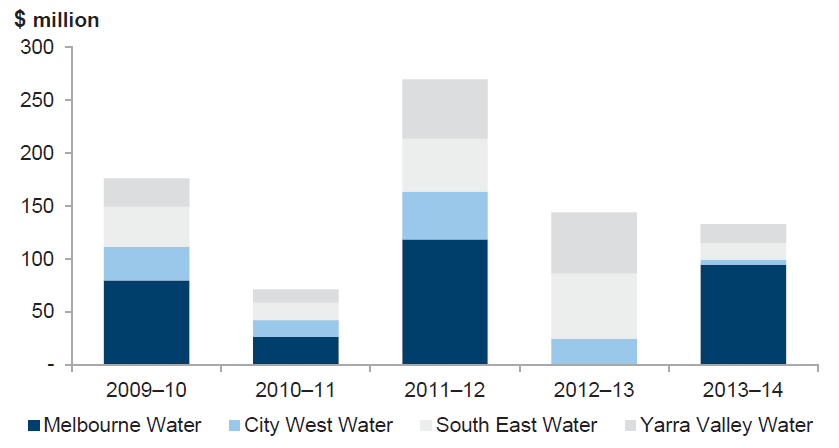
Source: Victorian Auditor-General's Office.
2013–14 final dividend determination
The 2013–14 final dividends for metropolitan water entities of $87.7 million were determined by the then Treasurer in October 2014, payable by the metropolitan water entities in 2014–15, as shown in Figure 4D. As these dividends were not determined until after 30 June 2014, they were not included in the 2013–14 financial reports.
Figure 4D
Final dividend determination—2013–14 reporting period
Entity |
2014 final dividend determination |
|---|---|
City West Water |
$11.4 million |
South East Water |
$35.6 million |
Yarra Valley Water |
$19.2 million |
Melbourne Water |
$21.5 million |
Total |
$87.7 million |
Source: Victorian Auditor-General's Office.
4.3 Financial position
The ability of water entities to maintain and renew their infrastructure assets depends on the adequacy of their asset and debt management policies or on the level of surpluses achieved. Their effectiveness is reflected in the composition and rate of change in the value of their assets and liabilities over time.
4.3.1 Assets
At 30 June 2014, the 19 water entities had assets of $42 billion, an increase of $653 million, or 1.6 per cent, compared to the prior year. Property, plant, equipment and infrastructure assets represented 95 per cent of total assets.
A $477 million increase in the value of property, plant, equipment and infrastructure assets at 30 June 2014 was predominantly driven by:
- revaluation increments of:
- $145.6 million at Yarra Valley Water
- $53.4 million at City West Water
- additions to infrastructure assets across all cohorts.
Receivables also increased by $52 million, or 7.8 per cent, due to greater water consumption and increases in tariff charges as a result of Water Plan 3 prices. The timing of when bills are generated also impacts the receivables balance annually.
Cash and cash equivalents held by water entities at 30 June 2014 also increased by $42 million, or 11.9 per cent.
4.3.2 Liabilities
At 30 June 2014, the water industry had combined liabilities of $20.3 billion, an increase of $204 million, or 1 per cent, on the prior year.
Deferred tax liabilities increased by $50.8 million, or 1.1 per cent, in 2013–14. In addition, interest‑bearing liabilities increased by $148 million, or 1 per cent, during the year, predominantly due to increases in borrowings to finance the construction of infrastructure assets and other obligations. There was also an increase in income received in advance by Goulburn-Murray Water of $70.3 million for the Connections Project. Goulburn-Murray Water assumed responsibility of the food bowl modernisation project, now referred to as the Connections Project, on 1 July 2012. The Connections Project is being funded by the Commonwealth.
The increases were partially offset by a reduction in the dividend provision recognised by Melbourne Water in 2012–13 of $94.5 million.
Over the past five years the level of borrowings has increased by 109 per cent from $7 billion in 2009–10 to $14.6 billion in 2013–14. Over the five-year period, the level of borrowings in 2012–13 increased significantly, with an increase of $5.4 billion as a result of the desalination plant.
Figure 4E shows the correlation between the increase in borrowings to finance the construction of infrastructure assets and payment of dividends over the last five years.
Figure 4E
Increases in borrowing to finance the construction of infrastructure assets and
payment of dividends, 2009–10 to 2013–14
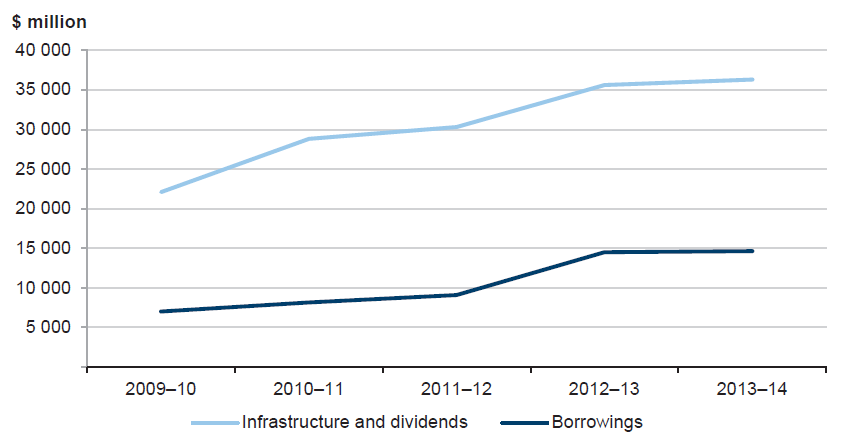
Source: Victorian Auditor-General's Office.
4.4 Subsequent events
As stated in Part 1, the financial impact of the former government's Fairer Water Bills initiative for customers did not commence until 1 July 2014.
Melbourne Water identified cost savings from their 2013–14 operations of $56.6 million. These savings were required to be passed on by Melbourne Water to retail water entities—namely City West Water, South East Water and Yarra Valley Water, as well as Western Water, which purchases water from the Melbourne Water supply—to contribute to the rebate effective 1 July 2014.
Though funds were to be provided by Melbourne Water to the four water entities, these entities were not able to recognise a receivable at 30 June 2014, as the recognition criteria under the accounting standards had not been met.
Additionally, based on the conditions of the former Fairer Water Bills initiative, these water entities had not met the criteria to recognise a provision under accounting standards to allow for any costs associated with the initiative—consequently no provisions were recognised as at 30 June 2014. The cost of the initiative will be recognised by these entities in 2014–15.
The three metropolitan water entities and Western Water disclosed the above matters in a subsequent events note to their 2013–14 financial reports.
Since Melbourne Water had recognised the cost of the former Fairer Water Bills initiative as a provision in their financial report, they were not required to have a subsequent events note about it. They did, however include in their commitments note, the funding required to be paid to the retailers to contribute to lower water bills over the next four years.
For the regional urban water entities, where the impact of the former Fairer Water Bills initiative was considered material, subsequent event note disclosures were made regarding its commencement on 1 July 2014.
4.5 Emerging matters
4.5.1 Payments to government
Water entities are required to make the following payments to the state:
- The environmental contribution levy was established in 2004 to fund water reform initiatives that promote the sustainable management of water or address adverse water-related environmental impacts. Approximately $112.2 million was paid in 2013–14, compared with approximately $69.4 million in 2012–13.
- Income tax, under the NTER, is calculated at 30 per cent—$123.6 million was paid in 2013–14, compared with $113.2 million in 2012–13.
- The financial accommodation levy (FAL)—where a water entity has borrowings greater than $5 million it may be liable for FAL. It is paid four times per year. It has been applied to government business enterprises since 1995–96 to remove the market advantage government entities may experience in borrowing, as a result of their sovereign status. It is aimed at ensuring that borrowings are valued appropriately in financing decisions for capital projects. Until 1 July 2013, the FAL charged to water entities and paid to the Department of Treasury and Finance was capped at 110 basis points. On 1 July 2013, the cap was removed, and water entities were charged a commercial rate for new borrowings based on their underlying credit rating. Approximately $105.7 million was paid and payable in 2013–14, compared with approximately $89.5 million in 2012–13.
- Dividends are generally calculated at 35 per cent of pre-tax profit—$132.9 million was paid in 2013–14, compared with $143.8 million in 2012–13.
These payments are required to be made from the cash available from the operations of a water entity, or if required, through additional borrowings.
The amount of environmental contribution levy paid, financial accommodation levy paid or payable, tax paid and dividends paid to the government by the water industry over the last two years, against adjusted net cash flow from operations is shown in Figure 4F.
Figure 4F
Adjusted net cash flow from operations compared
to payments to government
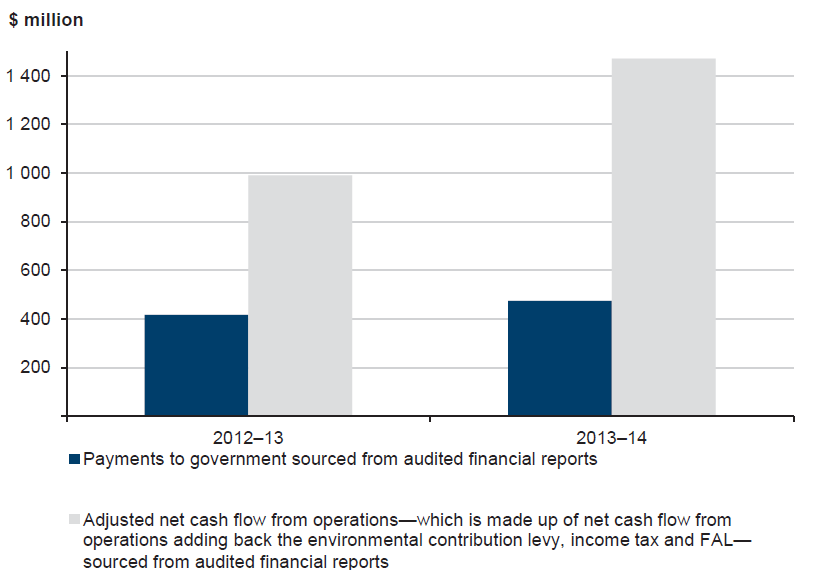
Source: Victorian Auditor-General's Office.
Figure 4F shows that a reasonable proportion of cash receipts received from operations—42 per cent in 2012–13 and 32.2 per cent 2013–14—are used by water entities to service payments to government. The funds used to meet these obligations are being diverted from other core activities, such as capital works or capital maintenance, which may in turn lead to greater dependency on borrowings to fund activities.
The financial sustainability risk of water entities is reviewed in Part 5.
5 Financial sustainability risks
At a glance
Background
To be financially sustainable, entities need to be able to meet current and future expenditure as it falls due, and to absorb the financial impacts of foreseeable changes and financial risks that materialise, without significantly changing their revenue and expenditure policies.
This Part provides insight into the financial sustainability risks of the 19 water entities.
Conclusion
Our analysis of the seven financial sustainability risk indicators over the past five years shows an increased risk in 2013–14.
Key challenges for the water entities moving forward include repaying growing debt, while also meeting on-going financial obligations to the state, such as taxes and levies, and addressing efficiency measures from sector reform, as experienced with the former government's Fairer Water Bills initiative.
Forming a definitive view of any entity's financial sustainability risk profile requires a holistic analysis that moves beyond financial considerations to include the water entity's operations and environment, particularly the regulatory environment in which a water entity operates. Understanding the regulatory environment is critical to understanding why the financial sustainability indicator risk results are, in some cases, less than desirable.
Findings
- Three entities had a high financial sustainability risk rating at 30 June 2014 due to the magnitude of their operating losses—which is partly a consequence of the regulatory pricing model, where there is a shortfall between the price set and the total operating costs for some entities—compared with four in 2012–13.
- The number of entities rated as having a medium financial sustainability risk at 30 June 2014 increased from seven to 10, with this being the first year that all metropolitan water entities are rated medium risk.
5.1 Introduction
To be financially sustainable, entities need the capacity to meet their current and future expenditure as it falls due. They also need to absorb the financial impacts of foreseeable changes and financial risks that materialise, without significantly changing their revenue and expenditure policies.
Financial sustainability should be viewed from both a short- and long-term perspective. Short-term indicators relate to the ability of an entity to maintain positive operating cash flows, or the ability to generate an operating surplus over the short term. Long‑term indicators focus on strategic issues such as the ability to fund significant asset replacement or reduce long-term debt.
In this Part, insight is provided into the financial sustainability risks of water entities using seven financial sustainability indicators as at 30 June 2014, and trends over a five-year period. The indicator results are calculated using the financial transactions and balances of each entity's statutory financial report. Appendix E describes the sustainability indicators and the risk assessment criteria used.
The indicators highlight risks to ongoing financial sustainability. However, forming a definitive view of any entity's financial sustainability requires a holistic analysis that moves beyond financial considerations to include the water entity's operations and environment, particularly the regulatory environment in which a water entity operates. Understanding the regulatory environment is critical to understanding why the financial sustainability indicator results are in some cases, less than desirable.
The Essential Services Commission (ESC) is responsible for regulating and approving the maximum price each water entity may charge its customers. Water prices are determined based on what revenue water entities require to meet service obligations and expected outcomes. The price setting process, however, only takes into account costs associated with regulatory asset values, which are substantially lower than the asset values held by water entities and recorded in the statutory financial reports. This is a key factor for the regional urban and rural water entities.
Section 5.4 of this Part sets out the regulatory price setting process and the resultant impact on the financial sustainability risks of water entities.
5.2 Financial sustainability risk assessment
5.2.1 Overall assessment
The water industry has increased its level of interest-bearing liabilities, which comprises borrowings and finance lease liabilities, by $7.6 billion, or 109 per cent, over the past five years. Key challenges for the water entities include servicing growing debt, and repaying the debt in the future. The self-financing ratio indicates that three metropolitan water entities' ability to replace assets using cash generated by their operations is low.
The profitability of the 19 water entities will continue to be impacted by higher finance costs in the future, as a result of increased borrowings up to 30 June 2014, continued commitments to government such as taxes and levies, and honouring commitments from the former Fairer Water Bills initiative.
Three entities had a high financial sustainability risk rating at 30 June 2014 due to the magnitude of their operating losses, which in part is a consequence of the regulated pricing model, discussed further in Section 5.4 of this Part.
The number of entities rated as having a medium financial sustainability risk at 30 June 2014 increased from seven to 10, with this being the first year that all metropolitan water entities are rated medium risk.
Figure 5A provides a summary of our financial sustainability risk assessment results by sector for the past two years.
Figure 5A
Financial sustainability risk assessment, by sector
|
2013–14 |
2012–13 |
|||||
|---|---|---|---|---|---|---|
|
Sector |
High |
Medium |
Low |
High |
Medium |
Low |
|
Metropolitan |
– |
4 |
– |
– |
1 |
3 |
|
Regional urban |
1 |
6 |
6 |
2 |
6 |
5 |
|
Rural |
2 |
– |
– |
2 |
– |
– |
|
Total |
3 |
10 |
6 |
4 |
7 |
8 |
Note: 2012–13 medium and low risk rating numbers have been amended since our Water Entities: Results of 2012–13 Audits due to prior period restatements in financial statements, altering indicator results.
Source: Victorian Auditor-General's Office.
Figure 5A shows that from 2012–13 to 2013–14 the greatest change in the risk profile occurred in the metropolitan water entity cohort with all four entities now in the medium risk category. Regional urban entities' risk profile has improved with only one entity assessed as high risk compared with two in 2012–13.
The financial sustainability risk results for 2009–10 to 2013–14 for each entity are provided in Appendix E.
5.2.2 Summary of trends in risk assessment over the five‑year period
When the risk assessments for each indicator are analysed they show the following trends over the five years to 2013–14:
- Underlying result—the number of entities in the high-risk category has reduced, with the number in medium-risk remaining constant.
- Liquidity—the number of entities in the high- and medium-risk categories has moved back to the levels seen in 2011–12. As at 30 June 2013, a number of entities decided to borrow additional funds to take advantage of lower borrowing costs, hence improving liquidity ratios due to larger cash balances being held.
- Interest cover—the number of entities in the high-risk category has decreased, and the number in the medium-risk category has increased.
- Debt service cover—the number of entities in the high-risk category has increased to three water entities, compared to one in 2012–13.
- Debt-to-assets—the risk profile has remained steady over the five years with most entities in the low risk category. This is largely due to the significant infrastructure asset base being measured at fair value, and being substantially greater than debt held.
- Self-financing—the number of entities in the medium-risk category has decreased over the period. In contrast, the number of metropolitan water entities rated in the high-risk category has increased, with the regional and rural entities in this category decreasing.
- Capital replacement—there has been a significant shift over the five years from the low-risk to the medium-risk and high-risk categories, partially impacted by increased depreciation due to the revaluation model.
In summary, the trends show an increased risk to financial sustainability for the industry over the five years to 2013–14. In 2009–10, 14 water entities were assessed as low risk, with two water entities classified as medium risk. In 2013–14, there are only six water entities assessed as low risk, with 10 assessed as medium risk. The high-risk category has been volatile over the five-year period, with three entities assessed as high risk in 2013–14.
Further information about the risk assessments for each indicator is presented later in this Part.
5.2.3 Analysis of trends in sustainability risk indicators over the five-year period
To further understand the financial sustainability results of the 19 water entities, we analysed five-year data for the seven indicators for the metropolitan, regional urban and rural water entities as discrete cohorts. The relevant data for each cohort are reproduced in Appendix E.
In the metropolitan sector, trends for five of the seven risk indicators declined over the period—in particular three of the four metropolitan water entities' ability to replace assets using cash generated by their operations has deteriorated. While the metropolitan water entities continue to have a large customer base, payments to government including taxes and levies, and the cost of servicing debt have added pressure to financial sustainability risks.
The regional urban water entities, as a cohort, are reasonably placed. In 2013–14, only one was rated as high risk, in comparison to two entities in the prior year.
While the rural sector entities continue to generate operating losses, three of the seven indicators show no distinct trend, two indicators show a declining trend and two show signs of improvement. The magnitude of operating losses for both entities resulted in both being rated as high risk.
5.3 Five-year trend analysis
This section provides analysis and comment on the trends in each of the seven financial sustainability indicators over a five-year period. The indicators reflect each water entity's revenue and expenditure policies, and identify whether the policies are sustainable.
Financial sustainability should be viewed from both a short- and long-term perspective. The shorter-term indicators—the underlying result, liquidity and interest cover—focus on a water entity's ability to maintain a positive operating cash flow and adequate cash holdings, and to generate an operating surplus over the short term.
The longer-term indicators—debt service cover, self-financing, debt-to-assets and capital replacement—indicate whether adequate revenue is available to replace assets to maintain the quality of service delivery, and to meet community expectations and the demand for services.
5.3.1 Underlying result
The average underlying result by the sector has fluctuated over the five-year period as illustrated by Figure 5B.
Figure 5B
Average underlying result
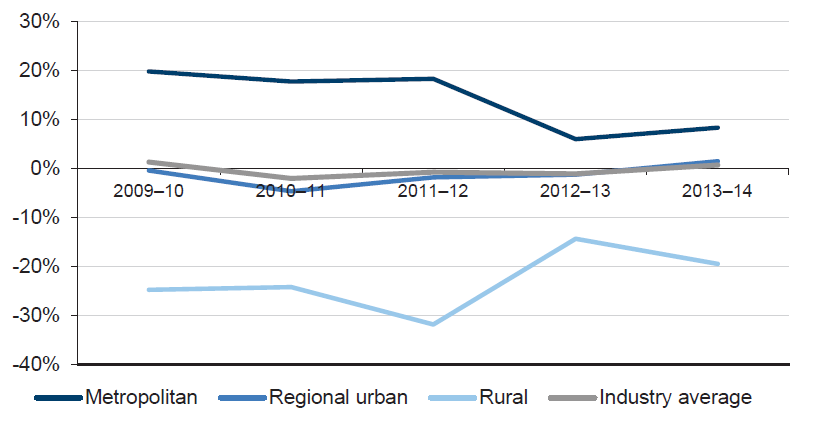
Source: Victorian Auditor-General's Office.
For the metropolitan water entities, the average underlying result was strong and relatively stable prior to 2012–13. The decline was an outcome of the price freeze that applied from 1 July 2012 and the recognition of operating costs associated with the desalination plant—practical completion was achieved on 17 December 2012.
Price increases as a result of Water Plan 3 and higher water consumption have contributed to the improvement in the average underlying result for metropolitan water entities since the decline experienced in 2012–13.
In contrast, there was a downward trend for rural entities in 2013–14. Both entities continue to generate losses—the size of these losses grew slightly in 2013–14 compared to 2012–13. For Southern Rural Water, this was a result of marginal increases in various expenditure items, while for Goulburn-Murray Water the level of revenue decreased, as did expenditure. However, the decrease in expenditure did not match that of revenue, creating a lower underlying result.
The average underlying result for regional urban entities has increased slightly since 2010–11 and is consistent with the industry average. This has been driven by a reduction in the number and extent of losses across the sector, with only four regional urban water entities showing a negative underlying result in 2013–14, compared to eight in 2011–12.
Figure 5C shows that the underlying result risk profile improved in 2013–14, with 32 per cent of water entities—six of 19—having an underlying result risk of high or medium.
Figure 5C
Underlying result risk assessment
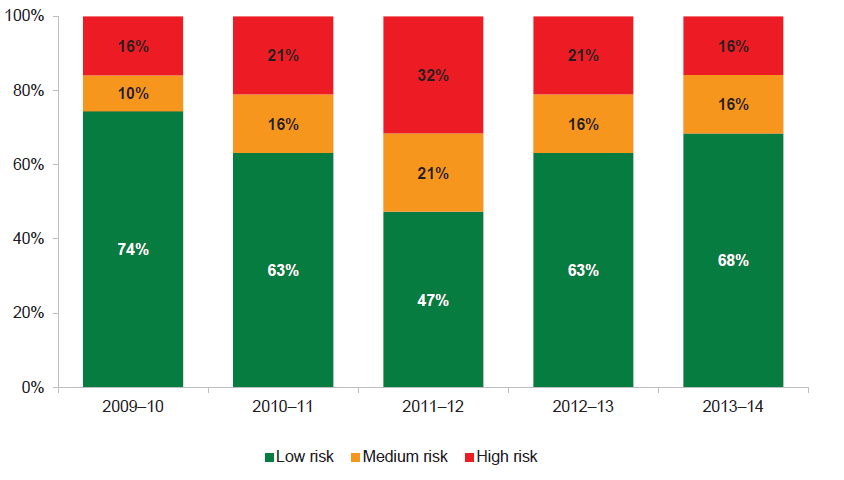
Source: Victorian Auditor-General's Office.
5.3.2 Liquidity
Figure 5D shows that the average liquidity of water entities has levelled out in 2013–14, but there has been a decline in the liquidity of the rural sector in 2013–14.
Figure 5D
Average liquidity ratio
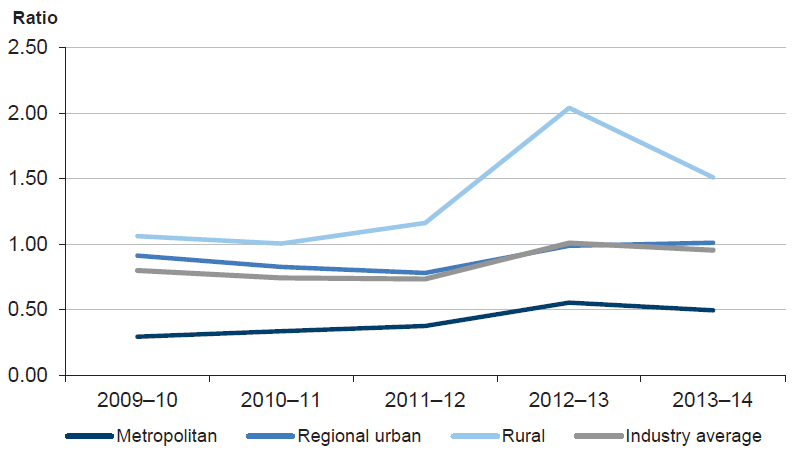
Source: Victorian Auditor-General's Office.
The substantial increase for rural water entities in 2012–13 was predominantly due to one water entity accessing new borrowings at balance date to take advantage of a lower financial accommodation levy (FAL). This meant that this water entity was able to draw down on these funds during 2013–14, which led to a sharp decline for the rural water sector in 2013–14. The resulting increase in cash reserves was offset by new long-term borrowings classified as non-current liabilities at balance date.
This strategy of accessing new borrowings in 2012–13 to take advantage of a lower FAL was also adopted by a number of entities in the other two sectors.
Although most regional urban water entities' liquidity ratio reduced during 2013–14 from 2012–13, there was a slight increase in the overall average liquidity ratio for the regional urban cohort—driven by the increase in cash on hand at two regional urban water entities. Cash was received in advance for projects not yet commenced or new borrowings were entered into at 30 June 2014 that had not been used to pay for capital projects.
Water entity liquidity risks will be impacted by their debt management strategies, among other factors.
The 19 entities source their borrowings from the Treasury Corporation of Victoria. They have approval to refinance the maturing debt and in recent years have done so. While entities have approval to refinance maturing debt, they also need to generate sufficient cash flows from operations to:
- service the increasing interest charges as debt levels increase
- repay the growing debt in the long term.
The average liquidity ratio for regional urban entities largely reflects the industry average over the five-year period.
Figure 5E shows that at 30 June 2014, 74 per cent of water entities (14 of 19) had a high or medium liquidity risk, that is, their current liabilities, such as trade payables, borrowings and current income taxes exceeded their current assets.
Figure 5E
Liquidity risk assessment
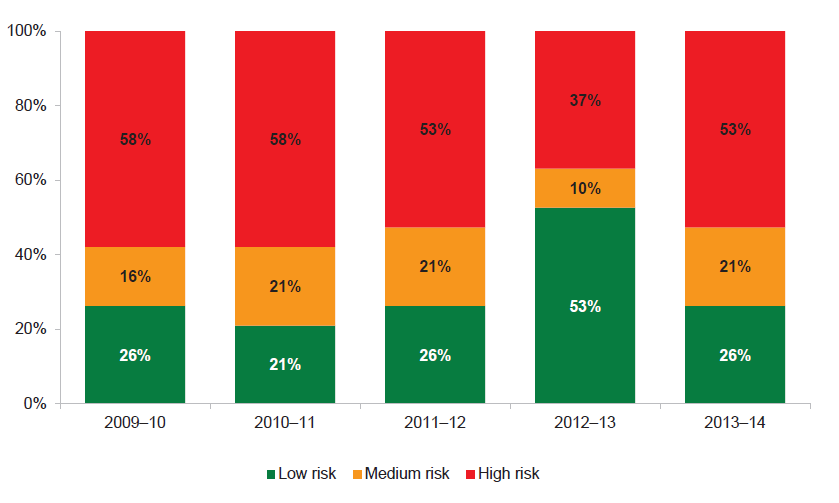
Note: 2012–13 risk rating percentages have been amended since our Water Entities: Results of 2012–13 Audits due to prior period restatements in financial statements, altering indicator results.
Source: Victorian Auditor-General's Office.
The percentage of entities with high liquidity risk increased by 16 per cent in 2013–14, which returns the industry back to the liquidity risk levels seen from 2009–10 to 2011–12. This reflects a more consistent picture of the liquidity risk faced by the water industry.
The strategy of accessing new borrowings at balance date to take advantage of a lower FAL distorted the results in 2012–13, where 53 per cent of water entities were rated as having a low liquidity risk.
5.3.3 Interest cover
Figure 5F shows that the average interest cover varied by sector across the five years.
Figure 5F
Average interest cover ratio

Source: Victorian Auditor-General's Office.
The metropolitan water entities maintained an adequate level of interest cover over the period. While their debt levels have increased by $111.6 million and finance costs by $198.2 million, they continue to generate positive cash flows from their operations annually.
All except two regional urban water entities experienced increases in their level of interest cover during 2013–14. The two regional urban water entities experienced a significant decline in their level of interest cover in 2013–14, as finance costs rose due to additional borrowings sought to fund capital works projects and other obligations.
The trend for the rural entities shows a level of volatility that reflects the small number of entities in the cohort—two entities. The financial performance and position of the two entities need to be considered individually as the results vary widely.
The trend of the rural water entities was quite different for each entity during 2009–10 to 2010–11. For these two years, Goulburn-Murray Water generated negative operating cash flows, where cash payments exceeded cash receipts. As a result, it had no interest cover. Goulburn-Murray Water was unable to service the finance costs associated with its existing debt from the cash flows generated by its day-to-day activities. It had to draw on new borrowings to pay operating costs.
Southern Rural Water, by comparison, generated positive operating cash flows over the period. Interest received also exceeded interest paid.
At 30 June 2014, both entities had adequate interest cover to meet ongoing interest payments.
In 2012–13, Southern Rural Water adopted the strategy of accessing new borrowings to take advantage of a lower FAL. The funds were held as cash at 30 June 2013 until needed for capital expenditure during 2013–14. The level of interest cover for Southern Rural Water reduced significantly during 2013–14 due to the use of the cash. This increase in borrowings also led to an increase in the level of interest payments. In addition, Southern Rural Water's net cash flow from operating activities declined.
Goulburn-Murray Water assumed responsibility of the food bowl modernisation project, now referred to as the Connections Project, on 1 July 2012. The Connections Project is being funded by the Commonwealth, and actual payments were greater than the level of project funding received in 2012–13. As a result, the entity generated a negative operating cash flow in 2012–13. In contrast, in 2013–14 funding for the Connections Project of $70.3 million was held at balance date. This contributed significantly to the high level of positive operating cash flow of Goulburn-Murray Water and the substantial increase in the level of cash on hand at 30 June 2014.
Figure 5G indicates that the interest cover risk was low for 79 per cent of water entities (15 of 19) at 30 June 2014, which was the same as 30 June 2013.
Figure 5G
Interest cover risk assessment
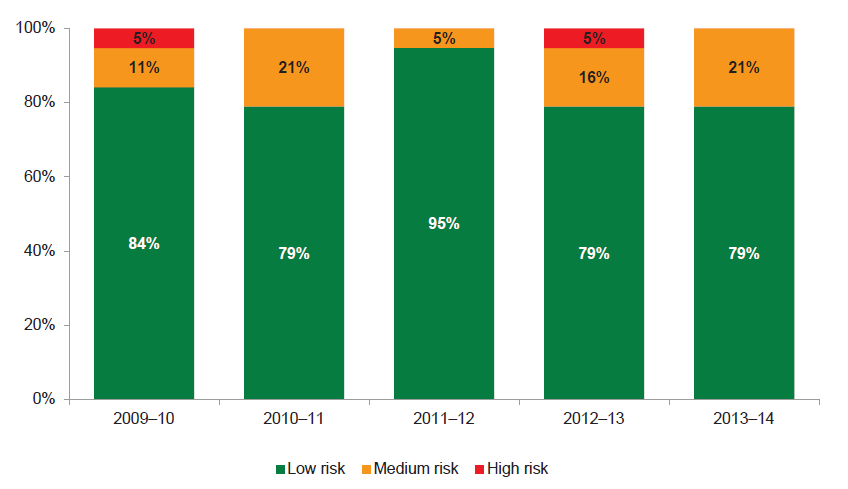
Source: Victorian Auditor-General's Office.
The number of entities in the high-risk category decreased between 2012–13 and 2013–14. Overall, a majority of entities within the sector have sufficient operating cash flow to meet interest payments.
5.3.4 Debt service cover
The water entities increased their interest-bearing liabilities, comprising borrowings and finance lease liabilities, by $7.6 billion or 109 per cent over the past five-years—$5.4 billion of this increase occurred in 2012–13 as a result of the desalination plant.
Figure 5H shows that the ability for regional urban water entities to repay debt from operating profits has decreased over the five years. In contrast, the rural water entities' ability to repay debt from operating profits improved from 2010–11 to 2012–13, declining in 2013–14.
Figure 5H
Debt service cover
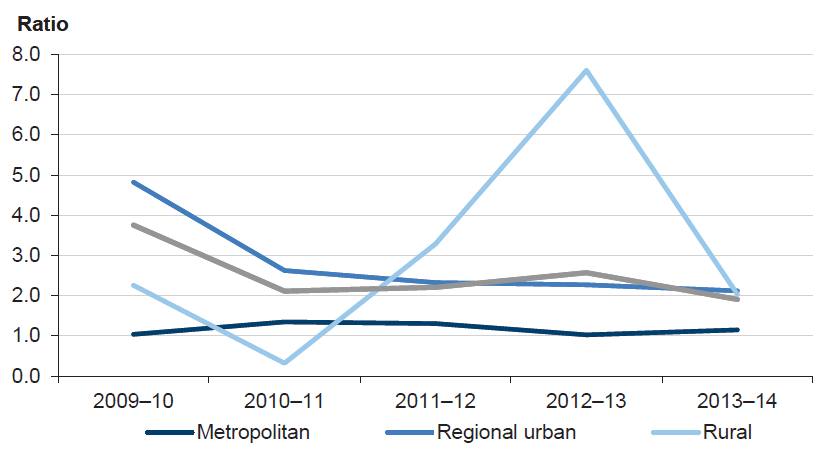
Source: Victorian Auditor-General's Office.
The decrease in the ability of the rural sector to service its debt from 2012–13 to 2013–14 is due to Southern Rural Water accessing new borrowings at 30 June 2013 to take advantage of a lower FAL. This increased their level of borrowings and associated costs during 2013–14.
There is no discernible trend over the five-year period for the metropolitan sector. The slight increase from 2012–13 to 2013–14 is mainly attributable to two metropolitan retail water entities.
However, caution is always required when interpreting these results as the outcome of the indicator may lead to a more favourable result for water entities when they do not repay or only repay small amounts of debt, and refinance large portions of debt—this could potentially result in a risk rating assessment of low for this indicator, which may not be appropriate.
Repayment of growing debt is a key challenge being faced by water entities. We plan to assess the extent of refinancing debt and its implications on financial sustainability more closely in future reports.
Over the five-year period, there has been a decline in the average debt service cover of the regional urban water sector from 4.82 to 2.12. This sector's ability to repay debt from operating profits has reduced because borrowings for the regional urban water sector increased by $796.4 million from 2009–10 to 2013–14, which has led to an increase in interest and debt payments by $182.7 million from 2009–10 to 2013–14.
Figure 5I shows the number of entities with a low debt service cover risk has declined between 2012–13 to 2013–14.
Figure 5I
Debt service cover risk assessment
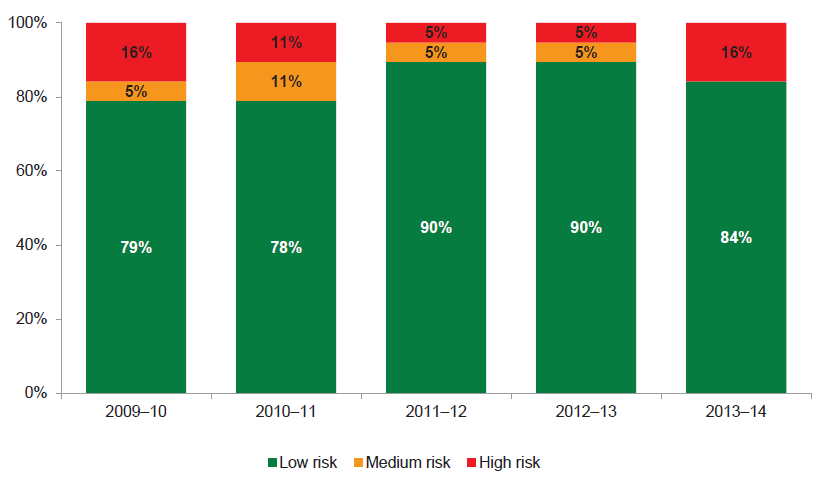
Source: Victorian Auditor-General's Office.
The number of water entities that are rated high risk increased from one to three. The two new water entities rated high risk are regional urban water entities that have had significant increases in their interest and debt payments from 2012–13 to 2013–14.
5.3.5 Debt-to-assets
Figure 5J presents the average debt-to-assets ratio by sector over the past five years. It shows that an entity's reliance on debt to fund its assets varies significantly depending on its sector.
Figure 5J
Debt-to-assets
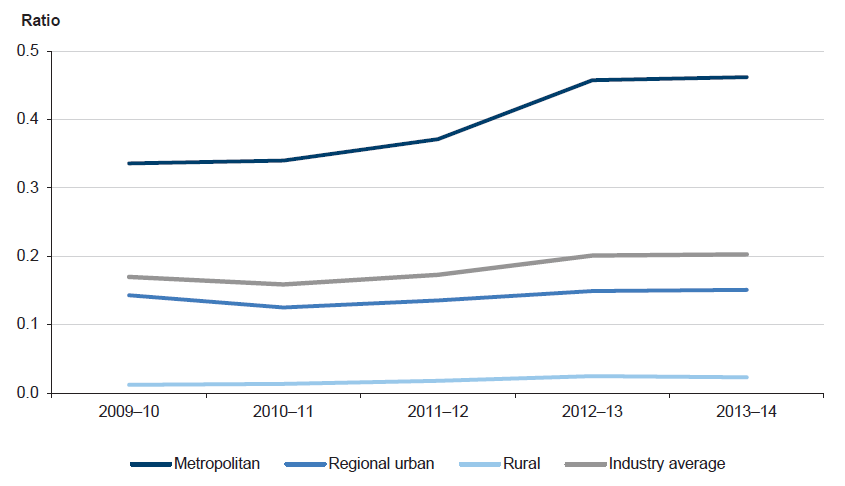
Source: Victorian Auditor-General's Office.
Over the five-year period, the rural entities maintained a low debt-to-assets ratio as they have not entered into significant borrowings. Regional urban entities increased their level of debt to fund the acquisition of new assets, and largely mirrored the trend in the industry average. Metropolitan entities continued to fund a larger proportion of their assets through debt.
During 2012–13, the large increase in the ratio for the metropolitan sector was largely driven by the recognition of the desalination plant assets.
The debt-to-assets ratio for rural water entities has been low and stable. As a cohort, rural water entities have minimal borrowings compared to water entities in the other sectors.
As regional urban and rural water entities have largely used borrowings to pay for fixed assets, the movement between 2012–13 and 2013–14 has been relatively smooth.
Figure 5K indicates that, with the exception of one entity, all entities maintained an adequate level of gearing over the period between 2009–10 and 2013–14.
Figure 5K
Debt-to-assets risk assessment

Source: Victorian Auditor-General's Office.
5.3.6 Self-financing
Figure 5L shows that over the five years, the average self-financing ratio fluctuated. However, the most recent year shows an upward trend for all sectors except for the metropolitan sector. A downward movement in the self-financing indicator signals that an entity's ability to fund new assets or replace existing assets using cash generated by their operations has declined—greater reliance therefore placed on the use of borrowings.
Figure 5L
Average self-financing indicator
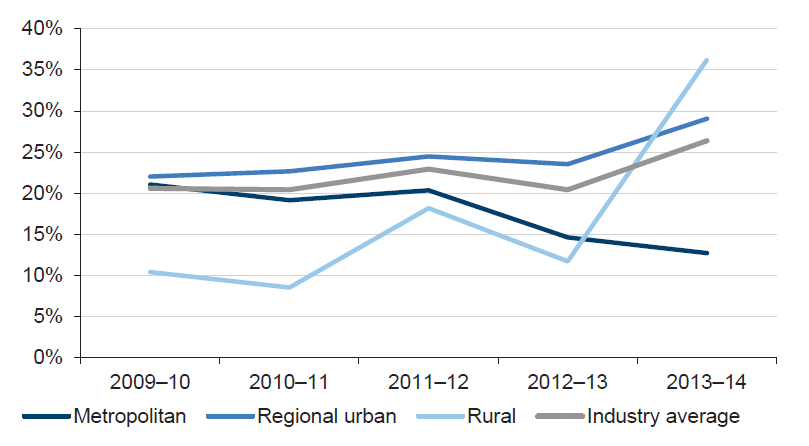
Source: Victorian Auditor-General's Office.
Over the past five-years, the metropolitan sector has seen a gradual downward trend. The metropolitan retail water entities have a large customer base and had increases in their service and usage charges during 2013–14, however, the increase was matched by an increase in bulk water and sewerage charges that the metropolitan retail water entities were required to pay to the metropolitan water wholesaler. The decline from 2012–13 to 2013–14 was due to increases in cash outflows relating to tax and finance costs of $35.7 million and the increase in the environmental contribution levy payments of $31.4 million.
Contrasting this is the positive change for the self-financing ratio for Melbourne Water. The bulk water and sewerage charges levied by Melbourne Water during 2013–14 factored in payments relating to the desalination plant costs compared to 2012–13, where Melbourne Water's prices did not have the full desalination plant costs factored into their prices.
Figure 5M shows that in 2013–14, the number of water entities with a high self‑financing risk remained the same, compared to an improvement in the number of water entities with a medium self-financing risk—two in 2013–14 compared to seven in 2012–13.
Figure 5M
Self-financing risk assessment
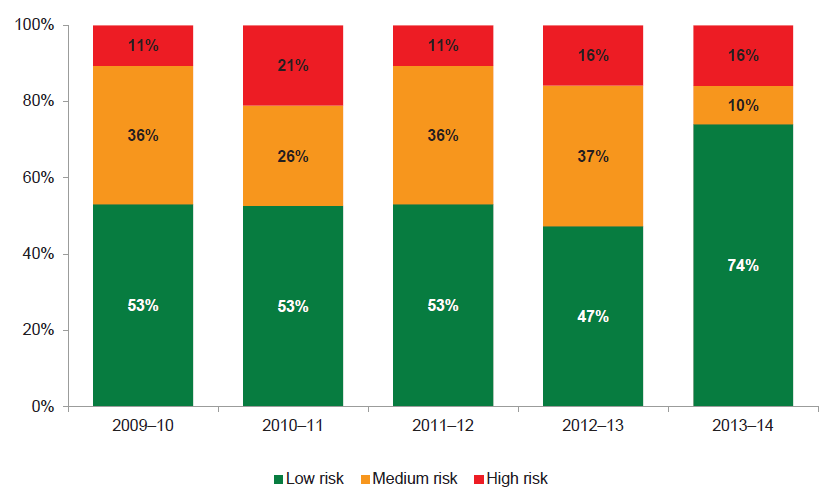
Note: 2012–13 risk rating percentages have been amended since our Water Entities: Results of 2012–13 Audits due to prior period restatements in financial statements, altering indicator results.
Source: Victorian Auditor-General's Office.
In 2013–14, all metropolitan retail water entities had a high self-financing risk. The two rural water entities had low self-financing risk, while only two regional urban water entities were rated medium risk, the remaining 11 had low self-financing risk.
5.3.7 Capital replacement
Figure 5N shows predominantly a downward trend for the average capital replacement indicator over the five years. The downward trend indicates that depreciation expense increased at a higher rate than the level of spending on infrastructure assets. However, caution is required when interpreting these results as revaluations affect the value of assets, which in turn affects the depreciation expense, and annual spending on assets includes new and expanded facilities in addition to existing facilities.
Figure 5N
Average capital replacement indicator
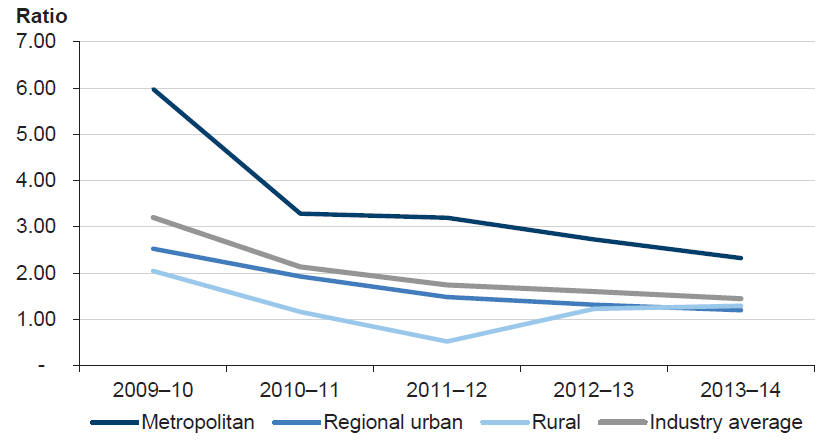
Source: Victorian Auditor-General's Office.
For the metropolitan water entities, the decline in 2010–11 reflected the impact of the revaluation of infrastructure assets in 2009–10. Depreciation expense increased significantly in 2010–11 as a result of the higher asset values.
Over the five-year period, there has been a noticeable decline in the average capital replacement ratio for the metropolitan water sector. Since these entities first commenced revaluing their assets, their asset revaluation reserve has grown to be $4.1 billion at 30 June 2014. The metropolitan water entities incur depreciation expense on the revalued assets and it will continue to negatively impact their capital replacement ratio.
For the regional urban and rural water entities, the decline in 2011–12 reflected the impact of the revaluation of their infrastructure assets in 2010–11. Depreciation expense increased in the year following the revaluations as a result of higher asset values.
Capital expenditure for regional urban water entities and the industry as a whole was high throughout the last regulatory period due to water shortages experienced from the beginning of 2008–09 though to 2012–13. Significant capital expenditure and a large number of capital projects were required to secure water resources.
For the rural water entities, since 2011–12 there has been a positive trend as the payments for capital exceeded depreciation and amortisation.
Figure 5O shows 32 per cent of water entities—five regional urban and one metropolitan—had a capital replacement indicator rated as high risk in 2013–14, which indicates their level of capital spending has not kept pace with the consumption of assets.
Figure 5O
Capital replacement risk assessment
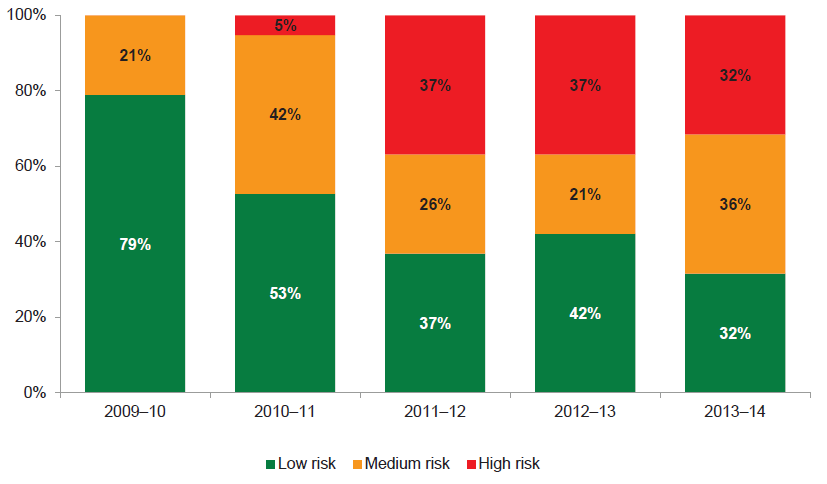
Note: 2012–13 risk rating percentages have been amended since our Water Entities: Results of 2012–13 Audits due to prior period restatements in financial statements, altering indicator results.
Source: Victorian Auditor-General's Office.
The shift over the five years from low to medium and high risk is significant and reflects the impact of higher depreciation following the revaluation of assets. It also indicates that spending on capital expenditure is less than depreciation, where water entities may not be replacing assets at a pace matching the consumption of assets.
5.3.8 Financial sustainability indicators and future approach
Each year, in conducting our assessment of the financial sustainability risk indicators, we have consistently used transactions and balances from water entities' signed financial reports. There can be differing accounting treatments, which are acceptable under the Australian accounting standards, that may result in variations when calculating indicator results between entities, or may impact ratio trend results and overall risk assessments. This may also impact comparability of indicator results.
As part of our on-going assessment of financial sustainability risks for the Victorian water sector, we plan to review the relevance of the financial sustainability risk indicators used, when planning for future reports.
We will assess whether the financial sustainability risk indicators we currently use remain the most relevant, or whether there are other additional indicators that could be used. For example, some of the financial indicators established for all water entities in 2013–14, as per the Ministerial Reporting Direction 01 Performance Reporting, may be instructive given these indicators are used by the Department of Environment, Land, Water and Planning and the industry to monitor financial performance. Further, a number of the financial indicators are included in the Department of Treasury and Finance's Corporate planning and performance reporting requirements Government Business Enterprises document released in October 2009, for public non-financial corporations, which may also be instructive. As part of this review we will also consider our existing indicators, such as the debt service cover indicator.
5.4 Matters impacting the sustainability results of water entities
The indicators selected in this report highlight risks to ongoing financial sustainability for a number of water entities. However, forming a definitive view of any entity's financial sustainability requires a holistic analysis that moves beyond financial considerations to include the water entity's ability to efficiently manage their operations, and the environment in which they operate—particularly the regulatory environment.
Understanding the regulatory environment is critical to assist in understanding why the financial sustainability indicator risk results, derived from the statutory financial reports of water entities are in some cases, less than desirable.
In this section, we look at the role of the Essential Services Commission (ESC) in the Victorian water industry, the current regulatory price setting framework and the impacts on the financial sustainability risk results of water entities.
5.4.1 Role of the Essential Services Commission
Since 1 January 2004, the ESC has been responsible for regulating and approving the maximum prices each water entity may charge its customers for the supply of water and the provision of sewerage services. The ESC sets prices in accordance with the requirements of the Essential Services Commission Act 2001, the Water Industry Act 1994, and the Water Industry Regulatory Order. The ESC has approved prices for metropolitan and regional urban businesses from 1 July 2005 and for rural businesses from 1 July 2006.
Its role includes the regulation of prices and monitoring of service standards, and market conduct.
The Essential Services Commission Act 2001 states that the ESC's objective is to promote the long-term interests of Victorian consumers with regard to the price, quality and reliability of essential services.
In order to achieve this, the ESC needs to take into consideration:
- efficiency in regulated industries and incentives for long-term investment
- the financial viability of regulated industries
- existing and potential competition within the industry
- the relevant health, safety, environmental and social legislation applying to the regulated industry
- the benefits and costs of regulation for consumers—including low income or vulnerable consumers—and regulated entities
- consistency in regulation between state jurisdictions and on a national basis.
Taking this into consideration, the ESC have conducted a water price review every three to five years since 2004. As part of this review, water entities are required to provide the ESC with a water plan. The ESC then determines the maximum prices for each water entity's prescribed goods and services that also allow a water entity to remain financially viable.
Water Plan 2, 2008–09 to 2012–13
Water Plan 2 covered the period from 2008–09 to 2012–13. It provided for substantial increases in water prices to fund significant capital works, with price increases generally higher in the early years.
Water Plan 3, 2013–14 onwards
In October 2012, the 19 water entities submitted water plans that covered the period 1 July 2013 to 30 June 2018 to the ESC for assessment.
Each entity was required to set out in its plan:
- expected costs of delivering water and sewerage services
- planned capital works programs
- forecast volumes of water to be delivered
- level of service to customers
- proposed prices that would raise sufficient revenue to recover expected costs.
The ESC assessed the proposed prices and revenue against the regulatory principles set out in the Water Industry Regulatory Order 2012 (WIRO 2012).
The ESC's final price determinations in relation to Water Plan 3 were released in June 2013. They apply from 1 July 2013 to 30 June 2018—or when the ESC makes a new determination—for all entities except Goulburn-Murray Water and Melbourne Water. The determinations of Melbourne Water and Goulburn-Murray Water cover a three-year period to 30 June 2016.
Overall, the ESC's final decision reduced the water entities' proposed revenue by:
- $1 billion for metropolitan water entities—this includes revenue estimates for years four and five for Melbourne Water
- $200 million for regional urban water entities
- $13 million for rural water entities.
The ESC assessed that water entities were able to deliver services at a lower cost and thus adjusted the water entities' proposed:
- operating expenditure—e.g. labour
- productivity improvements
- capital programs and, therefore, financing costs.
Under the WIRO 2012, water entities can propose different forms of price control. The various forms of price control have advantages and disadvantages in terms of risk sharing between entities and their customers, price certainty for customers and the water entities' ability to adjust prices to reflect changed circumstances. Refer to Appendix G for the definitions of the various forms of price controls.
The average price increase for each water sector over the third regulatory period, excluding the impact of inflation, are shown in Figure 5P.
Figure 5P
Average price increase for water entities from the third regulatory period
|
Water sector |
Average change (per cent) |
|---|---|
|
Metropolitan retailers |
22.20 |
|
Regional urban |
1.27 |
|
Rural |
0.75 |
Source: Victorian Auditor-General's Office.
Pricing submissions moving forward
As noted in Part 1 of this report, on 23 October 2014, the Water Industry Regulatory Order 2014 (WIRO 2014) was released in the Victoria Government Gazette, following approval from the Governor in Council.
It revokes the WIRO 2012 and will impact the next period of price regulation for the water entities and all future price submissions.
5.4.2 Regulatory framework and its impact on financial sustainability risks
Water prices are determined based on what revenue water entities require to meet service obligations and expected outcomes.
Under the regulatory regime, regulatory values rather than the statutory values are used to determine the total revenue required by an entity. This is based on efficient costs to operate, maintain and replace assets, and ultimately leads to price setting. The statutory values are the values reported by an entity within its statutory financial report.
The Regulatory Asset Value (RAV) is reflected in the price that a water entity can charge its customers, while the Statutory Asset Value (SAV) is not.
The opening RAV was set by the then Minister for Water on 1 July 2004 with reference to the operating cash flow generated by the water entities. The values are adjusted each year by the ESC to recognise new capital investments, regulatory depreciation and asset disposals, if the ESC is satisfied that it is efficient expenditure.
The RAV for regional urban and rural water entities is significantly lower than the SAV as assets that existed prior to 1 July 2004 were assigned between approximately 0–2 per cent value for rural water entities and between 1 and 45 per cent—average approximately 28 per cent—of the existing asset base for regional urban water entities. The RAV for metropolitan water entities was set at between 90 and 100 per cent.
The revaluation of infrastructure assets in recent years has significantly increased the value of assets reported within the statutory financial reports of the 19 entities, with a consequential increase in depreciation expenses. This results in an even greater difference between RAVs and SAVs and magnifies the shortfall between the price levied and the revenue required to meet total operating costs for some water entities.
Accordingly, the difference between the RAVs and the SAVs is a key factor in the operating losses reported by a number of the regional urban and rural water entities in their financial reports, and some of the less than desirable financial sustainability risk results included in this report.
To illustrate the disparity between the regulatory and statutory frameworks, we have set out differences between the regulatory values, per the last two price determinations, and statutory values per the published financial statements.
It is important to note that regional urban and rural water entities had their last two ESC Water Price Reviews in 2008 and 2013, and metropolitan water entities had their ESC Water Price Reviews in 2009 and 2013.
We have focused on reporting the variances for fixed assets and depreciation, as these are the areas where significant disparity exists.
Fixed assets
Figure 5Q shows a comparison of the RAV and SAV for all water entities. It shows for all water entities, a difference between the RAV and SAV, and the increase that has occurred across the previous two ESC Water Price Reviews.
RAV increased from the price determination in 2008/2009 to the 2013 price determination, however, not as significantly as the SAV balance, which nearly doubled. This is a result of asset additions that are recognised in the SAV balance but not included in the RAV balance, as these asset additions are not considered when calculating return on assets and regulatory depreciation. Another factor that has contributed to the divergence between the RAV and SAV is the revaluation of assets, where the revaluation increment is recognised in the statutory financial statements, however, not taken into account under the regulatory model.
This difference between RAV and SAV is expected to increase in the future as the water entities continue to incur capital expenditure and undertake asset revaluations that are not recognised as part of the regulatory framework.
Figure 5Q
Comparison of RAV and SAV relating to fixed assets for all water entities for the last two Water Price Reviews

Note: The RAV represents the gross amount specified in the ESC Water Price Review 2008 for regional urban and rural water entities, and ESC Water Price Review 2009 for metropolitan water entities. The ESC Water Price Review 2013 relates to all water entities, which is expressed in 2013 dollars.
Note: The SAV for the 2008 or 2009 reflects actual amounts based on signed financial reports for 30 June 2009 for regional urban and rural water entities and 30 June 2010 for metropolitan water entities. The SAV for 2013 reflects actual amounts based on signed financial reports for 30 June 2014, however, excludes desalination plant assets of $4.5 billion under finance lease, as these are not included in the 2013 RAV.
Source: Victorian Auditor-General's Office.
With regards to the metropolitan water entities, prior to 2009–10 the RAV and SAV were close. Metropolitan water entities are for-profit entities and as such value their fixed assets using the income approach (a discounted cash flow analysis).
Asset additions and revaluations between regulatory periods have contributed to a gap between RAV and SAV. This is shown in Figure 5R.
Figure 5R
Comparison of RAV and SAV relating to fixed assets for metropolitan water entities for the last two Water Price Reviews
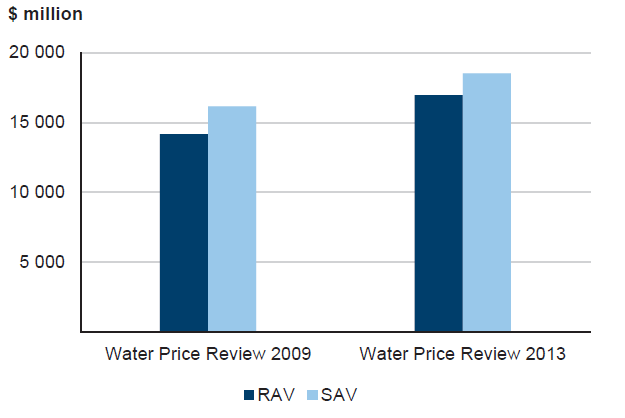
Note: The RAV represents the gross amount specified in the ESC Water Price Review 2009 and ESC Water Price Review 2013 metropolitan water entities, which is expressed in 2013 dollars.
Note: The SAV for the Water Price Review 2009 reflects actual amounts based on signed financial reports for 30 June 2010 for metropolitan water entities. The SAV for the Water Price Review 2013 reflects actual amounts based on signed financial reports for 30 June 2014, however, excludes desalination plant assets of $4.5 billion under finance lease, as these are not included in the 2013 RAV.
Source: Victorian Auditor-General's Office.
The difference between RAV and SAV for regional urban and rural water entities since 2008–09 has always been large. As shown in Figure 5S and Figure 5T respectively, the difference only became greater when regional urban and rural water entities revalued their fixed assets in 2010–11.
Particularly for rural water entities, it shows how prices set using RAV do not cover total capital expenditure—this is partly due to some capital expenditure not relating to a rural water entity's regulated services, where some is funded separately by government.
Figure 5S
Comparison of RAV and SAV relating to fixed assets for regional urban water entities for the last two Water Price Reviews
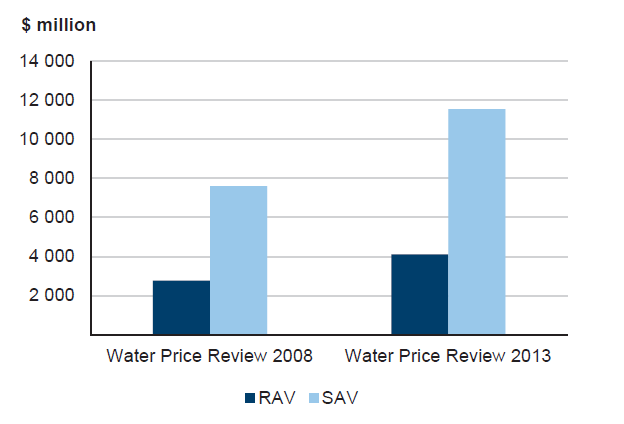
Note: The RAV represents the gross amount specified in the ESC Water Price Review 2008 and ESC Water Price Review 2013 for regional urban water entities, which is expressed in 2013 dollars.
Note: The SAV for the Water Price Review 2008 reflects actual amounts based on signed financial reports for 30 June 2009 for regional urban water entities. The SAV for the Water Price Review 2013 reflects actual amounts based on signed financial reports for 30 June 2014.
Source: Victorian Auditor-General's Office.
Figure 5T
Comparison of RAV and SAV relating to fixed assets for rural water entities for the last two Water Price Reviews
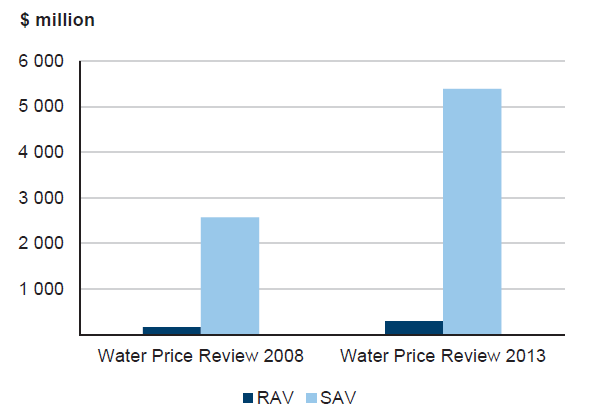
Note: The RAV represents the gross amount specified in the ESC Water Price Review 2008 and ESC Water Price Review 2013 for rural water entities, which is expressed in 2013 dollars.
Note: The SAV for the Water Price Review 2008 reflects actual amounts based on signed financial reports for 30 June 2009 for rural water entities. The SAV for the Water Price Review 2013 reflects actual amounts based on signed financial reports for 30 June 2014.
Source: Victorian Auditor-General's Office.
Depreciation
Regulatory depreciation is included in the ESC's calculation to determine what the benchmark revenue requirement of an organisation is and, therefore, forms part of the pricing model.
Depreciation is driven by the value of fixed assets. Increases to the value of fixed assets would lead to increases to the depreciation expense.
Figure 5U shows the increasing difference between regulatory depreciation expenditure value (REV) and statutory depreciation expenditure value (SEV) relating to depreciation for all water entities across the last two ESC Water Price Reviews.
Figure 5U
Comparison of REV and SEV relating to depreciation for all
water entities for the last two Water Price Reviews
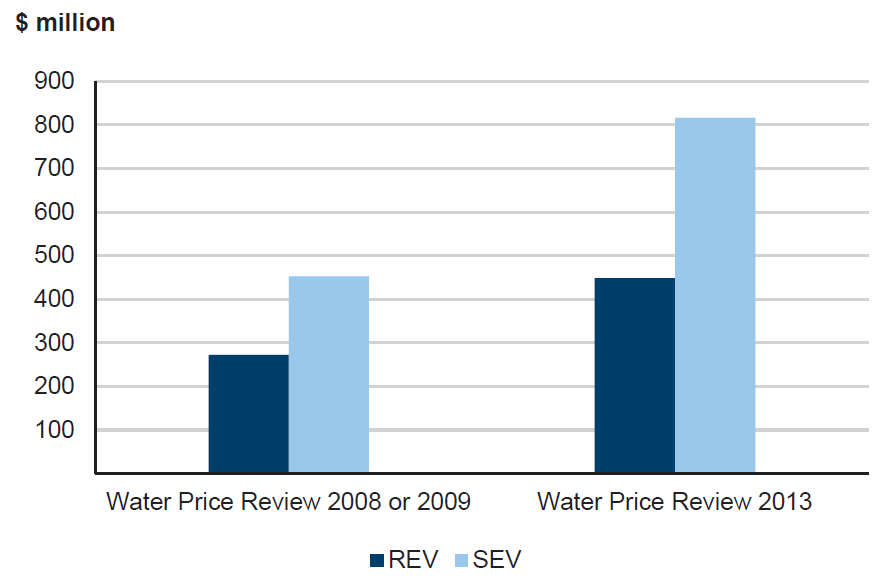
Note: The REV represents the gross amount specified in the ESC Water Price Review 2008 for regional urban and rural water entities, and ESC Water Price Review 2009 for metropolitan water entities. The ESC Water Price Review 2013 relates to all water entities, which is expressed in 2013 dollars.
Note: The SEV for 2008 or 2009 reflects actual amounts based on signed financial reports for 30 June 2009 for regional urban and rural water entities and 30 June 2010 for metropolitan water entities. The SEV for 2013 reflects actual amounts based on signed financial reports for 30 June 2014, however, excludes the impact of depreciation from desalination plant assets under finance lease of $77.6 million.
Source: Victorian Auditor-General's Office.
The SEV for depreciation is more than double the REV when looking at the last price review. This indicates that the benchmark revenue requirement determined by ESC, which is used to determine water prices that water entities can charge its customers, does not cover the level of depreciation that water entities incur. This is a contributing factor to the less than desirable results of the financial sustainability risk indicators for certain water entities.
5.4.3 ESC regulatory asset value and pricing paper
The ESC commissioned a review by NERA Economic Consulting (NERA) to set out the principles associated with RAV and pricing for water entities. The ESC released Assessing the financial viability of Victorian water businesses (the report), which summarises views and proposed indicators in June 2014.
The report explains that the initial RAVs were set by the then Minister for Water under a 'set and forget' approach. This meant that the regulatory value of assets as at 1 July 2004 were locked in and the value of these assets would not be changed in the future. The initial RAV would then be rolled forward annually to reflect new investments, depreciation and asset disposals. SAVs are based on accounting standards.
The reasons for the differences in how RAV and SAV are calculated are:
- regulatory accounts of water entities only include values for those assets that are used for the provision of services regulated by the ESC, whereas the SAV includes all assets owned by the water entity no matter if it is used directly in the provision of regulated services
- the initial RAV was determined on a 'set and forget' basis to enable price stability while the SAV can be revalued
- developer contributions and gifted assets are excluded from the RAV as there is no cost to acquire them, but are included in the SAV, which increases depreciation costs.
The report concluded that it is neither necessary nor desirable that the RAV and SAV are equal or become equal over time.
6 Audit committees
At a glance
Background
This Part presents the results of our assessment of the 19 water entity audit committees, including how they oversee an entity's control environment, accountability of senior management and key outputs, and their relationship with internal and external audit.
Conclusion
Our review of the audit committee function at the 19 water entities shows a satisfactory situation, where the role is being carried out effectively. We did identify opportunities for improvement in audit committees' engagement with internal and external auditors, the nature and conduct of self-assessments and fraud reporting. We also identified elements of audit committee charters that require enhancement to reflect better practice.
Findings
All 19 water entities had an approved audit committee charter with most of the better practice elements included, had independent members, reviewed financial and performance reports and maintained a tracking register of issues raised by internal and external audit. Some audit committees did not provide internal and/or external audit with a standing invitation to attend audit committee meetings, access to committee papers prior to meetings, or invite them to attend the entire meeting.
Recommendations
That water entities where relevant:
- enhance their audit committee charters to incorporate all better practice requirements
- require audit committees to specifically conduct, at least annually, a self-assessment of their performance
- enhance fraud reporting to audit committees
- provide internal and external auditors with open invitations to attend committee meetings and access to committee documentation for upcoming meetings
- require audit committees to develop a process for assessing recommendations of relevance to them in VAGO performance audits.
6.1 Introduction
The standing directions issued by the Minister for Finance, pursuant to the Financial Management Act 1994 (FMA), require each entity to have an audit committee.
The audit committee plays a significant role in assisting a governing board to fulfil its governance, oversight and accountability responsibilities.
In this Part, we comment on the effectiveness of audit committees in discharging their responsibilities, including how they oversee an entity's control environment, accountability of senior management and key outputs, and their relationship with internal and external auditors.
To be fully effective, an audit committee must be independent from management and free from any undue influence. Members of the audit committee should not have any executive powers, management functions or delegated financial responsibility.
The standing directions stipulate each audit committee must have:
- at least two independent members
- a charter that clearly sets out the role, responsibilities, composition, structure and membership requirements
- adequate, appropriate resources
- direct access to management, external and internal audit, and experts.
6.2 Conclusion
Our review of the audit committee function at the 19 water entities show a satisfactory situation, where the role is being carried out effectively.
We did identify opportunities for improvement to audit committees' engagement with internal and external auditors, nature and conduct of self-assessments and fraud reporting. We also identified elements of audit committee charters that require enhancement to reflect better practice.
6.3 Audit committee framework
Key objectives of an audit committee are broadly to:
- assist the governing board to maintain an adequate internal control environment
- review annual financial reports and assess their completeness and consistent application of entity accounting policies, assess whether accounting policies used are reasonable and comply with relevant financial reporting frameworks and recommend the signing of the financial reports
- review annual performance reports and assess their completeness, accuracy and compliance with legislative requirements
- recommend and monitor internal audit programs, endorse the external financial audit program, assess the effectiveness of these functions and administer internal and external audit findings and recommendations
- review risk management, compliance with legislation, relevant regulations and ethics.
The key elements of an effective audit committee framework are detailed in Figure 6A.
The framework draws upon the:
- Standing Directions of the Minister for Finance under the FMA
- Australian National Audit Office's Public Sector Audit Committees – Independent Assurance and Advice for Chief Executives and Boards Better Practice Guide, August 2011.
Figure 6A
Key elements of an effective audit committee
|
Component |
Key elements |
|---|---|
|
Audit committee charter |
Established audit committee charter, including references to:
|
|
Governance and oversight |
|
|
Involvement with internal and external audit |
Oversight of internal audit:
Oversight of external audit:
Committee tracks all audit issues—internal and external—in a register. Issues register includes:
|
Source: Victorian Auditor-General's Office.
6.4 Audit committee charter, composition and membership
Audit committee charter
The audit committees at all 19 water entities had an approved audit committee charter with many of the better practice elements included. The following were consistently covered in the charters of the majority of water entities:
- the role, responsibilities, composition, structure and membership requirements of the audit committee
- annual evaluation of its performance
- oversight of the risk management framework
- oversight of the internal control framework
- internal audit function
- external audit function
- monitoring of the status of issues raised by internal and external auditors and other reviews
- monitoring compliance with laws and regulations
- consideration of the financial and performance report sign off.
The following elements were not consistently included in charters—we encourage water entities to consider inclusion of these items in charters to reflect better practice:
- preparation of an annual program
- preparation and circulation of agendas and papers
- declarations of conflicts of interests and pecuniary interests.
Committee role and composition
The audit committees oversaw matters of accountability and internal controls, and had direct access to management. Most audit committees had at least three members.
Better practice requires that an audit committee should have an independent chair and comprise a majority of independent members. Independent committee members can provide a range of experience and capabilities as well as provide unbiased advice to the water entity and challenge established thinking and approaches.
The independent members of all water entities are all non-executive board members, with the exception of one water entity which has two independent members who are not board members—these members were appointed to provide different insight and contribute to circumstances with complete independence from the entity.
We encourage this further degree of independence.
Skills and experience
A majority of members of audit committees were suitably qualified or had the appropriate experience in:
- water utility industry
- financial literacy
- risk management
- project and program management.
Induction training was provided at all 19 water entities to integrate new committee members to the business, its operations, background and culture to enable them to better understand their duties and responsibilities.
Conflicts of interest
An audit committee should establish procedures that address requirements for dealing with actual and/or perceived conflicts of interest, such as annual declarations certifying any potential, perceived or actual conflicts of interest, regular updates where circumstances change and address conflict of interest issues as a standing agenda item at each committee meeting.
Failure to declare conflicts of interests in line with charter's requirements or better practice can affect the ability of audit committee members to avoid conflicts and increase the risk of undue or inappropriate influence.
At all water entities, the audit committee members are required to disclose conflicts of interest at the commencement of each audit committee meeting. Apart from the one water entity that has two members of the audit committee who are not members of the board, all other committee members complete conflict declarations as part of their role as a board member. Given the membership structure, declarations at the board level are deemed satisfactory.
Self-assessment
To assist audit committees to discharge their duties in accordance with their charter and to identify areas for improvement and enhance their contribution to the organisation, it is important that a regular assessment of their function is conducted. This is generally done via a self-assessment, annually, with additional input from key stakeholders where considered relevant.
Of the 19 audit committees:
- 13 (68 per cent) conducted a self-assessment of their performance in the past 12 months
- two (11 per cent) only required the audit committee chair to complete a self‑assessment.
Of the four remaining water entities, two conducted the self-assessment as part of the boards' self-assessment, and the other two did not have members of the audit committee conduct the self-assessment—instead members of management, the managing director and/or the board chair completed an assessment of the audit committee's performance. This latter arrangement is not better practice.
We support the audit committees that conduct comprehensive self-assessments on an annual basis, as it aids committee members to directly assess the committee's strengths and weaknesses and allows for future improvement. Involving stakeholders in parts of the review also allows for further feedback on the effectiveness of the committee and enhances functionality.
We encourage all water entity audit committees to specifically conduct a self‑assessment of their performance at least annually. Consideration of feedback from other key stakeholders is also recommended.
6.5 Committee functions
Addressing compliance requirements
One of the functions of an audit committee is to evaluate how effective the water entity is in monitoring its compliance with relevant legislation, regulations and associated government policies.
Audit committees review arrangements that are in place, including management sign‑offs and attestations relating to compliance with:
- Financial Management Compliance Framework—100 per cent
- Australian/New Zealand Risk Management Standard AS/NZS 31000:2009—100 per cent
- taxation compliance and concessions—100 per cent
- purchasing card rules for use and administration—100 per cent
- treasury management guidelines – annual certification of compliance—95 per cent
- insurance arrangements—89 per cent.
We support the above practices.
Review of internal controls
Audit committees are responsible for the oversight of the adequacy of an entity's internal control environment.
A majority of audit committees have sought management assurances, and relied on internal audit, and other assurance mechanisms to gain comfort over the operation of the internal control regime.
A majority of audit committees demonstrated an understanding of their relevant water entity's internal controls. The level of understanding is more pronounced where the audit committee is involved in:
- reviewing, approving and/or endorsing the water entity's financial/accounting policies and procedures for approval to the governing board—95 per cent
- ensuring that delegations of authority and responsibility of individuals are approved and up-to-date—84 per cent
- reviewing the adequacy of financial and other key controls for all new systems, projects and activities—79 per cent
- periodically assessing the effectiveness of key internal controls, via internal audit and/or special reviews—100 per cent.
Audit committees should continue their involvement in the monitoring and oversight of such matters.
Review of financial reports
The review of a water entity's financial statements is an important responsibility of the audit committee. To be able to acquit this responsibility, audit committees should be advised about, and consider any significant financial reporting issues identified by management and/or external audit throughout the year. This would include accounting and financial reporting issues identified by management, internal audit or external audit. This enables timely resolution of issues to avoid adverse impact on an entity's ability to prepare its financial report within the legislative time frames.
Our review found that timetables were established at all 19 water entities for the preparation and review of the annual financial statements to allow sufficient opportunity for the audit committee, managing director and board to meet their responsibilities.
The process by which audit committees gained comfort from management over accounting judgements and significant and non-recurring transactions, events or adjustments that impacted on the financial report varied across the water sector, where the audit committees either:
- received verbal management representations during the August committee meeting
- received written attestations from management at the August committee meeting
- received papers discussing specific accounting positions and judgements made by management prior to June or at the August committee meeting
- had regular consultation between management and audit committee chairs during the year end process.
We encourage all water entities to:
- provide their audit committees with:
- accounting position papers as early as possible
- written attestations to support key elements in the financial report and/or elements of the financial reporting preparation and finalisation process
- establish regular communication with audit committee chairs regarding contentious financial reporting issues, as these processes allowed for more efficient and effective outcomes during year end.
As mentioned in Part 2, all water entities met the legislated financial reporting time frame.
Review of performance reports
Water entities are required to prepare and have audited a performance report that complies with Financial Reporting Direction (FRD) 27C Presentation and Reporting of Performance Information. The audit committees at all 19 water entities reviewed the performance report during their August meeting.
As mentioned in Part 3, all water entities met the performance reporting time frame. We encourage water entities to provide performance reports to audit committees as early as possible to allow for a timely and robust review.
Consideration of fraud
Audit committees should have active oversight over the framework for the prevention and avoidance of fraud. The audit committee should constantly challenge senior management to ensure that the risk of fraud is considered and assessed, that preventative and detective controls have been established to identify potential fraud and ensure that investigations are undertaken if fraud is detected.
The audit committee should take a strong interest in ensuring that appropriate action is taken in response to actual fraud events.
Of the 19 water entities, we note that 15 audit committees received regular reporting of fraud risks. The remaining four received reports relating to fraud risk on an exception basis—that is, only when there is a change to the fraud risk.
Thirteen audit committees received the annual report relating to suspected, alleged or actual frauds required under section 4.5.4 of the Standing Directions of the Minister for Finance. Management at the remaining six entities only provide confirmation to their audit committee relating to the section 4.5.4 annual report when instances have been reported—nil returns were not communicated to the committees.
Better practice would result in audit committees always receiving the section 4.5.4 annual report or notification of a nil return.
Risk management
Audit committees can provide assurance to the managing director and governing body that the risk management framework put in place by management is appropriate and operating effectively. Of the 19 water entities, 17 audit committees were discharged with the responsibility of risk management. The remaining water entities had separate committees that dealt with the risk management function.
Our review found that all audit committees with risk management oversight:
- understood the governing body and managing director's approach and attitude to the entity's:
- management of risks
- assessment of risk
- displayed an understanding of the arrangements in place for the management of the entity's risks, particularly high-rated risks
- dedicate sufficient time to risk management during their meeting.
We encourage audit committees to continue to take on the responsibility of risk management duties where possible, as it provides members with insight into critical aspects of operations, established controls and mitigation plans that can greatly assist them in carrying out their duties as audit committee members.
6.6 Relationship with internal and external audit
Relationship with internal audit
An audit committee's relationship with internal audit is important in aiding the committee to achieve their key objectives—an open relationship and clear reporting line needs to be established.
The internal audit function is responsible directly to the audit committee. Their work can assist audit committees to understand the operational effectiveness of a water entity's internal control environment and overall performance.
We identified that 18 of the 19 water entity audit committees are involved in the review and/or approval of the internal audit charter. The remaining water entity had not established a separate internal audit charter.
Each committee is involved in the preparation of the annual internal audit plan. A number of varying processes exist across the sector with respect to such plans, to note are:
- prioritising mandated annual compliance audits
- emphasis on high-risk areas
- focusing on areas which have not been subject to an independent review in prior years
- discussions/consultation with management, the managing director and audit committee chairs regarding what they perceive would warrant an internal audit to be performed
- completing a mapping exercise of key risks and what assurance reviews are done to provide comfort that the risks are managed.
Rigorous review of internal audit reports takes place with audit committees, as evidenced from internal audit attendance at audit committee meetings where they:
- query and challenge findings and action plans detailed within the internal audit report with management and the internal auditor
- follow up on the status and resolution of issues identified
- follow up on the status of queries made at subsequent meetings.
An assessment of internal audit's performance occurs either on an ad hoc basis, annually or once every three years.
We found that 16 of the 19 audit committees did provide a standing invitation for internal auditors to attend committee meetings.
The audit committees at two water entities that did not provide their internal auditors with a standing invitation, was due to logistical reasons. The remaining audit committee did not believe that the internal auditor should be provided with a standing invitation to committee meetings.
Of the 16 audit committees that provided a standing invitation for internal auditors, 15 allowed internal auditors to stay for the duration of the meetings, at their discretion. The final water entity did not believe that the internal auditor should remain for the duration of committee meetings.
Internal auditors of 17 water entities were provided with audit committee papers and agendas prior to the meetings being held.
The remaining two audit committees did not believe that internal auditors should have access to other documentation included in their papers until the papers had been endorsed by the audit committee and/or the board.
The above findings do not represent best or contemporary practice.
Relationship with external audit
An open relationship between the audit committee and external audit is important for both parties to achieve their responsibilities and desired outcomes. All key outputs provided by external audit, such as audit strategies, management letters and closing reports, should be critically reviewed by the audit committee to allow a full understanding of the nature and extent of the audit approach.
A standing invitation should also be made to the external auditors to attend all committee meetings at their discretion, and they should be provided with committee meeting papers within sufficient time prior to a meeting to enable them to fully contribute to audit committee meetings.
Assessing an entity's governance arrangements and culture is integral to an effective financial audit. The opportunity to review committee papers prior to meetings is necessary to provide insight into the entity which is critical to the auditor's understanding of the audit. These documents are also critical to the successful conclusion of the audit. Attending the full committee meeting is also an important element in gauging an entity's governance practices and enables the audit team to deal with emerging issues in a timely way.
All of these matters are indicative of having an open and transparent relationship with external audit.
All 19 audit committees were involved in the discussion and review of key external audit outputs—the audit strategy, management letter and closing report.
Four of the 19 audit committees did not provide external audit with a standing invitation to attend all committee meetings, nor did they provide audit committee papers and agendas prior to the meetings. Further, three of these audit committees did not extend an invitation to allow external audit to remain for the duration of meeting, one was allowed to stay for the duration of the meeting.
In these instances, auditors were only invited to audit committee meetings to briefly present a key output, such as an audit strategy, management letter or closing report.
In most instances, the audit committees encouraged management to provide external audit with full and free access to all records and information required to conduct audit procedures.
The above findings do not represent best or contemporary practice.
Tracking of issues raised by internal or external audit
It is important that audit committees review actions taken by management to respond to recommendations made by both internal and external audit.
Actions taken by management to address the recommendations need to be completed within an agreed time frame. The audit committee should monitor management's implementation of recommendations, and where significant delays are encountered, hold management to account.
Where internal and/or external audit reported control weaknesses or other issues to the audit committee via management letters or reports, we identified that committees:
- appropriately challenged their findings—at 18 of 19 water entities
- inquired about the cause of the audit issues with management—at all water entities
- ensured that they were satisfied that any remedial action proposed and implemented by management addressed the audit issues— at all water entities
- monitored the status and implementation of audit recommendations—at all water entities
- ensured that audit issues were addressed by management in a timely manner—at all water entities.
It is pleasing to note that all 19 audit committees monitor the status and implementation of recommendations raised by internal and external audit. The level and degree of monitoring varies, with some audit committees receiving:
- quarterly, six-monthly or yearly updates on open issues
- status update and details of all open issues
- summarised lists of open issues
- details of issues that have recently been resolved
- details of long outstanding open issues
- details of why issues are not resolved within the agreed time frame.
We support the reporting on the status of audit recommendations on a regular basis—quarterly. These reports should provide sufficient detail to allow the committee to understand the actions taken against the relevant recommendations, and where issues have not been resolved within the agreed time frame, provide detail as to why and a revised time frame.
In Part 2.4, we make comment on the status of management action plans to internal control weaknesses identified in prior year financial audits.
Monitoring and consideration of recommendations from VAGO performance audits
VAGO performance reports can be directly related to a water entity, sector specific or across government. The reports include better practice elements and recommendations relating to internal controls and other matters that may assist the water entity to improve their internal controls or operational performance.
We found that 89 per cent of audit committees stayed abreast of VAGO performance reports that were:
- directly related to the water entity
- sector specific
- across government.
We support this current practice and encourage all water entity audit committees to adopt such reporting.
Recommendations
That water entities, where relevant:
- enhance their audit committee charters to incorporate all better practice requirements, such as developing an audit committee annual program, preparation and circulation of agendas and papers, and addressing requirements and nature of how declarations of conflicts of interest and pecuniary interests are conducted
- require audit committees to specifically conduct, at least annually, a self‑assessment of their performance
- enhance fraud reporting to audit committees including the annual report of suspected, alleged or actual frauds
- provide internal and external auditors with open invitations to attend committee meetings and provide access to committee documentation for upcoming meetings
- require audit committees to develop a process for assessing recommendations of relevance to them in VAGO performance audits to stimulate improvements in controls or operational performance.
7 Gifts, benefits and hospitality
At a glance
Background
Between 2012–13 and 2013–14 the number of gifts, benefits and hospitality offered and/or accepted by the four metropolitan water entities increased from 423 in 2012–13 to 588 in 2013–14. This Part presents the results of our assessment of management practices and oversight of gifts, benefits and hospitality at these entities.
Conclusion
Overall, the four metropolitan water entities had the minimum required processes in place, which are appropriate to manage the receipt of gifts, benefits and hospitality, however, opportunities exist to improve policies and procedures.
Findings
- Policies and procedures were in place, however these should be reviewed to ensure greater consistency with the Victorian Public Sector Commission's framework and the the former Department of Environment and Primary Industries' (DEPI) model policy and guidance.
- Gift registers are maintained by all four metropolitan water entities, but the level of detail recorded in the registers varied between each entity.
- Training is provided to staff at two of the four water entities; however, this does not occur annually. The remaining two water entities do not provide any form of training to staff.
Recommendations
That water entities, where relevant:
- improve their gifts, benefits and hospitality policies to ensure they are fully consistent with the Commission's framework and the former DEPI's model policy and guidance, and that policies are reviewed within specified time frames
- conduct training, on a regular basis, for employees to ensure they understand the policies and procedures relating to gifts, benefits and hospitality
- enhance the contents of their gift registers to include all elements proposed in the Commission's framework and the former DEPI's model policy and guidance
- require all staff to complete a gift, benefit and hospitality declaration form
- consider inclusion of a gift, benefit and hospitality review in their internal audit plans, or establish other internal review processes.
7.1 Introduction
Gifts, benefits and hospitality are sometimes offered to and provided by public sector agencies and employees. There are expectations on public sector agencies to uphold high standards of ethical behaviour and to have good governance arrangements around gifts, benefits and hospitality.
The Victorian Public Sector Commission (the Commission) has responsibility for establishing the standards for public sector agencies and employees in relation to the acceptance of gifts, benefits and hospitality. The Commission established a Gifts, Benefits and Hospitality Policy Framework, which contains minimum requirements and accountabilities for accepting or providing gifts, benefits and hospitality in April 2012.
The then Premier issued circular 2012/02 in April 2012 requiring heads of public sector bodies to review current gifts, benefits and hospitality policies.
In April 2014, the then Department of Environment and Primary Industries (DEPI), the portfolio department responsible for water entities, issued a model gift, benefits and hospitality policy and associated guidance notes. The model policy and guidance notes were issued to assist statutory boards of the former DEPI agencies.
In this Part, we have assessed the processes established at the four metropolitan water entities relating to the management of gifts, benefits and hospitality.
7.2 Conclusion
Overall, the four metropolitan water entities had the minimum required processes in place, which are considered appropriate to manage the receipt of gifts, benefits and hospitality. However, opportunities exist to improve policies and procedures ensuring greater consistency with the Commission's framework and the former DEPI's model policy and guidance, requiring staff to complete declaration forms and improving the information recorded within the gift, benefits and hospitality registers.
7.3 Gifts, benefits and hospitality framework
Water entities should have a sound gifts, benefits and hospitality framework that incorporates:
- a comprehensive gifts, benefits and hospitality policy
- well communicated policy and procedures
- effective governance and oversight
- a comprehensive gift register and retention of supporting records—including a declaration form to support entries in the register—that are subject to regular review.
The key elements of an effective gifts, benefits and hospitality framework shown in Figure 7A have been drawn from the:
- Commission's Gifts, Benefits and Hospitality Policy Framework, April 2012
- Premier's Circular No. 2012/02 Gifts, Benefits and Hospitality Policy Framework – Revised, April 2012
- DEPI's Gifts, benefits and hospitality model policy, April 2014
- Public Administration Act 2004.
Figure 7A
Key elements of an effective gifts, benefits and hospitality framework
|
Component |
Key elements |
|---|---|
|
Policy |
Established gifts, benefits and hospitality policy, including references to:
|
|
Management practices |
|
Source:Victorian Auditor-General's Office.
We assessed the arrangements in place at the four metropolitan water entities against these elements.
7.4 Gifts, benefits and hospitality policy
Having a comprehensive gifts, benefits and hospitality policy that is available to employees removes uncertainty and helps to avoid the potential for the inappropriate acceptance or offer of gifts, benefits and hospitality.
All four metropolitan water entities had established policies that included:
- guidance on the provision of gifts, benefits and hospitality
- guidance to help employees respond to offers of, and the receipting of gifts, benefits and hospitality
- thresholds for recording gifts, benefits and hospitality
- details on retention of a gift register for receipt of gifts, benefits and hospitality, including review
- guidance on solicitation of gifts, benefits or hospitality
- disciplinary actions to arise from the breach of the policy.
Two of the four policies did not contain key definitions relating to gifts, benefits and hospitality, such as what constitutes a reportable gift. Three of the four policies required all gifts, benefits and hospitality received to be recorded, no matter the dollar value. One policy only required gifts, benefits and hospitality received to be recorded if the estimated value is over $150.
At a minimum, the Commission's framework states that reportable gifts would include any accepted gifts of more than a nominal value—a nominal value is typically a threshold between zero and $150, depending an organisation's perceived level of risk and the type of gifts that it considers may be accepted without compromise. The former DEPI, in its model policy and guidance states that a gift offer is nominal if it—in aggregate—is less than $100 from the same source within 12 months.
Two of the four water entity policies required gifts that were declined to be recorded. The Commission's framework suggests that, depending on the risk profile of an entity, they may decide to record gifts of any value and/or gifts that are declined—this enables the users of gift registers to gauge whether decisions regarding the treatment of gifts, benefits and hospitality were appropriate. We believe that records of declined gifts should be maintained given the significant procurement activity for water entities.
Two of the four policies did not detail the process to record a gift, benefit or hospitality declaration.
All four water entities policies prohibit the soliciting of gifts, benefits and hospitality and required bribes to be refused and be reported to management, with three extending communication on such matters to Victoria Police. Further, three policies specified that related parties—such as partners or family members—should not be recipients of gifts, benefits and hospitality.
Two of the four gifts, benefits and hospitality policies specified the timing of review of the policies, being annual, in line with the former DEPI's model policy and guidance—'the board will review this policy on an annual basis or more frequently, if required, to keep up-to-date with changes to laws, government policy, etc'.
One of these entity's review did not occur in line with the specified time frame in the policy. The other two water entity policies did not specify timing for review.
All four policies have been approved by the governing body or management, where approval had been delegated, in the past two years. Delegations for approval were deemed appropriate. Three of the four polices also addressed requirements for reporting to the board and/or audit committee.
Only one entity addressed the requirement to complete an annual attestation to the Secretary of the relevant portfolio department.
While not mandatory, we encourage all water entities to review their current policy against the former DEPI model policy and guidance to ensure it captures the above elements to remove uncertainty and help avoid the potential for inappropriate acceptance or offers of gifts, benefits and hospitality.
7.5 Management practices
7.5.1 Communication and training
It is important that staff are well aware of policies and procedures relating to gifts, benefits and hospitality and provided with regular training to understand them. This ensures that staff are able to meet community expectations of integrity, impartiality and responsibility of public sector employees, and that their obligations are always front of mind.
The four water entities make their policy available to all staff on their intranet.
Training is provided to staff at two of the four water entities, however, this does not occur annually. The remaining two do not provide any form of training to staff.
The former DEPI's model policy states that the CEO—or equivalent—has a duty, which will be monitored by the board, to promote awareness and compliance with the policy—e.g. induction and refresher training.
7.5.2 Gift register
A gift register records gifts offered, information about who provided the gift and the recipient, the nature of the gift, its estimated value and whether it was accepted.
All entities should maintain a register that is reviewed by the audit committee.
The Commission's framework and the former DEPI's model policy and guidance include proforma gift registers for entities to follow, which are largely consistent—the only difference is the former DEPI requires the cumulative value of gifts offered from an organisation over the past 12 months to be considered and captured in the register.
All four metropolitan water entities maintained a register. The registers recorded:
- date offered—at all four water entities
- offered to (name, role)—two water entities recorded both name and role, one recorded name and business division and two only recorded name
- offered by (name, role, organisation)—one water entity recorded the name, role and organisation of the person providing the gift, and the remaining three only recorded the organisation where gift provider was from
- reason offered—at two of the four water entities
- description of gift—at all four water entities
- estimated value—at two of four water entities, one of these only required a gift, benefit and hospitality to be declared if the estimated value was more than $150
- whether it was accepted or declined—at one of four water entities, one entity did this on an ad hoc basis (not for all declines) and the other two entities only recorded gifts, benefits and hospitality that were accepted
- approval by an authorised delegate—three of the four water entities registers list the required approver.
The registers are provided to the metropolitan water entity's audit committee annually at their August meeting for review.
The former DEPI's model guidance states that a gift register should be maintained to record each reportable gift offer and how it was dealt with. Where the gift register does not contain sufficient information regarding the offer and/or receipt of gifts, benefits and hospitality, it is difficult for those that are discharged with the duty of reviewing the register annually—i.e. audit committees—or signing off an attestation to the portfolio department, to determine if management's decisions regarding the acceptance of gifts, benefits and hospitality were appropriate.
Further, three metropolitan water entities did not maintain a register recording gifts, benefits and hospitality provided to vendors and/or key stakeholders. The Commission's framework does not require entities to establish a separate register for gifts, benefits or hospitality provided, however, it does require appropriate retention of supporting documentation relating to the provision of such gifts, benefits and hospitality.
7.5.3 Gift declarations
The Commission's framework, and the former DEPI's model guidance provide a proforma declaration form that can be used by entities. The form requires:
- details regarding the offering—date offered, offered to, offered by, reason
- description of gift and estimated value
- decision regarding gift—declined, accepted, transfer of ownership to the organisation
- authorisation of appropriate delegate.
The proforma declaration form for both the Commission and the former DEPI are largely consistent—difference relates to the former DEPI's additional proposed question on the form—'Do you believe that the gift may be of cultural, historic or other significance?'.
The former DEPI's model guidance states that:
- if a gift totals less than the nominal value—less than $100 of gift offers from the same source in the past 12 months—these offers need to be disclosed, however, only verbally or via email if they are accepted, a gift declaration form does not need to be completed
- if gift offers exceed the nominal value—or regardless of their monetary value are of cultural, historic or other significance—then a declaration form must be lodged, whether or not a gift is accepted.
Two of the water entities prepared declaration forms for reported gifts—at one entity, all gifts in excess of $150, and at the other entity, all gifts irrespective of their value. These two forms incorporated all elements of the Commission's declaration form.
One water entity requires a quarterly report of gifts offered and received to be prepared for their respective divisions, rather than a declaration form being completed. This quarterly report, however, did not contain:
- name of the person who offered the gift, benefit or hospitality
- reason the gift, benefit or hospitality was offered
- details of the person who approved the acceptance.
One water entity does not require their staff to complete a declaration form, nor do they provide any proforma guidance on the nature of information to be disclosed when declaring a gift. When information is declared, it is generally by email. Further, a central repository of these notifications by email is not retained—limiting the entity's ability to demonstrate the appropriateness of decisions made when accepting and receiving gifts, benefits and/or hospitality. We do acknowledge that receipt of items is logged on the register.
The management of such records is imperative for reporting and recording obligations to help ensure public sector transparency and accountability—these include record keeping obligations under the Public Records Act 1973.
The Commission's framework states in the minimum set of accountabilities by heads of office that records are to be kept of accepted gifts, benefits and hospitality over nominal value, and such records are subject to regular scrutiny. The former DEPI's model policy also references accountabilities of a chief executive officer, which includes setting out where a gift declaration form should be obtained.
Inadequate retention of such information means that management are unable to easily demonstrate the appropriateness of their decisions and/or approval over the receipt of gifts, benefits and/or hospitality to internal or external stakeholders when required.
7.5.4 Attestation
Management at all four metropolitan water entities provide an attestation to the audit committee regarding their compliance with the gifts, benefits and hospitality policy at the same time that the register is provided to the audit committee. An attestation to the Secretary of the relevant portfolio department is provided after one has been provided to the audit committee.
In the attestation to the department, management certify that the entity has policies and procedures in place consistent with the minimum requirements and accountabilities outlined in the Commission's framework, and staff were informed about the policies and procedures. The minimum requirements and accountabilities for heads of public sector organisations are shown in Figure 7B.
Figure 7B
Minimum accountabilities for heads of public sector entities
|
Type |
Requirement or accountability |
|---|---|
|
Head of public sector organisations |
|
Source: Gifts, Benefits and Hospitality Policy Framework – Victorian Public Sector Commission, April 2012.
All four metropolitan water entities signed the annual attestation and provided this to the former DEPI, based on their interpretation of the minimum requirements and accountabilities under the Commission's framework and/or the former DEPI's model policy and guidance.
Given the inconsistencies in management practices identified in this Part, it is evident that the interpretation of the minimum requirements attested to differ by each entity.
We encourage entities to review their current policies and practices against the Commission's framework and the former DEPI's model policy and guidance, to ensure that the expectations of the minimum requirements in Figure 7B are appropriately applied. For example, the minimum requirements state that entities establish and regularly review policies and processes—we have found this not to be the case for all entities, which undermines what is being signed-off on the attestation.
This review will ensure consistency with the application of policies and practices, which are supported by the attestation sign-off. This will provide the governing department with comfort over the appropriate governance and oversight of gift, benefits and hospitality, and also provide the boards and audit committees of entities with the confidence that the established policies and procedures are actually being adhered to as intended and in line with the framework.
7.5.5 Internal audit
During the past three years, none of the metropolitan water corporations had internal audit conduct a review of their gifts, benefits and hospitality framework.
This is due to management assessing the risk relating to gifts, benefits and hospitality as low. We suggest water entities consider including in their internal audit plans a review of the gift, benefit and hospitality process, or establish another review process internally given the significance of tender activity and procurement involved in their operations.
The former DEPI's model policy states 'in addition to regular scrutiny of the gifts register, a regular review will be undertaken to detect and reduce noncompliance with this policy, in particular, failure to lodge gift declaration forms'.
7.6 Analysis of gifts, benefits and hospitality
Between 2012–13 and 2013–14, the number of gifts, benefits and hospitality offered and/or accepted by the four metropolitan water entities increased from 423 in 2012–13 to 588 in 2013–14.
At each metropolitan water entity we selected 20 gifts, benefits and hospitality items received by employees during 2012–13 and 2013–14 reporting periods. The purpose of our testing was to assess whether the established policies and procedures noted above were being complied with and if any gift, benefit or hospitality received from a third party was seeking to unfairly influence decision-making.
Based on our review of the gifts, benefits and hospitality registers, a number of executive officers from all divisions within the organisations received gifts, benefits and hospitality, up to and including the managing director at some entities.
The main types of gifts, benefits and hospitality received were:
- tickets to sporting events
- luncheons
- dinners.
As set out earlier in this Part of the report, the gift registers across the four entities did not contain consistent information and declarations were not completed and maintained consistently across the entities. Given this, we encountered difficulty in drawing conclusions from our selected sample on whether policies were completely followed and appropriate decisions were always made.
From reviewing the nature of the gifts, benefits or hospitality received in our sample from the gift register, we note that gifts were approved by the appropriate delegate and confirmed with management that the recipient was not involved in a recent or current tender evaluation process. We also did not identify any gift, benefit or hospitality received that appeared to pose an actual conflict of interest.
We did, however, note that key suppliers to the entities provided gifts and entertainment that were accepted by senior management who are involved in, or responsible for, the management and/or oversight of such suppliers. Examples are:
- receipt of gifts by senior management from firms providing professional services, in some cases, within their division
- entertainment provided to senior management by key suppliers, in some cases, within their division.
Receipt of such gifts, benefits or hospitality can expose entities and relevant members of senior management to potential perceived conflicts of interest.
The Commission's framework, and the former DEPI's model policy and guidance stipulate, to avoid any conflict of interest—real, potential or perceived—a board member or employee must refuse any gift that:
- is offered by a person or organisation about whom he/she is likely to make or influence a decision, including in relation to:
- tender processes
- procurement
- enforcement
- licensing
- regulation
- is money or items that can be easily converted into money—e.g. shares
- could create a reasonable perception that it is offered to influence, and/or could influence, the judgement of the board member or employee—i.e. how he/she acts, or fails to act, now or in the future
- could otherwise reasonably be perceived as undermining his/her integrity and impartiality, or that of the organisation.
Given the matters identified in this report and the requirements of the framework, it would be prudent for water entity boards to further review the level of guidance included in their policy for the acceptance of such gifts, benefits or hospitality from key suppliers and further consider the appropriateness of actual gifts, benefits or hospitality received by senior management from suppliers.
Recommendations
That water entities, where relevant:
- improve their gifts, benefits and hospitality policies to ensure they are fully consistent with the Victorian Public Sector Commission's framework and the former Department of Environment and Primary Industries' model policy and guidance, and that policies are reviewed within specified time frames
- enhance their processes to include a requirement for offers of gifts, benefits and hospitality that are declined, to be declared and recorded on the gift register.
- conduct training, on a regular basis, for employees to ensure they are well aware of, and understand, the policies and procedures relating to gifts, benefits and hospitality
- enhance the contents of their gift registers to include all elements proposed in the Victorian Public Sector Commission's framework and the former Department of Environment and Primary Industries' model policy and guidance
- record within a register any gifts, benefits and hospitality provided to vendors and/or other stakeholders
- require all staff to complete a gift, benefit and hospitality declaration form for reportable gifts, which incorporates all better practice elements set out by the Victorian Public Sector Commission and the former Department of Environment and Primary Industries, and retain in a central repository
- consider inclusion of a gift, benefit and hospitality review in their internal audit plans, or establish other internal review processes.
Appendix A. VAGO reports on the results of financial audits
Figure A1
VAGO reports on the results of the 2013–14 financial audits
Report |
Description |
|---|---|
Information and Communication Technology Controls Report 2013–14 |
The report provides an analysis of common themes relating to IT audit findings and the maturity of IT controls across selected entities, and highlights key and emerging issues observed as part of the IT audits. Tabled in Parliament in October 2014. |
Auditor-General's Report on the Annual Financial Report of the State of Victoria, 2013–14 |
The report provides the result of the audit of the state's annual financial report. It addresses the quality and timing of financial reporting and explains significant financial results for the state. Tabled in Parliament in October 2014. |
Water Entities: Results of the 2013–14 Audits |
The report provides the results of the audits of 20 entities in the water sector. The report addresses their financial and performance reporting and financial sustainability risks. It also addresses governance arrangements relating to gifts, benefits and hospitality, and audit committees. This report. |
Portfolio Departments and Associated Entities: Results of the 2013–14 Audits |
The report provides the results of the audits of 210 entities and comments on their timeliness and accuracy. The report also considers the financial sustainability risks of self-funded agencies, the internal audit function at portfolio departments, controls relating to infringement notices, the State's insurance agencies' compliance with the Prudential Insurance Standards and developments of significant projects and Private Public Partnerships during 2013–14. To be tabled in Parliament in February 2015. |
Public Hospitals: Results of the 2013–14 Audits |
The report provides the results of the audits of approximately 110 entities in the public hospital sector. The report addresses their financial performance and financial sustainability risks, their internal audit functions, and their management of asset maintenance. To be tabled in Parliament in February 2015. |
Local Government: Results of the 2013–14 Audits |
The report provides the results of the audits of 103 entities in the local government sector. The report addresses their financial and performance reporting, financial sustainability risks, oversight arrangements for grants, and creditor management practices and governance. To be tabled in Parliament in February 2015. |
Universities: Results of the 2014 Audits |
The report provides the results of the audits of 64 entities in the university sector. The report will address their financial reporting and financial sustainability risks, and internal controls relating to travel and accommodation expenditure. To be tabled in Parliament in May 2015. |
Technical and Further Education Institutes: Results of the 2014 Audits |
The report provides the results of the audits of 25 entities in the technical and further education institutes sector. The report will address their financial reporting and financial sustainability risks, and internal controls relating to risk management practices. To be tabled in Parliament in May 2015. |
Source: Victorian Auditor-General's Office.
Appendix B. Frameworks
Financial audit framework
The financial audit framework applied in the conduct of the 2013–14 audits covered by this report is set out in Figure B1.
Figure B1
Financial audit framework
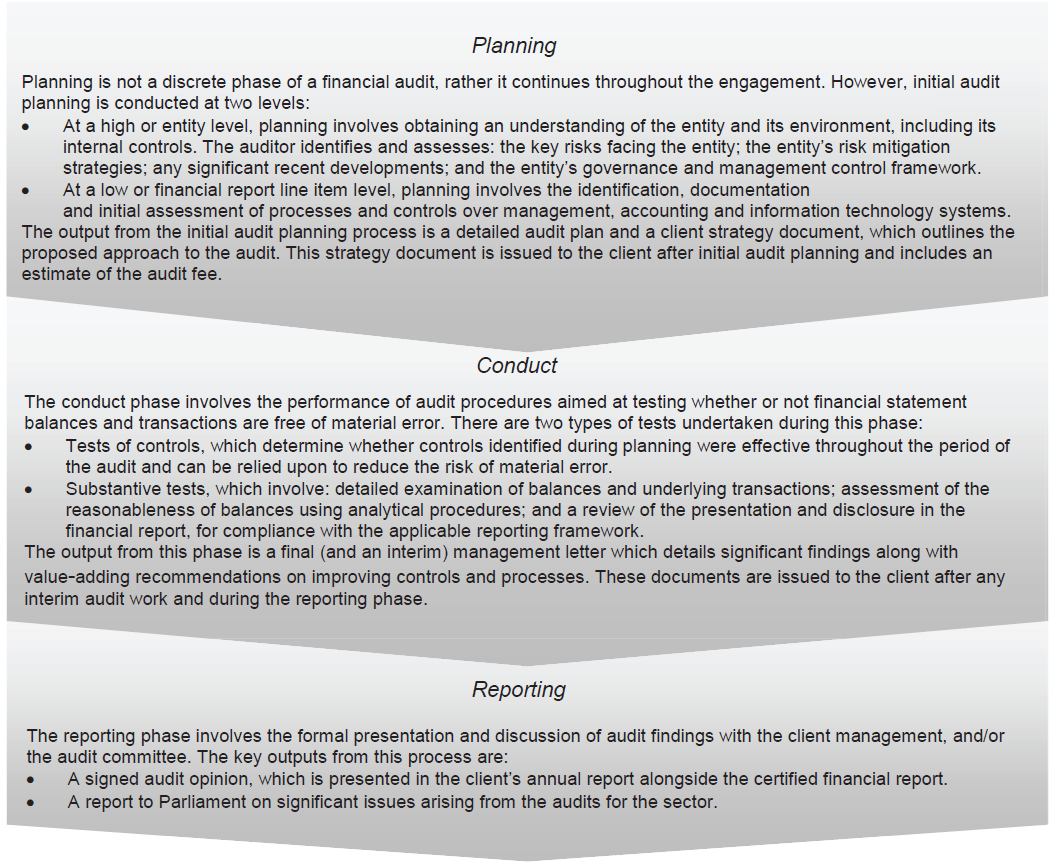
Source: Victorian Auditor-General's Office.
Internal control framework
Figure B2 identifies the main components of an effective internal control framework.
Figure B2
Components of an internal control framework
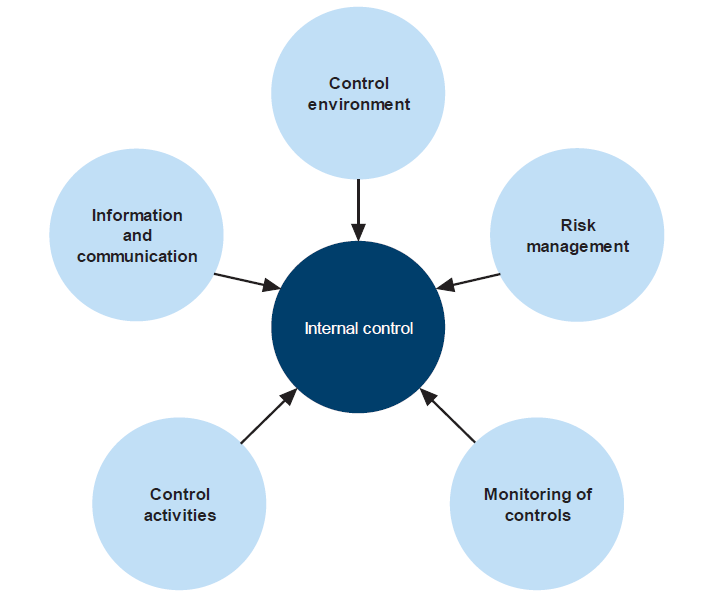
Source: Victorian Auditor-General's Office.
In the diagram:
- the control environment provides the fundamental discipline and structure for the controls, and includes governance and management functions and the attitudes, awareness, and actions of those charged with governance and management of an entity
- risk management involves identifying, analysing and mitigating risks
- monitoring of controls involves observing the internal controls in practice and assessing their effectiveness
- control activities are policies, procedures and practices prescribed by management to help meet an entity's objectives
- information and communication involves communicating control responsibilities throughout the entity and providing information in a form and time frame that allows officers to discharge their responsibilities.
The annual financial audit enables the Auditor-General to form an opinion on an entity's financial report. Integral to this, and a requirement of Australian Auditing Standard 315 Identifying and Assessing the Risks of Material Misstatement through Understanding the Entity and Its Environment, is to assess the adequacy of an entity's internal control framework and governance processes related to its financial reporting.
Internal control weaknesses we identify during an audit do not usually result in a 'qualified' audit opinion. A qualification is usually warranted only if weaknesses cause significant uncertainty about the accuracy, completeness and reliability of the financial information being reported. Often, an entity will have compensating controls that mitigate the risk of a material error in the financial report.
Weaknesses we find during an audit are brought to the attention of an entity's chairperson, managing director and audit committee by way of a management letter.
Section 16 of the Audit Act 1994 empowers the Auditor-General to report to Parliament on the results of audits. This report includes the results of our review of internal controls related to the financial reporting responsibilities of the water industry.
Financial report preparation
Our assessment of financial reporting performance against better practice was based on criteria outlined in Figure B3.
Figure B3
Financial report preparation better practice
Key area |
Better practice |
|---|---|
Financial report preparation plan |
Establish a plan that outlines the processes, resources, milestones, oversight, and quality assurance practices required in preparing the financial report. |
Preparation of shell statements |
Prepare a shell financial report and provide it to the auditors early to enable early identification of amendments, minimising the need for significant disclosure changes at year end. |
Materiality assessment |
Assess materiality, including quantitative and qualitative thresholds, at the planning phase in consultation with the audit committee. The assessment assists preparers to identify potential errors in the financial report. |
Monthly financial reporting |
Adopt full accrual monthly reporting to assist in preparing the annual financial report. This allows the year-end process to be an extension of the month-end process. |
Quality control and assurance procedures |
Require rigorous review of the supporting documentation, data and the financial report itself by an appropriately experienced and independent officer prior to providing it to the auditors. |
Supporting documentation |
Prepare high-standard documentation to support and validate the financial report and provide a management trail. |
Analytical reviews |
Undertake rigorous and objective analytical review during the financial report preparation process to help to improve the accuracy of the report. |
Reviews of controls/ self-assessment |
Establish sufficiently robust quality control and assurance processes to provide assurance to the audit committee on the accuracy and completeness of the financial report. |
Competency of staff |
The preparers of the financial report have a good understanding of, and experience in, applying relevant accounting standards and legislation. They also have effective project management and interpersonal skills. |
Financial compliance reviews |
Undertake periodic compliance reviews to identify areas of noncompliance or changes to legislation that impact the financial report. |
Adequate security |
Protect and safeguard sensitive information throughout the process to prevent inappropriate public disclosure. |
Source: Victorian Auditor-General's Office, and Australian National Audit Office Better Practice Guide Preparation of Financial Statements by Public Sector Entities, June 2009.
Performance report preparation
Our assessment of performance reporting preparation against better practice was based on criteria outline in Figure B4.
Figure B4
Performance report preparation better practice
Key area |
Better practice |
|---|---|
Performance report preparation plan |
Establish a plan that outlines the processes, resources, milestones, oversight, and quality assurance practices required in preparing the performance report. |
Preparation of shell statements |
Prepare a shell performance report and provide to the auditors early to enable early identification of amendments, minimising the need for significant disclosure changes at year end. |
Regular performance reporting |
Adopt regular reporting to assist in preparing the annual performance report. |
Quality control and assurance procedures |
Require rigorous review of the supporting documentation, data and the performance report itself, by an appropriately experienced and independent officer prior to providing it to the auditors. |
Supporting documentation |
Prepare high-standard documentation to support and validate the performance report, and provide a management trail. |
Reviews of controls/ self-assessment |
Establish sufficiently robust quality control and assurance processes to provide assurance to the audit committee on the accuracy and completeness of the performance report. |
Competency of staff |
The preparers of the performance report have a good understanding of, and experience in, applying relevant requirements and legislation. They also have effective project management and interpersonal skills. |
Performance compliance reviews |
Undertake periodic compliance reviews to identify areas of noncompliance or changes to ministerial directives that impact the performance report. |
Adequate security |
Protect and safeguard sensitive information throughout the process to prevent inappropriate public disclosure. |
Compliance with Ministerial Reporting Directive |
Aware of and prepared for the changes to the Ministerial Reporting Direction 01 Performance Reporting and had the appropriate systems and processes to capture and report on the indicators. |
Source: Victorian Auditor-General's Office.
Appendix C. Risk definitions
The rating of audit issues reflects our assessment of both the likelihood and consequence of each identified issue in terms of its impacts on:
- the effectiveness and efficiency of operations, including probity, propriety and compliance with applicable laws
- the reliability, accuracy and timeliness of financial reporting.
The rating also assists management in its prioritisation of remedial action.
Figure C1
Rating definitions and management action
Rating |
Definition |
Management action required |
|---|---|---|
Extreme |
The issue represents:
|
Requires immediate management intervention with a detailed action plan to be implemented within one month. Requires executive management to correct the material misstatement in the financial report as a matter of urgency to avoid a modified audit opinion. |
High |
The issue represents:
|
Requires prompt management intervention with a detailed action plan implemented within two months. Requires executive management to correct the material misstatement in the financial report to avoid a modified audit opinion. |
Medium |
The issue represents:
|
Requires management intervention with a detailed action plan implemented within three to six months. |
Low |
The issue represents:
|
Requires management intervention with a detailed action plan implemented within six to 12 months. |
Source: Victorian-Auditor General's Office.
Appendix D. Audit status
Financial audits – water entities
Audit types |
Financial report |
Timeliness of audited financial report completion |
Performance report |
Timeliness of audited performance report completion |
||||||
|---|---|---|---|---|---|---|---|---|---|---|
FMA |
Non-FMA |
Clear opinion issued |
Auditor-General's report signed |
Within 12 weeks |
More than 12 weeks |
Clear opinion issued |
Auditor-General's report signed |
Within 12 weeks |
More than 12 weeks |
|
COMPLETED AUDITS WITH 30 JUNE 2014 BALANCE DATES |
||||||||||
METROPOLITAN |
||||||||||
Wholesaler |
||||||||||
Melbourne Water Corporation |
● |
✔ |
29 Aug 2014 |
● |
✔ |
29 Aug 2014 |
● |
|||
Retailers |
||||||||||
City West Water Corporation |
● |
✔ |
29 Aug 2014 |
● |
✔ |
29 Aug 2014 |
● |
|||
South East Water Corporation |
● |
✔ |
25 Aug 2014 |
● |
✔ |
25 Aug 2014 |
● |
|||
Yarra Valley Water Corporation |
● |
✔ |
26 Aug 2014 |
● |
✔ |
26 Aug 2014 |
● |
|||
REGIONAL URBAN |
||||||||||
Barwon Region Water Corporation |
● |
✔ |
29 Aug 2014 |
● |
✔ |
29 Aug 2014 |
● |
|||
Central Gippsland Region Water Corporation |
● |
✔ |
29 Aug 2014 |
● |
✔ |
29 Aug 2014 |
● |
|||
Central Highlands Region Water Corporation |
● |
✔ |
29 Aug 2014 |
● |
✔ |
29 Aug 2014 |
● |
|||
Coliban Region Water Corporation |
● |
✔ |
21 Aug 2014 |
● |
✔ |
21 Aug 2014 |
● |
|||
East Gippsland Region Water Corporation |
● |
✔ |
03 Sep 2014 |
● |
✔ |
03 Sep 2014 |
● |
|||
Goulburn Valley Region Water Corporation |
● |
✔ |
01 Sep 2014 |
● |
✔ |
01 Sep 2014 |
● |
|||
Grampians Wimmera Mallee Water Corporation |
● |
✔ |
29 Aug 2014 |
● |
✔ |
29 Aug 2014 |
● |
|||
Lower Murray Urban and Rural Water Corporation |
● |
✔ |
04 Sep 2014 |
● |
✔ |
04 Sep 2014 |
● |
|||
North East Region Water Corporation |
● |
✔ |
02 Sep 2014 |
● |
✔ |
02 Sep 2014 |
● |
|||
South Gippsland Region Water Corporation |
● |
✔ |
08 Sep 2014 |
● |
✔ |
08 Sep 2014 |
● |
|||
Wannon Region Water Corporation |
● |
✔ |
29 Aug 2014 |
● |
✔ |
29 Aug 2014 |
● |
|||
Western Region Water Corporation |
● |
✔ |
02 Sep 2014 |
● |
✔ |
02 Sep 2014 |
● |
|||
Westernport Region Water Corporation |
● |
✔ |
05 Sep 2014 |
● |
✔ |
05 Sep 2014 |
● |
|||
RURAL |
||||||||||
Gippsland and Southern Rural Water Corporation |
● |
✔ |
03 Sep 2014 |
● |
✔ |
03 Sep 2014 |
● |
|||
Goulburn-Murray Rural Water Corporation |
● |
✔ |
29 Aug 2014 |
● |
✔ |
29 Aug 2014 |
● |
|||
2013–14 Total number of entities |
19 |
19 |
19 |
19 |
||||||
Per cent |
100 |
100 |
||||||||
2012–13 Total number of entities |
19 |
19 |
16* |
16* |
||||||
Per cent |
100 |
100* |
||||||||
Note: FMA – Financial
Management Act 1994
* City West Water Corporation, South East
Water Corporation and Yarra Valley Water Corporation performance reports were
not subject to audit in the 2012–13 financial year.
Source: Victorian Auditor-General's Office.
Other audit services
Entity |
Description |
Purpose |
Period |
Date of report |
|---|---|---|---|---|
Melbourne Water |
Waterways and drainage charges audit |
Audit by arrangement under section 16E of the Audit Act 1994. The audit is conducted in accordance with Australian Auditing Standard 805 Special Considerations – Audits of Single Financial Statements and Specific Elements, Accounts or Items of a Financial Statement and covers the Waterways and Drainage Charge billed, collected and remitted to Melbourne Water, as per the requirements under the Billings and Collections Services Agreements and ultimately the Water Industry Act 1994, by:
for the year ended 30 June 2014. Consideration is also given to amounts charged to Melbourne Water by the above-mentioned entities for administering the collection of the revenue. |
2013–14 |
Not finalised at the date of preparing this report |
Source: Victorian Auditor-General's Office.
Appendix E. Entity level financial sustainability risk
Indicators of financial sustainability risk
This Appendix sets out the financial indicators used in this report to gauge financial sustainability risks. The indicators should be considered collectively, and are more useful when assessed over time as part of a trend analysis. The indicators have been applied to the published financial information of the 19 water entities for the five-year period 2009–10 to 2013–14.
The analysis of financial sustainability risks in this report reflects on the position of each entity individually, and of each water sector as a category. The financial sustainability indicators used in this report are indicative and highlight risks to ongoing financial sustainability. However, forming a definitive view of any entity's financial sustainability requires a holistic analysis that moves beyond financial considerations to include the water entity's operations and environment, particularly the regulatory environment in which a water entity operates. The regulatory environment is a critical piece to understanding why the financial sustainability indicator risk results derived from the statutory financial reports of water entities are, in some cases, less than desirable.
The Essential Services Commission (ESC) is responsible for regulating and approving the price each water entity may charge its customers. Water prices are determined based on what revenue water entities require to meet service obligations and expected outcomes. The price setting process, however only takes into account costs associated with regulatory asset values, which are substantially lower than the asset values held by water entities and recorded in their statutory financial reports. This is a key factor for the regional urban and rural water entities.
The financial sustainability indicators are outlined in Figure E1.
Figure E1
Financial sustainability indicators
|
Indicator |
Formula |
Description |
|---|---|---|
|
Underlying result (%) |
Adjusted net surplus / Total underlying revenue |
A positive result indicates a surplus, and the larger the percentage, the stronger the result. A negative result indicates a deficit. Operating deficits cannot be sustained in the long term. Underlying revenue does not take into account one‑off or non-recurring transactions. Net result and total underlying revenue is obtained from the comprehensive operating statement. |
|
Liquidity |
Current assets / Current liabilities |
This measures an entity's ability to pay existing liabilities in the next 12 months. A ratio of one or more means there are more cash and liquid assets than short-term liabilities. Current liabilities exclude long-term employee provisions and revenue in advance. |
|
Interest cover |
Net operating cash flows before net interest and tax payments / Net interest payments |
This measures an entity's ability to meet ongoing interest payments and ability to service debt. Net operating cash flows and net interest and tax payments are obtained from the cash flow statement. |
|
Debt service cover |
Profit plus interest, depreciation and amortisation / Total interest and debt repayments |
This measures the ability of an entity to repay its debt from operating profits. Profit, interest, depreciation and amortisation are taken from the comprehensive operating statement. Total interest and debt repayments are taken from the cash flow statement. |
|
Debt-to-assets |
Debt / Total assets |
This is a longer-term measure that compares all current and non-current interest bearing liabilities to total assets. It complements the liquidity ratio which is a short‑term measure. A low ratio indicates less reliance on debt to finance the assets of an organisation. |
|
Self-financing (%) |
Net operating cash flows / Underlying revenue |
This measures an entity's ability to replace assets using cash generated by the entity's operations. The higher the percentage the more effectively this can be done. Net operating cash flows are obtained from the cash flow statement. |
|
Capital replacement |
Cash outflows for property, plant and equipment / Depreciation |
Comparison of the rate of spending on infrastructure with its depreciation. Ratios higher than 1:1 indicate that spending is faster than the depreciating rate. This is a long-term indicator, as capital expenditure can be deferred in the short term if there are insufficient funds available from operations, and borrowing is not an option. Cash outflows for infrastructure are taken from the cash flow statement. Depreciation is taken from the comprehensive operating statement. |
Source: Victorian Auditor-General's Office.
Financial sustainability risk assessment criteria
The financial sustainability of each water entity has been assessed using the risk criteria outlined in Figure E2.
Figure E2
Financial sustainability indicators – risk assessment criteria
|
Risk |
Underlying result |
Liquidity |
Interest cover |
Debt service cover |
Debt-to-assets |
Self-financing |
Capital replacement |
|---|---|---|---|---|---|---|---|
|
High |
Negative 10% or less Insufficient revenue is being generated to fund operations and asset renewal. |
Less than 0.7 Immediate sustainability issues with insufficient current assets to cover liabilities. |
Less than 1.0 Insufficient interest cover to meet ongoing interest payments. |
Less than 0.9 Insufficient operating profit to meet debt and interest repayments. |
More than 1.0 Long-term concern over ability to repay debt. |
Less than 10% Insufficient cash from operations to fund new assets and asset renewal. |
Less than 1.0 Spending on capital works has not kept pace with consumption of assets. |
|
Medium |
Negative 10%–0% A risk of long‑term run down to cash reserves and inability to fund asset renewals. |
0.7–1.0 Need for caution with cash flow, as issues could arise with meeting obligations as they fall due. |
1.0–2.0 May not be able to service debt as interest payments fall due. |
0.9–1.0 May indicate concerns over the ability to repay debt. |
0.5–1.0 May indicate concerns over the ability to repay the debt. |
10–20% May not be generating sufficient cash from operations to fund new assets. |
1.0–1.5 May indicate spending on asset renewal is insufficient. |
|
Low |
More than 0% Generating surpluses consistently. |
More than 1.0 No immediate issues with repaying short‑term liabilities as they fall due. |
More than 2.0 Low risk of debt servicing issues. |
More than 1.0 Low risk over ability to repay debt. |
Less than 0.5 Low risk over repaying debt from own source revenue. |
More than 20% Generating enough cash from operations to fund new assets. |
More than 1.5 Low risk of insufficient spending on asset renewal. |
Source: Victorian Auditor-General's Office.
The overall financial sustainability risk assessment has been calculated using the ratings determined for each indicator as outlined in Figure E3. A trend has also been determined for each ratio by entity and the sector.
Figure E3
Overall financial sustainability risk assessment
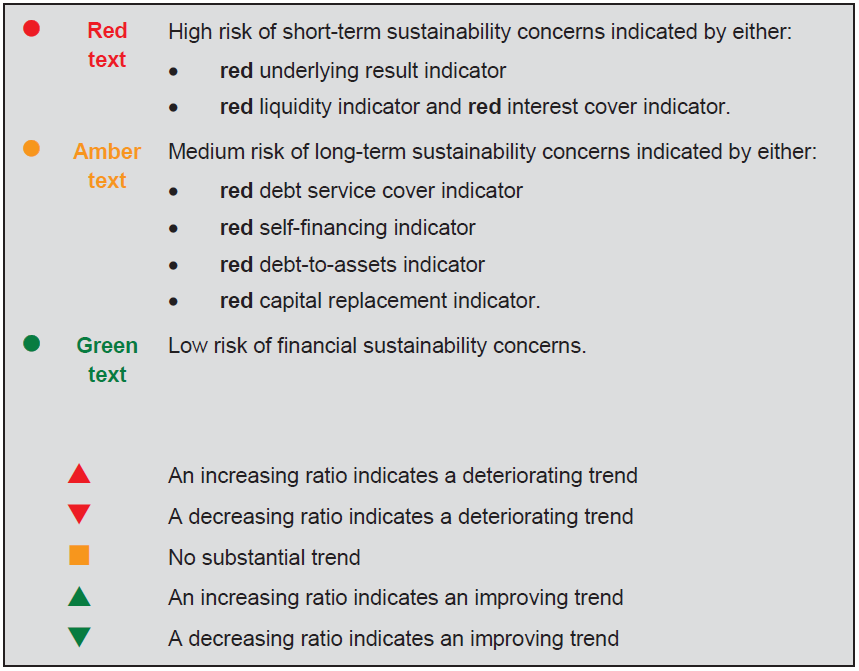
Source: Victorian Auditor-General's Office.
Metropolitan
Wholesaler
Figure E4
Melbourne Water

Note: In relation to the debt service cover indicator, in past reports and the current year, we have calculated the indicator result using the debt repayment figure from the signed financial report (cash flow statement) of Melbourne Water. This figure includes refinancing of debt, which has impacted the results and trend of the indicator over the period, and the overall sustainability assessment. As highlighted in Part 5.3.8 Financial Sustainability indictors and future approach, during the 2014–15 year we plan to perform a review of the relevance of all financial sustainability indicators, including the debt service cover indicator.
Source: Victorian Auditor-General's Office.
Retailers
Figure E5
City West Water

Source: Victorian Auditor-General's Office.
Figure E6
South East Water

Source: Victorian Auditor-General's Office.
Figure E7
Yarra Valley Water

Source: Victorian Auditor-General's Office.
Figure E8
Metropolitan average

Source: Victorian Auditor-General's Office.
Regional urban
Figure E9
Barwon Water

Source: Victorian Auditor-General's Office.
Figure E10
Central Highlands Water

Source: Victorian Auditor-General's Office.
Figure E11
Coliban Water

Source: Victorian Auditor-General's Office.
Figure E12
East Gippsland Water

Source: Victorian Auditor-General's Office.
Figure E13
Gippsland Water

Source: Victorian Auditor-General's Office.
Figure E14
Goulburn Valley Water

Source: Victorian Auditor-General's Office.
Figure E15
GWMWater

Source: Victorian Auditor-General's Office.
Figure E16
Lower Murray Water

Source: Victorian Auditor-General's Office.
Figure E17
North East Water

Source: Victorian Auditor-General's Office.
Figure E18
South Gippsland Water

Source: Victorian Auditor-General's Office.
Figure E19
Wannon Water

Source: Victorian Auditor-General's Office.
Figure E20
Western Water

Source: Victorian Auditor-General's Office.
Figure E21
Westernport Water

Note: N/A – interest received exceeds interest paid.
Source: Victorian Auditor-General's Office.
Figure E22
Regional urban average

Source: Victorian Auditor-General's Office.
Rural
Figure E23
Goulburn-Murray Water

Note: N/A – interest received exceeds interest paid.
Source: Victorian Auditor-General's Office.
Figure E24
Southern Rural Water

Note: N/A – interest received exceeds interest paid.
Source: Victorian Auditor-General's Office.
Figure E25
Rural average

Note: N/A – interest received exceeds interest paid.
Source: Victorian Auditor-General's Office.
Appendix F. Performance reporting
Financial indicators
Indicator |
Indicator |
Metropolitan |
Metropolitan |
Regional |
Rural |
|---|---|---|---|---|---|
F1 |
Cash interest cover |
✔ |
✔ |
✔ |
✔ |
F2 |
Gearing ratio |
✔ |
✔ |
✔ |
✔ |
F3 |
Internal financing ratio |
✔ |
✔ |
✔ |
✔ |
F4 |
Current ratio |
✔ |
✔ |
✔ |
✔ |
F5 |
Return on assets |
✔ |
✔ |
✔ |
✔ |
F6 |
Return on equity |
✔ |
✔ |
✔ |
✔ |
F7 |
EBITDA margin |
✔ |
✔ |
✔ |
✔ |
Total |
7 |
7 |
7 |
7 |
Note: ✔ Performance indicator included in the performance report. EBITDA—Earnings before interest, tax, depreciation and amortisation
Source: Victorian Auditor-General's Office.
Non-financial indicators
Indicator Number |
Indicator |
Metropolitan |
Metropolitan |
Regional |
Rural |
|---|---|---|---|---|---|
Water and sewerage services |
|||||
WS1 |
Unplanned water supply interruptions |
✔ |
✔ |
||
WS2 |
Interruption time |
✔ |
✔ |
||
WS3 |
Restoration of unplanned water supply |
✔ |
✔ |
||
WSR1 |
Rural water supply deliveries |
✔ |
|||
WSR2 |
Unavailability of Domestic and Stock supply |
✔ |
|||
WSR3 |
Groundwater supply |
✔ |
|||
SS1 |
Containment of sewer spills |
✔ |
✔ |
||
SS2 |
Sewer spills interruptions |
✔ |
✔ |
||
WQ1 |
Water quality—compliance with BWSA: Microbiological Standards–E.coli |
✔ |
|||
WQ2 |
Water quality—compliance with BWSA: Aesthetics–Turbidity |
✔ |
|||
CRM1 |
Customer responsiveness |
✔ |
|||
EM1 |
Non-compliance with EPA Victoria Corporate License
and SEPP parameters—Sewerage system failure |
✔ |
|||
EM2.1 |
Non-compliance with EPA Victoria Corporate License effluent discharge parameters—Western Treatment Plant |
✔ |
|||
EM2.2 |
Non-compliance with EPA Victoria Corporate License effluent discharge parameters—Eastern Treatment Plant |
✔ |
|||
WW1 |
Waterways—drainage and flood protection |
✔ |
|||
WW2 |
Waterways condition |
✔ |
|||
RW1.1 |
Recycled water—WTP recycled water schemes—volume demands |
✔ |
|||
RW1.2 |
Recycled water—WTP recycled water schemes—reliability |
✔ |
|||
RW1.3 |
Recycled water—WTP recycled water schemes—quality
|
✔ |
|||
RW2.1 |
Recycled water—ETP recycled water schemes—volume
demands |
✔ |
|||
RW2.2 |
Recycled water—ETP recycled water schemes—reliability |
✔ |
|||
RW2.3 |
Recycled water—ETP recycled water schemes—quality |
✔ |
|||
GG1 |
Greenhouse gases Greenhouse gas emissions offset |
✔ |
|||
Total water and sewerage services |
15 |
5 |
5 |
3 |
|
Appendix G. Acronyms and glossary
Acronyms
AAS | Australian Auditing Standard |
AASB | Australian Accounting Standards Board |
DEPI | Department of Environment and Primary Industries (former) |
DELWP | Department of Environment, Land, Water and Planning |
DTF | Department of Treasury and Finance |
ESC | Essential Services Commission |
FAL | Financial Accommodation Levy |
FMA | Financial Management Act 1994 |
FRD | Financial Reporting Direction |
MRD | Ministerial Reporting Direction |
NTER | National Tax Equivalent Regime |
RAV | Regulatory Asset Value |
REV | Regulatory Expenditure Value |
SAV | Statutory Asset Value |
SEV | Statutory Expenditure Value |
VAGO | Victorian Auditor-General's Office |
VCAT | Victorian Civil and Administrative Tribunal |
VGV | Valuer-General Victoria |
WIRO | Water Industry Regulatory Order |
Glossary
Accountability
Responsibility of public sector entities to achieve their objectives, with regard to reliability of financial reporting, effectiveness and efficiency of operations, compliance with applicable laws, and reporting to interested parties.
Amortisation
The systematic allocation of the depreciable amount of an intangible asset over its expected useful life.
Asset
A resource controlled by an entity as a result of past events, and from which future economic benefits are expected to flow to the entity.
Asset useful life
The period over which an asset is expected to provide the entity with economic benefits. Depending on the nature of the asset, the useful life can be expressed in terms of time or output.
Asset valuation
The fair value of a non-current asset on a specified date.
Audit Act 1994
The Audit Act 1994 establishes the operating powers and responsibilities of the Auditor-General. This includes the operations of his office—the Victorian Auditor‑General's Office (VAGO) as well as the nature and scope of audits conducted by VAGO.
Audit committee
Assists a governing board to fulfil its governance and oversight responsibilities, and strengthen accountability of senior management.
Audit committee charter
The responsibilities and terms of reference of the audit committee should be clearly defined in its charter, formally approved by the governing board and communicated to stakeholders.
Auditor's opinion
Written expression within a specified framework indicating the auditor's overall conclusion on the fair presentation of the financial (and performance) report based on audit evidence obtained.
Benefits
Preferential treatment, privileged access, favours or other advantage offered. While their value may sometimes be difficult to quantify in dollars, they may be highly valued by the intended recipient and therefore used to influence their behaviour.
Capital expenditure
Amount capitalised to the balance sheet for contributions by a public sector entity to major assets owned by the entity, including expenditure on:
- capital renewal of existing assets that returns the service potential or the life of the asset
- new assets, including buildings, infrastructure, plant and equipment.
Clear audit opinion – financial report
A positive written expression provided when the financial report has been prepared and presents fairly the transactions and balances for the reporting period in accordance with the requirements of the relevant legislation and Australian accounting standards.
Also referred to as an unqualified audit opinion.
Clear audit opinion – performance report
A positive written expression provided when the performance report has been prepared and presents fairly the performance indicators and results of performance for the reporting period in accordance with the requirements of the relevant legislation.
Also referred to as an unqualified audit opinion.
Corporations Act 2001
An act of the Commonwealth of Australia that sets out the laws dealing with business entities in Australia at federal and state levels. It focuses primarily on companies, although it also covers some laws relating to other entities such as partnerships and managed investment schemes.
Depreciation
The systematic allocation of the value of an asset over its expected useful life.
Emphasis of matter
An auditor's report can include an emphasis of matter paragraph that draws attention to a disclosure or item in the financial report that is relevant to the users of the auditor's report but is not of such nature that it affects the auditor's opinion—i.e. the auditor's opinion remains unmodified.
Entity
A body whether corporate or unincorporated that has a public function to exercise on behalf of the state or is wholly owned by the state, including: departments, statutory authorities, statutory corporations and government business enterprises.
Equity or net assets
Residual interest in the assets of an entity after deduction of its liabilities.
Ex-gratia expenses
The voluntary payment of money or other non-monetary benefit—e.g. a write-off—that is not made either to acquire goods, services or other benefits for the entity or to meet a legal liability, or to settle or resolve a possible legal liability of or claim against the entity.
Expense
Outflows or other depletions of economic benefits in the form of incurrence or liabilities or depletion of assets of the entity.
Fair value
The price that would be received to sell an asset or paid to transfer a liability in an orderly transaction between market participants at the measurement date.
Financial accommodation levy
Applied to government-owned entities declared to be leviable authorities under the Financial Management Act 1994.
The purpose of the levy is to remove the market advantage government entities may experience in borrowing, as a result of their sovereign status, thereby ensuring that borrowings are valued appropriately in financing decisions for capital projects.
The levy can be payable where borrowings are greater than $5 million.
Financial Management Act 1994
The Act of the State of Victoria that establishes the financial administration and accountability of the public sector, as well as annual reporting to the Parliament by all departments and public sector bodies.
Financial delegation
A schedule that specifies the level or approval required for each transaction category to facilitate the execution of functions necessary for the efficient operation of the entity.
Financial report
Structured representation of financial information, which usually includes accompanying notes, derived from accounting records and intended to communicate an entity's economic resources or obligations at a point in time or the changes therein for a period in accordance with a financial reporting framework.
Financial reporting direction
Financial reports are prepared in accordance with Australian Accounting Standards and Interpretations as issued by the Australian Accounting Standards Board (AASB). When an AASB standard provides accounting treatment options, the Minister for Finance issues financial reporting directions to ensure consistent application of accounting treatment across the Victorian public sector in compliance with that particular standard.
Financial sustainability
An entity's ability to manage financial resources so it can meet spending commitments, both at present and into the future.
Financial year
The period of 12 months for which a financial report—and performance report—is prepared.
Gifts
Are free or heavily discounted items, intangible benefits or hospitality exceeding common courtesy that are offered to employees in association with their work. Gifts may also be provided by organisations. They range in value from nominal to significant and may be given for different reasons.
Going concern
An entity which is expected to be able to pay its debts as and when they fall due, and continue in operation without any intention or necessity to liquidate or otherwise wind up its operations.
Hospitality
The friendly reception and treatment of guests, ranging from offers of light refreshment at a business meeting to restaurant meals and sponsored travel and accommodation. Hospitality may be offered to a public sector employee or provided by public sector organisations.
Hybrid price cap
A water entity can use a price cap but can also apply to the ESC for a tariff basket during the regulatory period.
Hybrid revenue cap
A water entity can use a revenue cap but can also apply to the ESC for a tariff basket during the regulatory period.
Independent auditor's report
An expression of the independent auditor's opinion on an entity's financial or performance report.
Internal audit
A function of an entity's governance framework that examines and reports to the governing body and management on the effectiveness of risk management, control and governance processes.
Internal control
A means by which an entity's resources are directed, monitored and measured. It plays an important role in preventing and detecting error and fraud and protecting the entity's resources.
Liability
A present obligation of the entity arising from past events, the settlement of which is expected to result in an outflow from the entity of resources embodying economic benefits.
Materiality
Information is material if its omission of misstatement could influence the economic decisions of users taken on the basis of the financial report. Materiality depends on the size or nature of the item or error judged in the particular circumstances of its omission or misstatement.
Net result
The net result is calculated by subtracting an entity's total expenses from the total revenue, to show what the entity has earned or lost in a given period of time.
Non-reciprocal
Transfers in which an entity receives assets without directly giving equal value in exchange to the other party to the transfer.
Performance report
A statement containing predetermined performance indicators and targets and actual results achieved against these for that financial year, with an explanation for any significant variance between the results and targets.
Price cap
An imposed limit on how high a price is charged for a product.
Relevant
Measures or indicators used by an entity are relevant if they have a logical and consistent relationship to an entity's objectives and are linked to the outcomes to be achieved.
Revaluation
Recognising a reassessment of values for non-current assets at a particular point in time.
Revenue
Inflows of funds or other enhancements or savings in outflows of service potential, or future economic benefits in the form of increases in assets or reductions in liabilities of the entity, other than those relating to contributions by owners which result in an increase in equity during the reporting period.
Revenue cap
An approved maximum amount of revenue that a business is allowed to collect in each year of the regulatory period.
Tariff basket
A form of price control that allows flexibility for the water entity to change tariffs within a regulatory period. However, the weighted average price change across all the water entity's tariffs must not exceed an approved overall percentage price change over the regulatory period.
Unqualified audit opinion – financial report
A positive written expression provided when the financial report has been prepared and presents fairly the transactions and balances for the reporting period in accordance with the requirements of the relevant legislation and Australian accounting standards.
Also referred to as a clear audit opinion.
Unqualified audit opinion – performance report
A positive written expression provided when the performance report has been prepared and presents fairly the performance indicators and results of performance for the reporting period in accordance with the requirements of the relevant legislation.
Also referred to as a clear audit opinion.
Water Plan
A document prepared and published by a water business, setting out the services, key projects and prices that the business proposes to deliver over the regulatory period.
Appendix H. Audit Act 1994 section 16—submissions and comments
Introduction
In accordance with section 16(3) of the Audit Act 1994 a copy of this report, or relevant extracts from the report, were provided to all water entities, the Department of Environment, Land, Water and Planning, the Essential Services Commission and the Victoria Water Industry Association (VicWater), with a request for submissions or comments.
The submission and comments provided are not subject to audit nor the evidentiary standards required to reach an audit conclusion. Responsibility for the accuracy, fairness and balance of those comments rests solely with the agency head.
Responses were received as follows:
- Department of Environment, Land, Water and Planning
- Essential Services Commission
- Goulburn-Murray Water
- GWMWater
Further audit comments:
- Acting Auditor-General's response to the Essential Services Commission
- Acting Auditor-General's response to Goulburn-Murray Water
- Acting Auditor-General's response to GWMWater
RESPONSE provided by the Secretary, Department of Environment, Land, Water and Planning
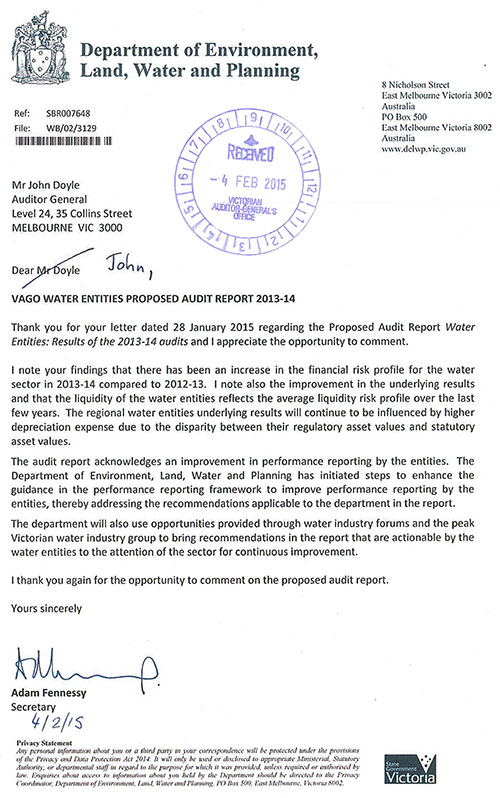
RESPONSE provided by the Chief Executive Officer, Essential Services Commission
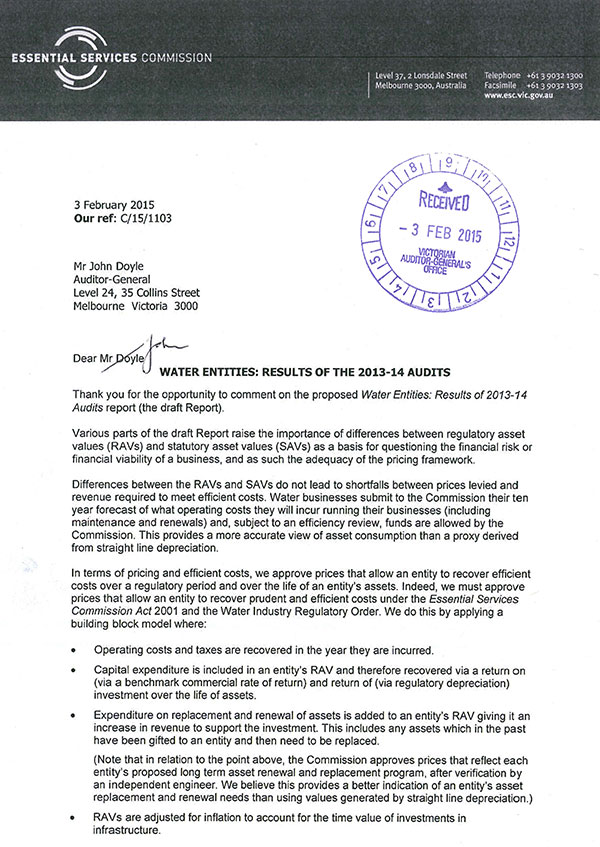
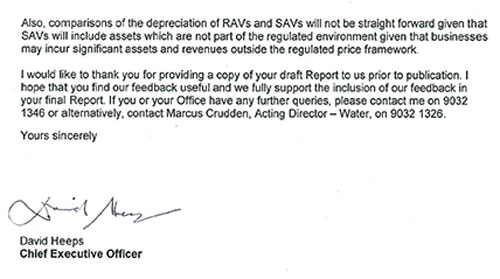
Acting Auditor-General's response to the Essential Services Commission
The Chief Executive Officer of the Essential Services Commission states that the prices it approves allow water entities to recover their efficient costs. However, as shown in our report, there is a shortfall between the price set and the total operating costs of water entities due to the adoption of substantially lower asset values in the regulatory price setting process. I note that the Secretary of the Department of Environment, Land, Water and Planning, in responding to this report, highlights the disparity between the regulatory asset values and statutory asset values and that this will continue to influence the underlying results of water entities.
RESPONSE provided by the Acting Chief Financial Officer, Goulburn-Murray Water
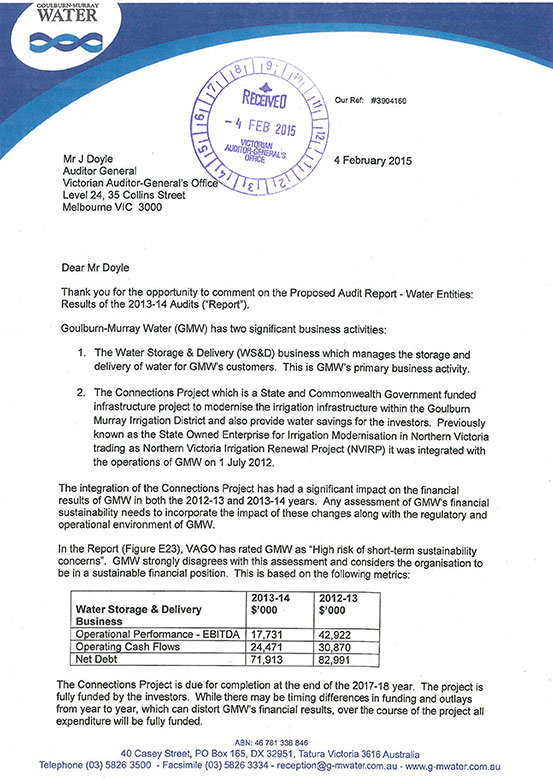
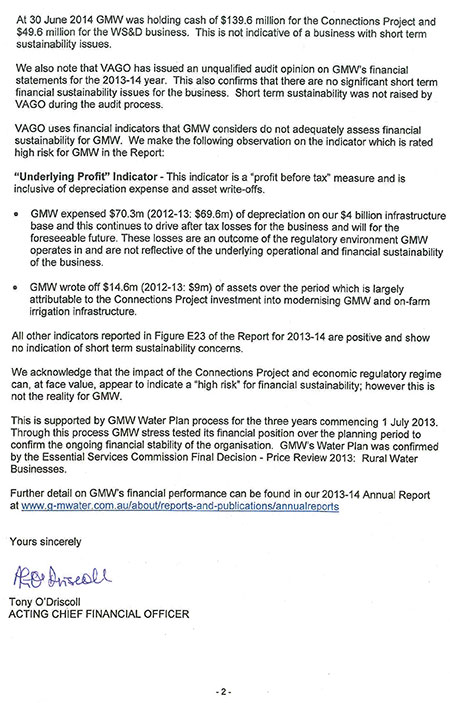
Acting Auditor-General's response to Goulburn‑Murray Water
While I disagree with Goulburn-Murray Water's conclusions, I note that it acknowledges its ongoing operating losses and that they are an outcome of the regulatory environment. This underpins the financial sustainability risks correctly identified in our report.
Further, the issue of an unqualified opinion includes an assessment of the validity of the going concern assumption for financial reporting purposes. It does not comment on financial sustainability risks.
RESPONSE provided by the Managing Director, GWMWater
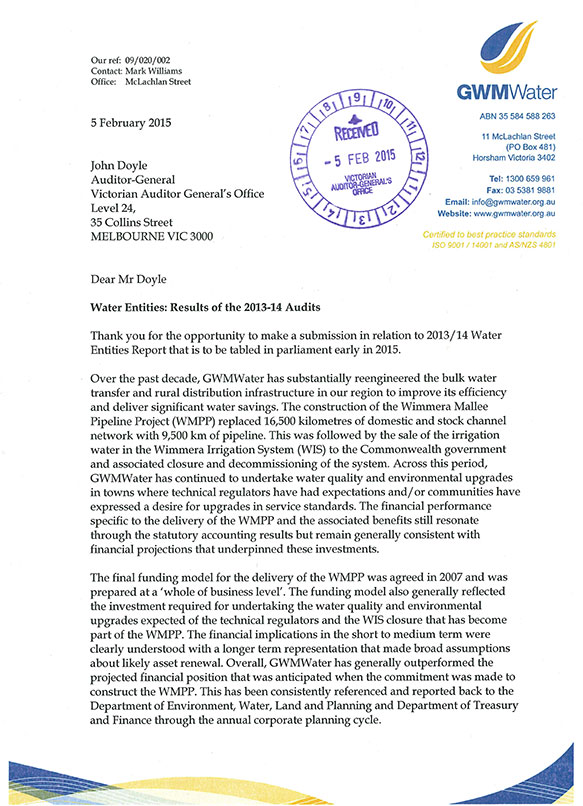
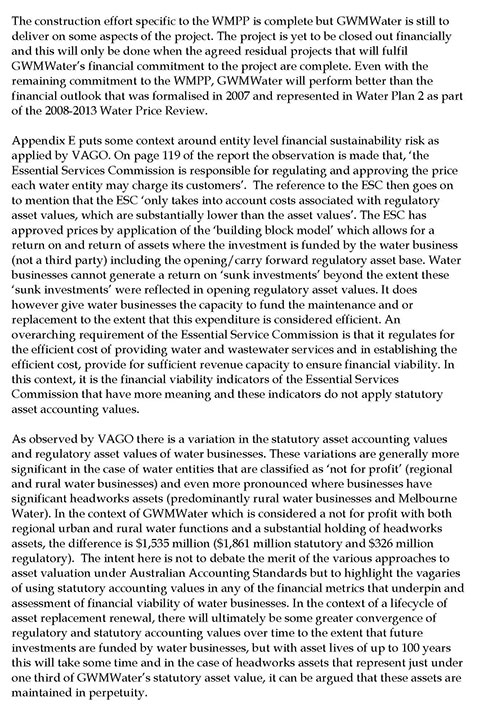
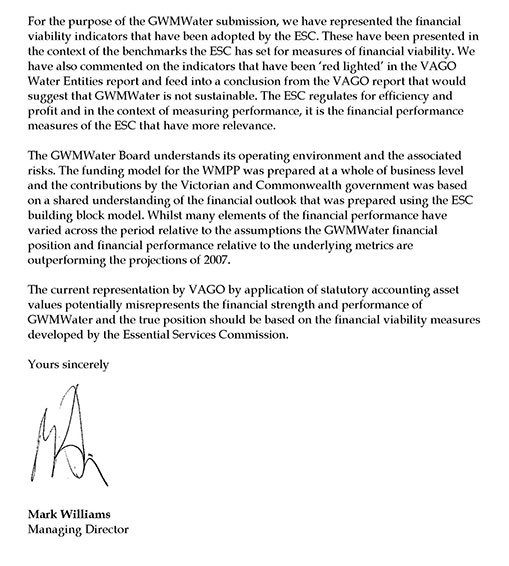
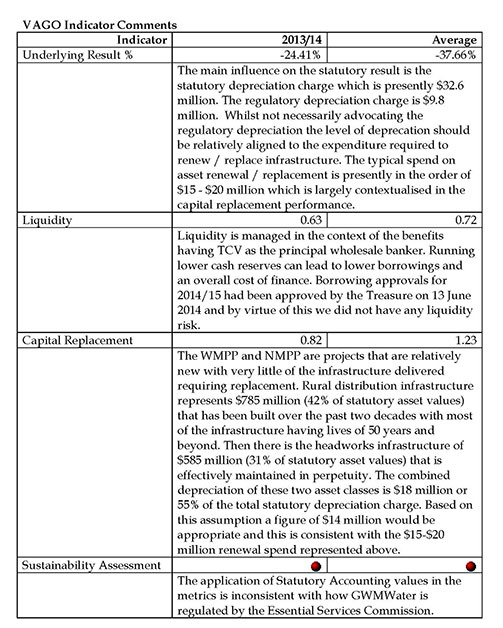
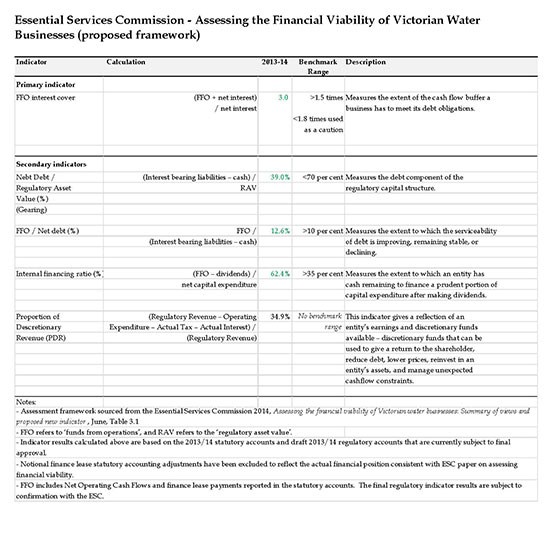
Acting Auditor-General's response to GWMWater
The Managing Director has stated that our financial sustainability indicators potentially misrepresent the financial strength and performance of GWMWater. This is incorrect. Our financial sustainability indicators are based on the published financial statements of GWMWater, which have been prepared in accordance with the Australian Accounting Standards. Further, our indicators include ratios that are accepted around the world as valid indicators of financial sustainability risks and should be interpreted as set out in our report.
